

What is a Sloop? Definition, Types and History
A sloop is a type of sailboat that has a single mast and a fore-and-aft rig.
Sloops are a type of sailboat that has been around for centuries. They are known for their versatility and ease of handling, making them popular among sailors of all skill levels. Sloops have a single mast and a fore-and-aft rig that allows for efficient sailing in a variety of wind conditions, making them an excellent choice for both cruising and racing.
Sloops are designed to be easy to handle, even for novice sailors. The simple rigging system means that there are fewer lines to manage than on other types of sailboats, which makes it easier to focus on sailing the boat. This simplicity also means that sloops require less maintenance than other boats, which can save you time and money in the long run.
One of the great things about sloops is how versatile they are. They can be used for everything from day sailing to long-distance cruising to racing. Their design allows them to sail efficiently in a wide range of wind conditions, from light breezes to strong winds. This versatility makes them an excellent choice for sailors who want a boat that can do it all.
The Versatile and Popular Sloop Sailboat Rig
Single mast and fore-and-aft rig.
A sloop is a type of sailboat that has a single mast and a fore-and-aft rig. This means that the sails are positioned parallel to the length of the boat, making it easier for sailors to control the direction of the boat. The simplicity and versatility of the sloop rig make it one of the most popular sailboat rigs in use today.
Mainsail and Headsail
The mainsail is the largest sail on a sloop, and it is attached to the mast and boom. It provides power to move the boat forward. The headsail, which is also known as a jib or genoa, is attached to the forestay and helps to control the boat’s direction by creating lift. Together, these two sails work together to provide speed and maneuverability.
A sloop is typically crewed by one or two sailors, although larger sloops may require more crew members to handle the sails and other equipment. The size of a sloop can vary greatly, from small dinghies used for recreational sailing to large ocean-going vessels used for racing or long-distance cruising.
Variations of Sloops
Bermuda-rigged sloop.
The Bermuda-rigged sloop is a classic design that has been around for centuries. It features a mainsail and a jib, which is a type of headsail. This design is popular among sailors because it is easy to handle and provides good performance in a wide range of wind conditions.

One of the advantages of the Bermuda rig is that it allows for more headsails to be used than other types of rigs, such as ketches or schooners. This means that sailors can adjust their sails to match changing wind conditions, giving them greater control over their sailing vessel.
Another advantage of the Bermuda rig is its simplicity. The sail plan is relatively easy to set up and maintain, making it an ideal choice for beginners or those who prefer a minimalist approach to sailing.
Gunter-Rigged Sloop
The Gunter-rigged sloop is another traditional design that has been around for centuries. It features a mainsail and a jib, but instead of using a masthead rig like the Bermuda sloop, it uses a gaff rigged mast with an additional spar called the gaff topsail.
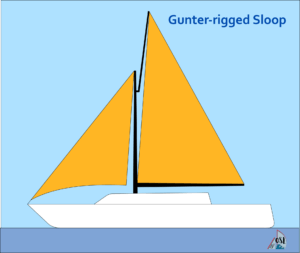
This design was popular in the 19th century because it allowed sailors to carry more sail area without having to use taller masts. However, it fell out of favor in the early 20th century when newer designs were developed that provided better performance.
Despite this, there are still some sailors who prefer the Gunter rig because of its traditional look and feel. It can also be easier to handle than some other types of rigs because the sails are smaller and lighter.
Gaff-Rigged Sloop
The gaff-rigged sloop is similar to the Gunter rig in that it uses a gaff rigged mast with an additional spar called the gaff topsail. However, it also features a headsail like the Bermuda rig.

In the past, boats commonly used gaff rigged sails, but now they have mostly been replaced by Bermuda rig sails. These newer sails are simpler than the gaff rig and allow boats to sail closer to the wind.
Spritsail Sloop
The spritsail sloop is one of the simplest rigs available. It features a single sail called the spritsail, which is attached to a spar called the sprit. This design was popular among fishermen and other working boats because it was easy to set up and maintain.

Although not as popular as before, some sailors still prefer the simplicity of a spritsail rig. It’s a great option for those who want to focus on sailing without the added complexity of multiple lines or sail plans. This type of rig is also suitable for beginner sailors and those who want an easy-to-handle boat.
The Origin of the Word Sloop
The word “sloop” is believed to have originated from the Dutch word “sloep”, which means a small boat used for fishing or transportation. The Dutch were known for their seafaring skills and had a significant influence on maritime culture in Europe during the 17th century. As such, it’s no surprise that many nautical terms used today have Dutch origins.
In fact, the sloop was initially developed in Holland during the 16th century as a small, single-masted vessel used primarily for fishing and coastal trading. These boats were highly maneuverable and could navigate shallow waters with ease, making them ideal for use in Holland’s many canals and waterways.
As Dutch sailors began to explore further afield, they brought their sloops with them, using them as auxiliary vessels to transport goods and personnel between larger ships and shore. Over time, sloops evolved into larger vessels capable of longer voyages and more extensive cargo capacity.
History of Sloops
Sloops have been a popular type of ship for centuries, with their unique rigging and hull design allowing for greater speed and maneuverability compared to other vessels. Let’s take a closer look at the history of sloops and how they have evolved over time.
17th Century: The Birth of Sloops
Sloops first emerged in the 17th century as small, fast ships used for coastal trading and piracy. Their single mast and fore-and-aft sail plan allowed them to navigate shallow waters with ease, making them ideal for smuggling goods or evading authorities. Despite their reputation as pirate ships, sloops were also used by legitimate traders due to their speed and efficiency.
18th Century: Sloops in War
In the 18th century, sloops became increasingly popular among naval forces due to their speed and agility. The British Royal Navy used sloops as dispatch vessels and reconnaissance ships during times of war. Pirates and privateers also favored sloops due to their ability to outrun larger vessels. As a result, the term “sloop-of-war” was coined to describe a small warship with a single mast and crew of around 75 men.

19th Century: Racing Sloops
The 19th century saw the rise of yacht racing, with sloops becoming a popular choice among sailors due to their versatility and ease of handling. In fact, the first recorded yacht race took place in 1826 between two sloops on the Hudson River. Sloops continued to be used for racing throughout the century, with improvements in rigging and hull design leading to faster vessels.
Modern Times: Versatile Sloops
Today, sloops are still widely used for racing and cruising due to their versatility. They are often chosen by recreational sailors who want an easy-to-handle vessel that can navigate both shallow coastal waters and open seas. Modern sloops come in various sizes, from small day-sailers to larger cruising boats. Some sloops even incorporate multiple masts, such as the ketch rig , which features a smaller mizzen mast behind the main mast.
Advantages of a Sloop
Single mast: easier to handle and maneuver.
Sloops are popular sailboats that have a single mast, which makes them easier to handle and maneuver compared to other sailboat types. The simplicity of the sloop rig means that it requires less maintenance and is generally less expensive to maintain compared to other sailboat types. With only one mast, there are fewer lines and sails to manage, making it easier for sailors who are new to sailing or those who prefer a simpler setup.
The single mast design also allows for better visibility on the water since there is no obstruction from multiple masts or rigging. This feature is especially useful when sailing in crowded waters where you need to keep an eye out for other boats or obstacles.
Faster Sailing and Closer to the Wind
Another advantage of sloops is their speed. Sloops are generally faster than other sailboat types due to their streamlined design with fewer sails. The Bermuda sloop, for example, has a triangular mainsail and one or more headsails, allowing it to move quickly through the water with minimal drag.
Sloops can also sail closer to the wind than most other sailboats. This means they can tack (sail against the wind) more efficiently, allowing them to cover more ground in less time. The ability of a sloop’s sails to be adjusted easily helps in this regard as well.
Wide Variety Available
As the most popular contemporary boat, sloops are available in a wide variety. They come in different sizes and designs suitable for various purposes such as racing, cruising, or day sailing. Some sloops even have additional sails like mizzenmast or more headsails which make them more versatile.
For instance, some sloops have a mizzenmast located aft of the mainmast which provides additional support for larger boats during heavy winds. Other sloops may have multiple headsails that allow them greater flexibility when adjusting to different wind conditions. These additional sails can make a sloop more expensive to maintain, but they also provide greater versatility and options for the sailor.
Disadvantages of a Sloop
Limited sail options in heavy weather conditions.
Sloops are known for their simplicity and ease of handling, but they have some disadvantages that sailors should be aware of. One of the biggest drawbacks is the limited sail options in heavy weather conditions. Sloops typically have a single forestay that supports the mast, which means that they can only fly one headsail at a time. This can be problematic when sailing upwind in strong winds or heavy seas.
In these conditions, it’s often necessary to reduce sail area to maintain control and prevent damage to the boat or rigging. With a sloop, this usually means taking down the headsail and relying on the mainsail alone. While this can work well in moderate wind conditions, it may not provide enough power or stability in stronger winds.
Difficulty in Handling Larger Sails Alone
Another disadvantage of sloops is that they can be difficult to handle when sailing with larger sails alone. As mentioned earlier, sloops rely on a single forestay to support the mast and headsail. When you increase the size of the sail, you also increase the load on the forestay and rigging.
This means that you may need additional crew members to help manage larger sails safely. If you’re sailing solo or with a small crew, this can make it challenging to get the most out of your boat without putting yourself at risk.
Higher Loads on Mast and Rigging Due to Single Forestay Design
The single forestay design used by sloops also puts higher loads on both the mast and rigging compared to other sailboat designs. The forestay is responsible for supporting not only the headsail but also part of the mast itself.
This means that any stress placed on the headsail or rigging will be transferred directly to the mast through this single point of attachment. Over time, this can lead to fatigue and wear on both the mast and rigging components.
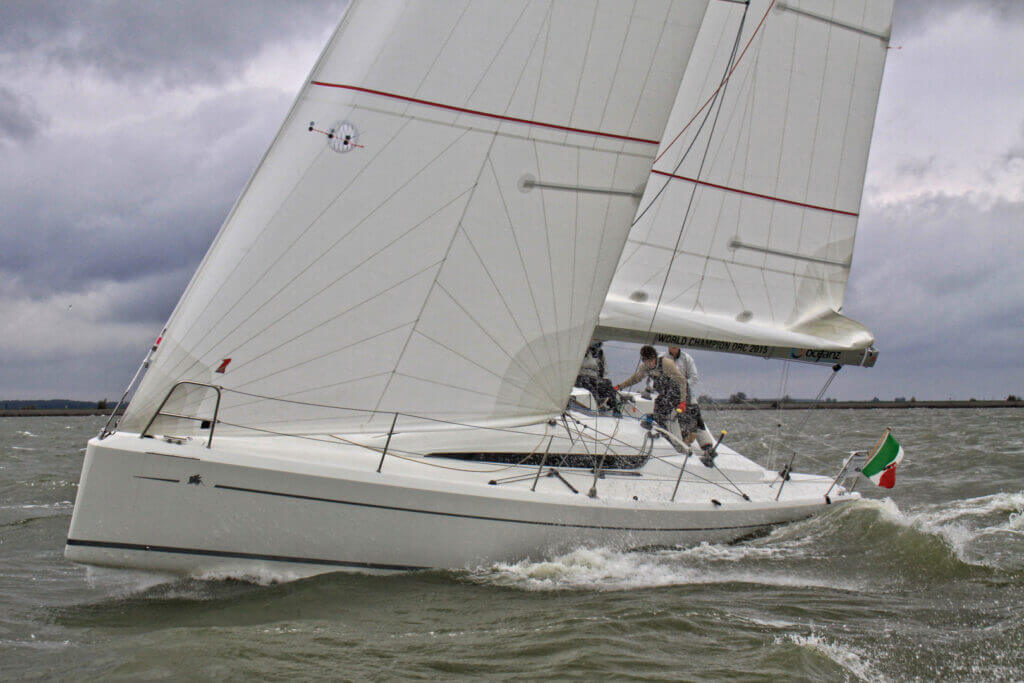
Increased Risk of Broaching in Strong Winds
Sloops are also more prone to broaching in strong winds compared to other sailboat designs. Broaching occurs when a boat is hit by a large wave or gust of wind from the side, causing it to heel over and potentially capsize.
Because sloops have a smaller cockpit and rely on a single forestay for support, they may be more susceptible to this type of event. This can be especially dangerous if you’re sailing in rough conditions or offshore where rescue may not be immediately available.
Reduced Stability Compared to Other Sailboat Designs
Another disadvantage of sloops is that they offer reduced stability compared to other sailboat designs. Sloops typically have a narrower beam and less ballast than other boats of similar size, which can make them feel less stable in heavy seas or choppy water.
This lack of stability can also affect your ability to maintain course and steer accurately, especially when sailing upwind or in challenging conditions. It’s important to understand the limitations of your boat and adjust your sailing style accordingly.
Conclusion: What is a Sloop?
With just one mast and a fore-and-aft rig, sloops are known for their simplicity and versatility. These characteristics make them an excellent choice for sailors of all levels. Whether you’re a seasoned sailor or just starting out, you’ll find that the design of a sloop allows for easy handling and maneuverability.
The single mast on a sloop is typically located towards the front of the boat. This placement provides several advantages when sailing upwind, the sail can be adjusted easily to maintain an optimal angle with respect to the wind. This is because there is only one sail to worry about, unlike other types of boats that may have multiple sails.
Similarly, when sailing downwind, a sloop’s sail can be adjusted quickly to take advantage of any changes in wind direction or speed. This flexibility makes it possible to navigate challenging weather conditions with ease.
External Links, See Also
For those looking for more technical information on sloops and other types of sailboats, the Boatdesign.net forum is an excellent resource. Here you can find discussions on everything from mast design to hull construction.
Finally, if you’re looking for some great books on sailing and sailboat design, be sure to check out “The Elements of Seamanship” by Roger C. Taylor or “Sailing Alone Around the World” by Joshua Slocum.
Similar Posts

Mainsail Furling Systems – Which one is right for you?
With the variety of options of mainsail furling systems available, including slab, in-boom, and in-mast systems, it can be challenging to determine which one best suits your needs. In this comprehensive guide, we will explore the pros and cons of each system, enabling you to make an informed decision that aligns with your sailing requirements….

What is a Ketch Sailboat?
Ketch boats are frequently seen in certain regions and offer various advantages in terms of handling. However, what is a ketch and how does it stand out? A ketch is a sailboat with two masts. The mainmast is shorter than the mast on a sloop, and the mizzenmast aft is shorter than the mainmast. Ketches…

Advantages of Catamaran Sailboat Charter
A catamaran sailboat charter is an exciting way to explore the beauty of the sea. Whether you are an experienced sailor or a first-timer, booking a catamaran sailboat charter has a lot of advantages that you can enjoy. In this article, we will discuss the advantages of booking a catamaran sailboat charter, so that you…
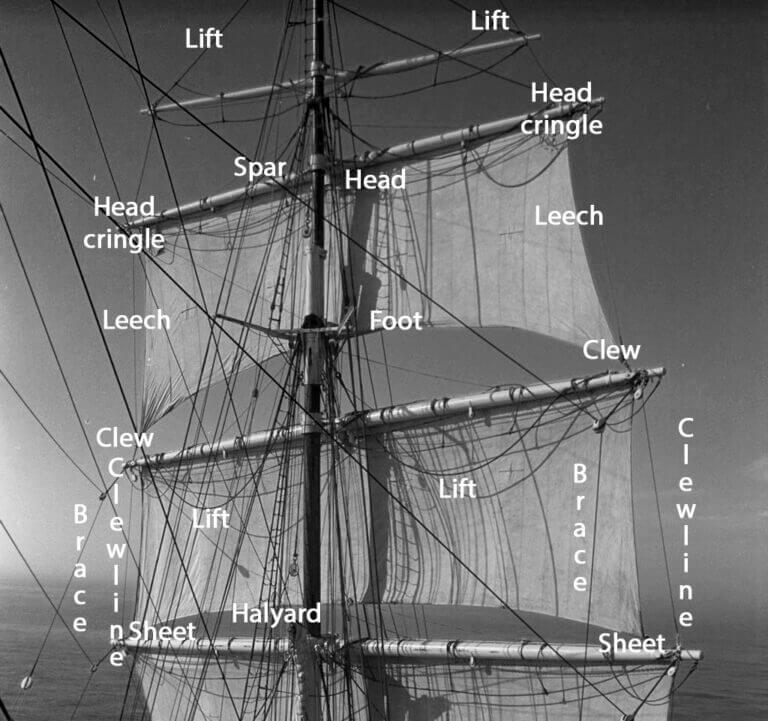
Whats the Difference between Standing Rigging and Running Rigging?
Running rigging refers to the movable lines and ropes used to control the position and shape of the sails on a sailboat. Standing rigging, on the other hand, refers to the fixed wires and cables that support the mast and keep it upright. As the sun rises on another day, we find ourselves immersed in…

Basic Sailing Terminology: Sailboat Parts Explained
Sailing is a timeless activity that has captivated the hearts of adventurous souls for centuries. But, let’s face it, for beginners, sailing can be as intimidating as trying to navigate through a dark, labyrinthine maze with a blindfold on. The vast array of sailing terminology, sailboat parts and jargon can seem like a foreign language…

How do Boats Float? Exploring the Science Behind Buoyancy
Sailboats float because the average density of the boat is less than the density of water. When boats displace as much water as it weights, this is known as the buoyancy force generated by Archimedes’ principle. If you’ve ever wondered how do boats float and therefor enable us to embark on thrilling water adventures, you’ve…

Sailboat Sloop: The Ultimate How To
Introduction:
The sailboat sloop is a popular type of watercraft designed to cater to the needs of sailing enthusiasts and adventurers seeking thrilling journeys on the open water. These boats offer a balanced combination of performance, ease of handling, and comfortable accommodations. In this comprehensive comparison, we will delve into the key characteristics of sailboat sloops, including their design, features, rigging options, and discuss the top brands in the market.
Sailboat Sloop Design and Purpose:
Sailboat sloops are meticulously designed to provide a versatile sailing experience. They typically feature a single mast and a sloop rig configuration consisting of a mainsail and a headsail, such as a genoa or jib. The hull design of sailboat sloops prioritizes stability, speed, and maneuverability, allowing sailors to navigate various sailing conditions with confidence. With their moderate displacement and keel or centerboard, sailboat sloops excel in coastal cruising as well as longer voyages.
Sailboat Sloop Key Features:
Sailboat sloops have comfortable accommodations for extended stays on the water. It includes spacious cabins, a well-equipped galley, and a salon area for dining and relaxation. The interiors are designed to maximize living space and provide essential amenities for a comfortable sailing experience.
- Efficient Sail Handling Systems: Sailboat sloops feature efficient sail-handling systems that make it easy to adjust sails for optimal performance. These systems often include roller furling headsails and in-mast or in-boom furling mainsails, allowing sailors to quickly and effortlessly adapt to changing wind conditions. The incorporation of winches and control lines further enhances the ease of sail handling.
- Stability and Performance: Sailboat sloops prioritize stability and performance to deliver an exhilarating sailing experience. Their hull designs and keel configurations provide stability and reduce excessive rolling in rough seas. Sailboat sloops are known for their balanced performance, combining speed and maneuverability without compromising on comfort, allowing sailors to enjoy both leisurely cruising and spirited sailing.
The Sloop Rig:
The sloop rig consists of a single mast and two sails—a mainsail and a headsail (genoa or jib). This rig allows for easy handling and adaptability in various wind conditions, making it suitable for a wide range of sailing styles, from leisurely coastal cruising to more challenging offshore passages.
Appropriate Buyers and Considerations:
Sailboat sloops are ideal for sailing enthusiasts who appreciate a balanced combination of performance and comfort. When considering a sailboat sloop, potential buyers should take the following factors into account:
- Sailing Preferences: Determine your preferred style of sailing, whether it’s coastal cruising, day sailing, or longer voyages. This will help you choose a sailboat sloop that aligns with your intended use and sailing goals.
- Accommodation Needs: Consider the number of people you plan to accommodate on board and ensure the boat provides sufficient sleeping quarters and living space. Evaluate the functional galley, marine head, and storage capacity.
- Budget: Sailboat sloops vary in price depending on factors such as size, brand, features, and rigging options. Establishing a budget and researching different models within your price range will help you find the best sailboat sloop.
Sailboat Sloop Top Brands:
When searching for a sailboat sloop, it’s essential to explore reputable brands known for their quality construction, sailing performance, and cruising-specific features. Here are three top sailboat sloop brands worth considering:
- Beneteau is a renowned sailboat sloop brand that has earned a stellar reputation for its extensive range of sailboats designed for cruising and racing. Known for their exceptional performance, innovative design, and superior craftsmanship, Beneteau sailboats are favored by sailors worldwide.
- Beneteau sailboats are meticulously engineered to deliver optimal sailing performance. Their sloop designs incorporate advanced hull shapes, efficient sail plans, and cutting-edge rigging systems, allowing for excellent speed and maneuverability on the water. Whether you’re navigating coastal waters or embarking on offshore adventures, Beneteau sailboats offer a perfect balance of performance and comfort.
- The interiors of Beneteau sailboats are carefully designed to maximize space and functionality. With a focus on ergonomic layouts and high-quality materials, these sailboats provide comfortable accommodations for extended stays. Beneteau offers a variety of cabin configurations, ensuring that sailors have ample room for sleeping, dining, and relaxing onboard.
- Beneteau sailboats cater to a diverse range of sailing preferences and needs. From compact cruisers to luxurious yachts, the brand offers models suited for different cruising styles and requirements. Whether you’re a seasoned sailor or a novice looking to embark on your first sailing adventure, Beneteau sailboats provide the performance, comfort, and versatility to meet your expectations.

- Jeanneau is a prestigious sailboat sloop brand that has become synonymous with elegance, performance, and cruising comfort. With a strong emphasis on innovative design, quality construction, and attention to detail, Jeanneau sailboats are highly regarded by sailing enthusiasts around the globe.
- Jeanneau sailboats are designed to deliver exceptional sailing performance. Their sloop configurations feature sleek hulls, efficient sail plans, and advanced rigging systems, enabling sailors to enjoy exhilarating experiences on the water. These sailboats are known for their stability, responsiveness, and ease of handling, making them ideal for both short trips and long-distance cruising.
- The interiors of Jeanneau sailboats exude sophistication and comfort. Crafted with meticulous care, the cabins offer spacious living areas, ergonomic layouts, and high-quality finishes. Jeanneau prioritizes creating inviting and functional spaces, ensuring that sailors have a cozy retreat to relax and unwind after a day of sailing.
- Jeanneau sailboats encompass a wide range of models, accommodating different sailing preferences and needs. From compact cruisers to luxurious yachts, the brand offers options for sailors of all levels of experience. With their focus on performance, comfort, and stylish design, Jeanneau sailboats continue to impress and inspire sailors worldwide.

Hylas Yachts:
- Hylas Yachts is a renowned sailboat sloop brand known for its exceptional craftsmanship, luxurious interiors, and outstanding sailing performance. They are meticulously built with attention to detail, incorporating high-quality materials and innovative design elements.
- Sailors appreciate Hylas Yachts for their seaworthiness and excellent performance under sail. These sailboat sloops feature advanced rigging systems, efficient sail handling, and well-balanced hull designs. Hylas Yachts are designed to offer a perfect balance of speed, stability, and comfort, making them a preferred choice for long-distance cruising and offshore passages.
- The interiors of Hylas Yachts are crafted with elegance and functionality in mind. The cabins are spacious, featuring luxurious accommodations and ample storage space. Hylas Yachts are known for their attention to detail in the craftsmanship of their interiors, providing a comfortable and inviting environment for extended stays on board.
- Hylas Yachts offer a range of models to cater to different sailing preferences and requirements. Whether you’re seeking a compact sloop for coastal cruising or a larger yacht for extended offshore adventures, Hylas Yachts provides options to suit various needs. Their commitment to quality, performance, and luxury has solidified Hylas Yachts as one of the top brands in the market.
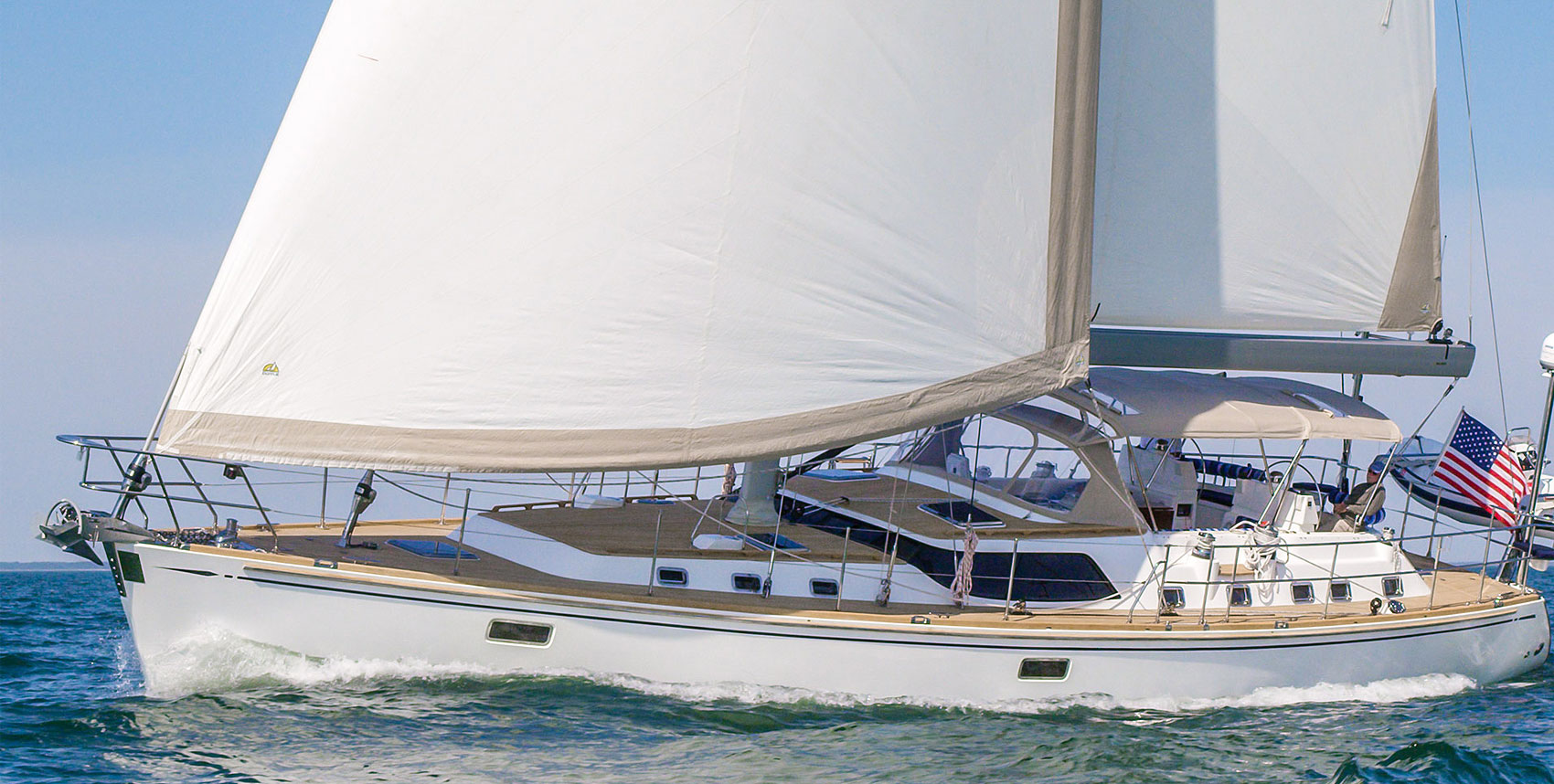
Conclusion:
Sailboat sloops provide sailing enthusiasts with a versatile and thrilling experience, combining performance, ease of handling, and comfortable accommodations. When considering a sailboat sloop, it’s important to evaluate the design, key features, rigging options, and accommodation needs to find a boat that suits your specific sailing requirements. Exploring reputable brands such as Beneteau, Jeanneau, and Hanse will assist you in making an informed decision and selecting a sailboat sloop that delivers both performance and comfort on the water.
We encourage you to use Rabbet to connect with the rest of the boating community! Hop onto our Learn tab to find more articles like this. Join our various forums to discuss with boating enthusiasts like you. Create an account to get started.
Visit us on Pinterest to collect content and inspire others.
Share this:
- Click to share on Twitter (Opens in new window)
- Click to share on Facebook (Opens in new window)
Related Articles

Liveaboard! The Ultimate How To
Become a liveaboard! Swap your landlubber life for a life on the high seas? Here’s everything you need to know to become a full-time boat-dweller!
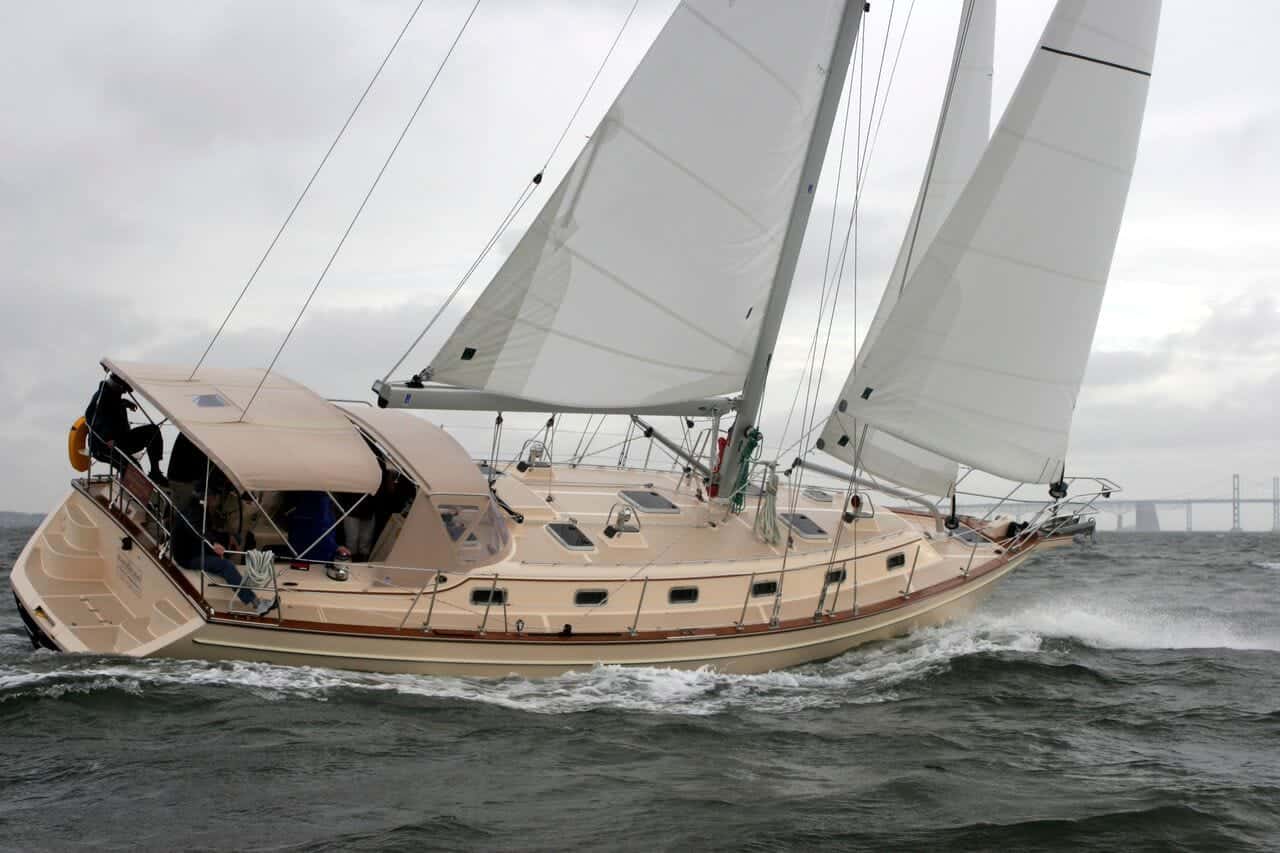
Sailboat Cutters: The Ultimate Guide
Discover the best sailboat cutter for an extraordinary sailing adventure. Explore top brands like Hallberg-Rassy, Swan & Island Packet in our ultimate guide.
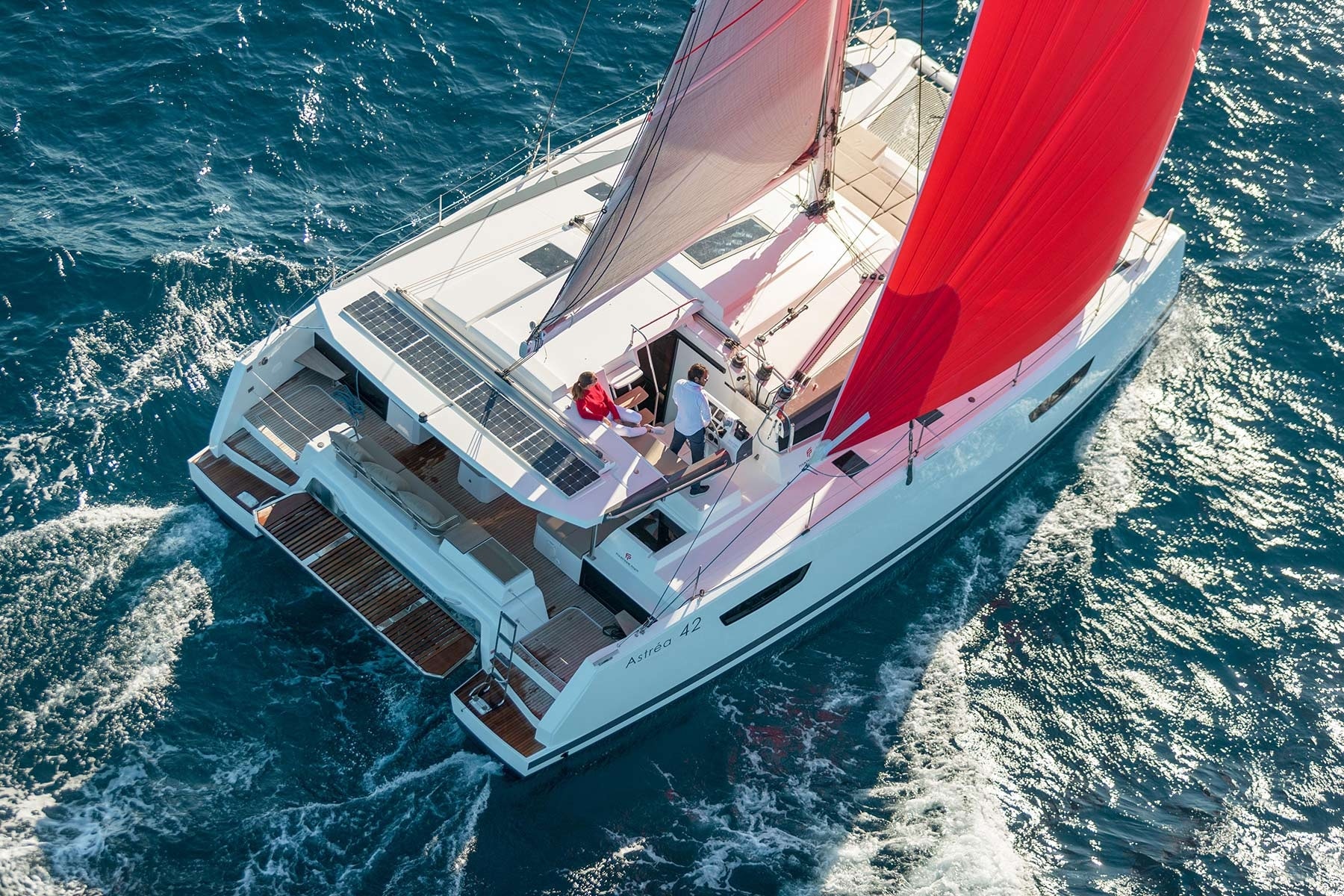
Catamaran Sailboats: The Ultimate Guide
Catamaran sailboats offer exceptional stability, comfort, and living space for sailing enthusiasts. Learn about their design, key features, and top brands.

Sailboat Cruisers: The Ultimate How To
Introduction: Sailboat cruisers are specially designed watercraft built to cater to the needs of sailing enthusiasts and those seeking adventurous journeys on the open water.…

Ketch Sailboats: The Ultimate Guide
Discover the allure of ketch sailboats – versatile sail plans, comfortable accommodations, and reliable performance. Learn more about ketch sailboats here.
Leave a Reply
[…] Sloop Rig: The sloop rig is the most common rigging configuration for catamarans. It features a single mast with a mainsail and a headsail, usually a genoa or jib. This rig provides versatility and ease of handling, making it suitable for a wide range of wind conditions. […]
There was a problem reporting this post.
Block Member?
Please confirm you want to block this member.
You will no longer be able to:
- See blocked member's posts
- Mention this member in posts
- Invite this member to groups
- Message this member
- Add this member as a connection
Please note: This action will also remove this member from your connections and send a report to the site admin. Please allow a few minutes for this process to complete.
Discover more from Rabbet
Subscribe now to keep reading and get access to the full archive.
Type your email…
Continue reading

Jordan Yacht Brokerage
We Never Underestimate Your Dreams
Sailboat rig types: sloop, cutter, ketch, yawl, schooner, cat.
Naval architects designate sailboat rig types by number and location of masts. The six designations are sloop, cutter, cat, ketch, yawl, and schooner. Although in defining and describing these six rigs I may use terminology associated with the sail plan, the rig type has nothing to do with the number of sails, their arrangement or location. Such terms that have no bearing on the rig type include headsail names such as jib, genoa, yankee; furling systems such as in-mast or in-boom; and sail parts such as foot, clew, tack, leach, and roach. Rig questions are one of the primary areas of interest among newcomers to sailing and studying the benefits of each type is a good way to learn about sailing. I will deal with the rigs from most popular to least.
Sloop The simplest and most popular rig today is the sloop. A sloop is defined as a yacht whose mast is somewhere between stations 3 and 4 in the 10 station model of a yacht. This definition places the mast with two thirds of the vessel aft and one third forward. The sloop is dominant on small and medium sized yachts and with the shift from large foretriangles (J-dimension in design parlance) to larger mains a solid majority on larger yachts as well. Simple sloop rigs with a single headsail point the highest because of the tighter maximum sheeting angle and therefore have the best windward performance of the rig types. They are the choice for one-design racing fleets and America’s cup challenges. The forestay can attached either at the masthead or some fraction below. These two types of sloops are described respectively as masthead or fractionally rigged. Fractionally rigged sloops where the forestay attaches below the top of the mast allow racers to easily control head and main sail shapes by tightening up the backstay and bending the mast.
Cutter A cutter has one mast like the sloop, and people rightfully confuse the two. A cutter is defined as a yachts whose mast is aft of station 4. Ascertaining whether the mast is aft or forward of station 4 (what if it is at station 4?) is difficult unless you have the design specifications. And even a mast located forward of station 4 with a long bowsprit may be more reasonably referred to as a cutter. The true different is the size of the foretriangle. As such while it might annoy Bob Perry and Jeff_h, most people just give up and call sloops with jibstays cutters. This arrangement is best for reaching or when heavy weather dictates a reefed main. In moderate or light air sailing, forget the inner staysail; it will just backwind the jib and reduce your pointing height.
Ketch The ketch rig is our first that has two masts. The main is usually stepped in location of a sloop rig, and some manufactures have used the same deck mold for both rig types. The mizzen, as the slightly shorter and further aft spar is called, makes the resulting sail plan incredibly flexible. A ketch rig comes into her own on reaching or downwind courses. In heavy weather owners love to sail under jib and jigger (jib and mizzen). Upwind the ketch suffers from backwinding of the mizzen by the main. You can add additional headsails to make a cutter-ketch.
Yawl The yawl is similar to the ketch rig and has the same trade-offs with respect to upwind and downwind performance. She features two masts just like on a ketch with the mizzen having less air draft and being further aft. In contrast and much like with the sloop vs. cutter definition, the yawl mizzen’s has much smaller sail plan. During the CCA era, naval architects defined yawl as having the mast forward or aft of the rudderpost, but in today’s world of hull shapes (much like with the sloop/cutter) that definition does not work. The true different is the height of the mizzen in proportion to the main mast. The yawl arrangement is a lovely, classic look that is rarely if ever seen on modern production yachts.
Schooner The schooner while totally unpractical has a romantic charm. Such a yacht features two masts of which the foremost is shorter than the mizzen (opposite of a ketch rig). This change has wide affects on performance and sail plan flexibility. The two masts provide a base to fly unusual canvas such as a mule (a triangular sail which spans between the two spars filling the space aft of the foremast’s mainsail). The helm is tricky to balance because apparent wind difference between the sails, and there is considerable backwinding upwind. Downwind you can put up quite a bit of canvas and build up speed.
Cat The cat rig is a single spar design like the sloop and cutter, but the mast location is definately forward of station 3 and maybe even station. You see this rig on small racing dinghies, lasers and the like. It is the simplest of rigs with no headsails and sometimes without even a boom but has little versatility. Freedom and Nonesuch yachts are famous for this rig type. A cat ketch variation with a mizzen mast is an underused rig which provides the sailplan flexibility a single masted cat boat lacks. These are great fun to sail.
Conclusion Sloop, cutter, ketch, yawl, schooner, and cat are the six rig types seen on yachts. The former three are widely more common than the latter three. Each one has unique strengths and weaknesses. The sloop is the best performing upwind while the cat is the simplest form. Getting to know the look and feel of these rig types will help you determine kind of sailing you enjoy most.
5 Replies to “Sailboat Rig Types: Sloop, Cutter, Ketch, Yawl, Schooner, Cat”
Thanks for this information. I’m doing my research on what type of sailboat I will eventually buy and was confused as to all the different configurations! This helped quite a bit.
- Pingback: ketch or schooner - Page 2 - SailNet Community
- Pingback: US Coast Guard Auxiliary Courses – Always Ready! | Escape Artist Chronicles
Being from the south, my distinction between a ketch and a yawl: if that mizzen falls over on a ketch, the boat will catch it; if it falls over on a yawl, it’s bye bye y’all.
I thought a Yawl had to have the mizzen mast behind the rudder and a ketch had the mizzen forward of the rudder.
Leave a Reply
Your email address will not be published. Required fields are marked *
Save my name, email, and website in this browser for the next time I comment.
Great choice! Your favorites are temporarily saved for this session. Sign in to save them permanently, access them on any device, and receive relevant alerts.
- Sailboat Guide

Ron Holland
My first design, the 26 ft. sloop ‘White Rabbit’ was created in 1966 during the 3 year period I attended my boat building apprenticeship in Auckland, New Zealand. Six years later, while working in the engineering department of production yacht builder, Morgan Yachts in St. Petersburg, Florida, I designed a 24 ft. racer, ‘Eygthene’, to the IOR Quarter Ton Rule. This yacht won the 1973 Quarter Ton Championships in Torbay, England, and enabled me to secure the design commission for ‘Golden Apple’ from Irish yachtsman, the late Hugh Coveney. The success of this yacht was the foundation of my Irish based yacht design business. These small racing yachts formed the backbone of the Ron Holland organisation for several years, with a string of successes in level rating world championships and Admiral’s Cup events. Racing at the highest level of international competition. Based on the racing success of the Admiral’s Cup yachts came commissions for maxi racers, the largest yachts competing internationally. In 1980, ‘Kialoa’ and ‘Condor’ established the Ron Holland design philosophy in this area of the business and lead to commissions for larger, performance oriented cruising yachts. ‘Whirlwind XII”, my first design over 100 ft. in length, was launched from the Royal Huisman Shipyard in 1986 and paved the way for a wide variety of design commissions from clients who demanded beautiful, safe, comfortable cruising yachts, capable of worldwide voyaging. The common denominator is these were all performance oriented cruising yachts, the benchmark of the Ron Holland Design philosophy still in force with today’s design commissions. 1999 has seen important new projects that included my first interior design commission, as well as my first motor yacht design work. New areas of activity that I have found stimulating and a logical extension of a lifetime’s work in the marine design field. Reviewing the presented Ron Holland designs will show the variety of design approaches that have been taken, specifically to ensure my clients achieve a yacht that fulfils their personal requirements. My organisation prides itself with interpreting the client’s goals and integrating these with aesthetically correct and performance oriented design solutions.
55 Sailboats designed by Ron Holland

Jeanneau Rush 31

Parker 21 (Trailer Sailer 21)

Nicholson 33 3/4 Ton

Discovery 55

Nicholson 303

Nicholson 1/2 Ton

Swan 43 (Holland)

Nicholson 345

Golden Shamrock 30
Westerly ocean 43.

Trintella 47

Manzanita (Holland)

Bombardier 7.6

Freedom 39 Pilot House

Eygthene 24

Feeling 546

Jeanneau Rush Royale 31
Polaris 37 (holland), discovery 58.

Polaris 33 (Holland)

Super Seal 26

Belliure 2.5

Belliure 63

Feeling 1350
- About Sailboat Guide
©2024 Sea Time Tech, LLC
This site is protected by reCAPTCHA and the Google Privacy Policy and Terms of Service apply.

Find anything, super fast.
- Destinations
- Documentaries
Fresh from the boards of Tony Castro Yacht Design, this 62 metre sloop yacht concept is the largest sub-500GT sailing yacht design possible, according to the studio.
Measuring 62.5 metres from bow to stern with a 12.3 metre beam and 6.5 metre draft, this future-proof concept is bursting with revolutionary technologies. Key on board features include power generators capable of operating while the yacht is underway and cobalt-free batteries. Generated energy can be used to power hotel loads both silently and emissions-free.
Elsewhere, the glazed saloon roof is made from insulating and thermal glass that can block out the sunlight at the touch of a button. The design also features glass bulwarks, a first-time sailing yacht feature, according to the studio. This provides guests relaxing in the cockpit with clear views of the ocean below as they glide through the water under sail.
This 62 metre sailing superyacht is intended as a performance-cruiser with particular attention paid to the amenities needed when at anchor. The main deck saloon extends into a spacious open air aft deck with ample relaxation spots and easy access to the sea. The circular "skydeck" helm station meanwhile is a standout feature that provides excellent visibility of the yacht under sail.
Inside, the yacht features a minimalistic interior with an open plan layout and abundance of natural light thanks to the overhead glass coachroof and large windows on the lower decks. Scandinavian-inspired, the interior features soft, high quality fabric and leather combinations paired with light brushed oak furniture for an understated elegance and atmosphere of pure luxury.
Elsewhere, the yacht's design boasts high performance under sail thanks to cutting edge naval architecture. The hull shape and appendages are optimised with the help of computational fluid dynamics (CFD) executed by D3 Technologies, working in partnership with VPP simulations to create the perfect balance of innovative design and superior performance. The result is an elegant, timeless design, beautiful to the eye with balanced proportions and performance to match.
Creative Team
- Exterior Designer Tony Castro Yacht Design View profile
- Interior Designer Tony Castro Yacht Design View profile
- Ordered by Shipyards & Yacht Brands
- Ordered by Date
- Yacht Designers
- About and Contact
- Yacht Support Vessels
- Tenders & Toys
- Some interesting other sites in the superyacht world
NGONI // Royal Huisman // Dubois
Royal huisman presents the 58m high-performance sloop ngoni that wears correctly the byname "the beast" - penned by the late ed dubois..
Photos were taken by Breed Media
Ngoni is one of the most innovative designs that come to real life. I like those owners who bring courage into the superyacht industry to realize those progressive projects. The owner is a highly experienced yachtsman and offshore racing sailor. The design brief said that the owner wanted a luxurious cruising go-anywhere yacht with high-performance DNA. I haven’t been on board, but I think the project stakeholders delivered precisely that. The statement of requirements in a nutshell:
“Build me a beast. Don’t build me a wolf in sheep’s clothing. This has to be an edgy and innovative weapon; fast and furious.”
Owner of the yacht

Royal Huisman’s subsidiary company RONDAL built the impressive 71m carbon-fiber mast with components by Carbo-Link . Even the style-to-order performance furling boom with a length of 24m could be a big boat by itself and reflects Ngoni ‘s profile design.
The haute couture is most excellent 3 Di canvas , tailored by North Sails The yacht wears a total sail area of 1,950 sqm (upwind) and 3,093 sqm (downwind).
The garderobe contains:
Ed Dubois (1952 – 2016) said:
“The bigger the model, the more accurate the results, because you can scale everything except the viscosity of water. Our aim is to reduce the wetted surface to minimize drag, while still retaining good stability. The hull lines will be finalized by November following the results of the tank tests.”
A Williams 565 jet tender is stored forward under the flush deck. A hidden crane moves the dinghy in or out of the water. The foredeck also contains a pool and enough space set up a sunbathing area with sunshade. Guests can enter the tender via the beach deck with the fold-out swimming platform and an inviting staircase to the cockpit.

Interior of Ngoni
NGONI ‘s Interior design is a creation by Rick Baker and Paul Morgan with signature furniture pieces by Francis Sultana . The full-beam owners’ suite at the aft features direct access to the beach deck, a gym, and a study that transforms into further guest areas alongside the two permanent cabins.
“Accent pieces and exotic finishes will be created in the workshop of London-based Rick Baker Ltd. Having been involved in some of the most high-profile projects on the planet, The Light Corporation has been asked to artfully shed light on the project.”

The deckhouse has two distinct areas. The front part is dedicated to the crew with navigation desk and direct access down to the crew area with the mess, galley, and six double crew cabins. The rear part is a socializing area with coffee table seating, dining, and a bar.

Comments on the project
“Given their reputation for excellence, Royal Huisman was the owner’s choice of shipyard from the very start. This is a thought-provoking design that does not take for granted the marriage of high performance, style, and comfort. She’s a design that marks a fresh and progressive turning point in our long and successful history. This is some yacht, inspired by a client looking for the next new, new thing; a dream project for both designer and shipyard.”

Alice Huisman:
“A great client, a great design team, and a great project. Everything about this project has our name on it: Royal Huisman is the perfect fit for every aspect of the project and the requirements to build it.”

Main Specifications of NGONI
Length Overall
Draft (Keel Up)
Draft (Keel Down)
Profile & General Arrangement
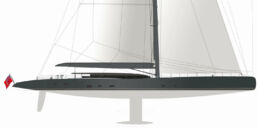
Deck Layout

General Arrangement
Last but not least: Interviews with the naval architect and interior designer of Ngoni
Naval architect ed dubois.
ED: The owner wanted me to take a fresh look at large yacht design. He wanted me to go back to my roots in the late 1970s and ‘80s when we were designing race boats, but he also knew we had designed a number of high-performance yachts that were nevertheless seaworthy and comfortable cruisers. So I had to reset my internal computer, if you like, and look hard at how we could save weight and add strength. That’s how the reverse sheer came about.
Can you explain the concept behind the reverse sheer?
ED: Think of a sloop as a bow and arrow: the bow is the hull, the arrow is the mast and the string is the forestay and backstay. You can imagine that tension creates an awful lot of bending moment, which is fine if you can compensate with a strong, deep beam in the structural sense, but the Beast has a relatively low freeboard and shallow beam with no structural superstructure. Then you make the situation worse by making holes in the deck for tender bays, sail lockers, and hatches – metal that would usually resist the compression in the deck. You can overcome that by adding a substantial sheer strake and Ngoni has a top plate of solid 35mm aluminum that acts like a ring beam around the hull, but it’s still a struggle to come up with the required stiffness. So then I started thinking about a reverse sheer, which is much like the structure of a bridge where the road is convex to resist the compression created by the weight of the traffic. We ran it through our structural analysis program and suddenly we had a 12 percent increase in stiffness for the same weight. It’s something you sometimes see on high-performance boats like Samurai, but this is the first time I’ve designed a sailing yacht with a reverse sheer.

It also affects the exterior profile, of course. Was the owner happy with the look of the boat?
ED: He wanted a yacht that was fast and punchy without losing the concept of a world cruising boat, which allowed me to think outside the box and defy convention. I remember when he initially came to the office I sketched out a design and he said, “It’s OK, but a bit ordinary. What are you going to do now?” I went away and came up with the reverse sheer, but was worried he might not like it. The next time we met in London I showed him the design and he loved it – in fact, he gave me a big bear hug! Actually, Ngoni has a convex sheer at the maximum bending moment amidships that transforms into a concave sheer aft, which looks more attractive and provides better visibility from the cockpit.
To what extent were you involved in the interior layout and design?
ED: With all our designs – except Twizzle, because we joined the project later – we’ve developed the initial space planning. As naval architects, we know where the primary elements such as the mast, the keel box, and the engine room should be. The associated structures around these have a profound effect on the interior layout, especially on a sailing boat. I also very much enjoy dealing with the architecture – as opposed to the naval architecture – of a boat: the flow from one space to another and the lifestyle the owner enjoys (or endures!) on board. So we created the general arrangement and introduced some of the curved shapes into the interior, which provided the template for the interior designers Rick Baker and Paul Morgan.

There is a fine distinction between speed and comfort; does that mean compromises had to be made?
ED: I prefer the word “balance” to “compromise”. To produce a balanced design you have to understand the true purpose of the boat from the owner’s perspective. That means you have to get to know him or her well enough to understand what they really want, which is not always easy as some owners have very clear ideas and others are not too sure. The owner of Ngoni is an experienced sailor who has raced in the Fastnet and Sydney-Hobart, and he knew I understood both the racing and cruising side. Like Frers and Briand, I started my career designing race boats and then transferred into large cruising yachts, so my job as a designer today is to get the right balance of speed, seaworthiness and long-range cruising ability based on the owner’s brief. I don’t think you can do that successfully unless you’ve sat for hours on the weather rail of a boat you’ve designed yourself and got cold and wet and possibly frightened or felt the excitement when you win and disappointment when you lose. You learn how a sailing boat behaves in all conditions on the race course – it is that experience that has given me the confidence to design a large sailing yacht and be pretty certain it’s going to work.
Given the need for speed, was a carbon fiber hull ever considered?
ED: It was, briefly, at the very beginning. The owner wanted to know about all the options and we presented him with comparisons in terms of weight, cost and build times. But there were other considerations at stake: sure, we could make a lighter and faster boat out of carbon, but would it be as comfortable and suitable for world cruising? Carbon hulls have a more aggressive motion at sea, which beyond the issue of seasickness is not very comfortable for long-range cruising. They also tend to be noisy, so some of the weight you’ve saved goes back on the boat as acoustic insulation. Again, it all came down to balance: understanding the true purpose of the yacht and coming up with the right formula, which is the delicious thing about being a designer. It’s like the satisfaction you get from solving a complicated mathematical equation. And people put their trust in you and pay you do it!
Interior Designer Rick Baker Ltd.
Please introduce yourselves
Rick Baker Limited is a bespoke cabinetmaking company which is very firmly art based. Both myself (Rick Baker) and co-director, Paul Morgan, have been through the art college system – I studied illustration and fine art, and Paul originally started off studying architecture before transferring to furniture design and manufacture.
In my twenties, I moved into furniture design and it did not take too long before we became involved with clients that were looking for originality of design and exemplary workmanship. As the company has grown, so has our reputation for producing quirky one-offs.
We employ twelve cabinetmakers and are fortunate to have never needed to advertise for work.
What brief were you given?
We have worked on many projects for these clients, and they asked if we could come up with a scheme for the interiors for the yacht. We were obviously delighted to be involved and had a series of meetings to determine the brief and direction for the yacht styling.

What was your initial reaction?
The design of the yacht is so unique, and it is obviously very exciting to be part of the team working on such a ‘one-off’. The curved shape of a yacht calls for a different approach – we have made a lot of curved furniture, but it was always to fit into square rooms!
Did the brief present any opportunities?
Yes, it was fantastic to meet the team involved in the building of the yacht. It has given us great insight at the highest level. It has also been very interesting to see how the boatyard approaches manufacture generally.
This project also presents us with an incredible opportunity to bring some new ideas to the more traditional styling of many current yachts.

Are there challenges to overcome?
The main challenge comes from the fact that, although we have designed and made freestanding pieces for motor yachts in the past, we have never been asked to design the complete interior of a sailing yacht.
But this also means we can challenge the status quo. We design with only half an eye on what supposedly can or can’t be done on a yacht, then, with the advice of Royal Huisman, we resolved most problems together.
What are the steps between brief and delivery?
We have a relatively simple design process which starts with a client meeting where we throw lots of ideas into the air – we land some of those ideas and we write copious notes. We then work on visuals and scale drawings to present to the clients and then rework those drawings with the design development that has come out of that meeting. We have been fortunate to work closely on several projects for these clients and have developed an understanding of their ideas, likes and dislikes.

How do you collaborate with the project team?
We had initial design concept meetings with Ed Dubois and Royal Huisman to agree to a strategy. And, as I have already mentioned, we work with Royal Huisman to make sure our concepts are fit for purpose as part of a superyacht interior. Also, the experience and advice from Goddy (Project Manager) and Iain Cook (Build Captain) have been invaluable.
Is there an overall ‘theme’?
The yacht is a total one-off, with a unique design by Ed Dubois, and the interiors had to reflect the same state of the art design. So we have consciously avoided giving the yacht a theme but rather chose to make the different areas very individual. It was important to us to not let the craft feel like a hotel and to avoid repetition in the cabins etc.
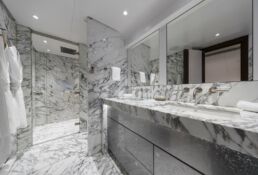
Are you using any unusual materials?
Innovative design still has to be practical and visually comfortable. The ‘standard’ response would be to mix high-sheen lacquer and hardwoods. Instead, we have selected some specialist finishes which would not normally be associated with a contemporary yacht. These include artisan resin panels and metalized spray and lacquered textured effects.
Have you learned anything?
Having been involved in such a wonderful project has given us a different way of seeing and designing, although of course not all of that can be applied to domestic interiors. It has encouraged us to consider new rhythms of furniture design.

How do you think people will react?
I believe that other people will enjoy slowly observing the yacht and interiors when they first board – in the same way, that people attune themselves to understand abstract art. They will inspect carefully and hopefully understand and warm to their surroundings.
Can you sum up the project in a few words?
It has certainly been, quite literally, a learning curve. Our voyage on land with the team has been educational and we hope the journey continues and that the yacht proves itself to be something really special – ‘The Beast’ of speed and fun.
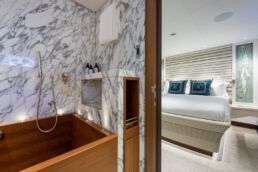
Update January 28th, 2018: NGONI won two awards at the Boat International Design & Innovation Awards 2018 in Kitzbühel: Best Naval Architecture & Best Exterior Styling Sailing Yachts.
Launch and Construction Impressions
Video by Cloudshots
SHARING IS CARING - THANK YOU!
G 64 // sfg yacht design // fancy by dada, benetti fb270 for chinese market, n2h by rossinavi is out of the shed, ulysses // kleven // 116m, amels 200 with interior design by laura pomponi, sirena 42m superyacht, mulder thirtysix delta one, stella di mare // cbi navi.
About Publisher

Using a minimum of third party cookies for YouTube, Vimeo and Analytics.
Privacy Preference Center
Privacy preferences.
Google Analytics
- BOAT OF THE YEAR
- Newsletters
- Sailboat Reviews
- Boating Safety
- Sailing Totem
- Charter Resources
- Destinations
- Galley Recipes
- Living Aboard
- Sails and Rigging
- Maintenance

Sailboat Design Evolution
- By Dan Spurr
- Updated: June 10, 2020
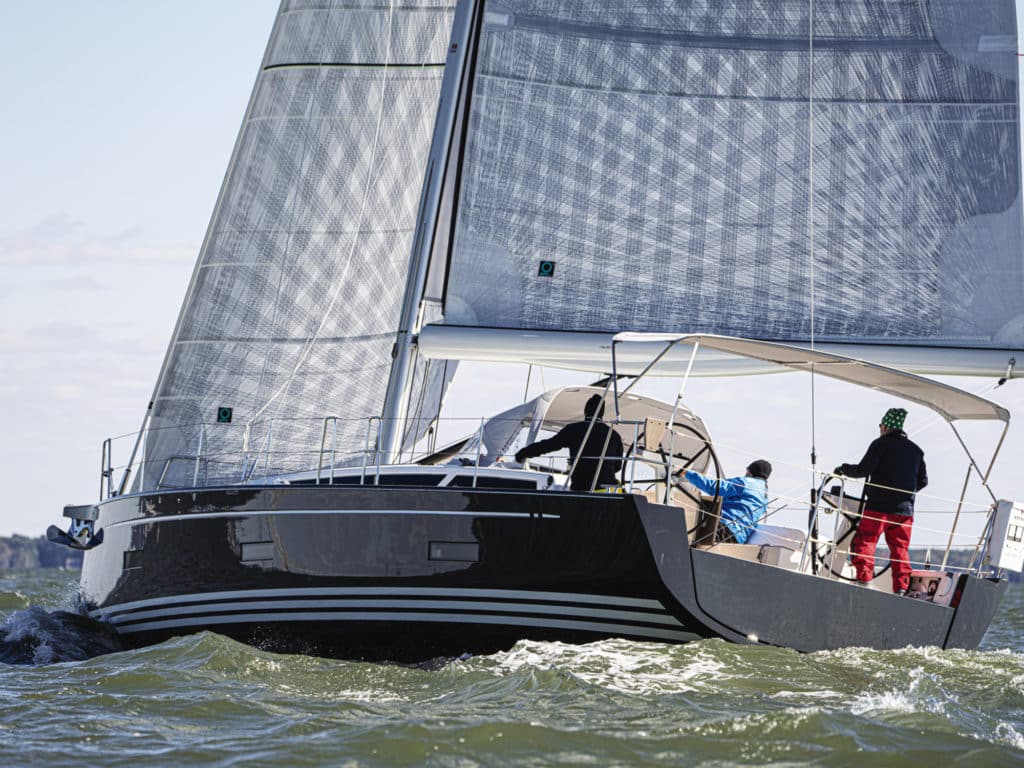
You know the old saying, “The more things change, the more they stay the same”? As a judge for the 2020 Boat of the Year (BOTY) competition at this past fall’s US Sailboat Show in Annapolis, Maryland, I helped inspect and test-sail 22 brand-new current-model sailboats. And I came away thinking, Man, these aren’t the boats I grew up on. In the case of new boats, the saying is wrong: “Nothing stays the same.”
OK, sure, today’s boats still have masts and sails, and the monohulls still have keels. But comparing the Hinckley Bermuda 40, considered by many to be one of the most beautiful and seaworthy boats of the 1960s, ’70s and even ’80s, with, say, the Beneteau First Yacht 53, which debuted at the show, is pretty much apples and oranges.
To get a better sense of what has happened to yacht design, boatbuilding and equipment over the past three, four or even six decades, let’s take a closer look.
Design Dilemmas
At the risk of oversimplification, since the fiberglass era began in the late 1940s and ’50s, the design of midsize and full-size yachts has transitioned from the Cruising Club of America rules, which favored all-around boats (racers had to have comfortable interiors) with moderate beam and long overhangs, to a succession of racing rules such as the IOR, IMS and IRC. All of them dictated proportions, and each required a measurer to determine its rating.
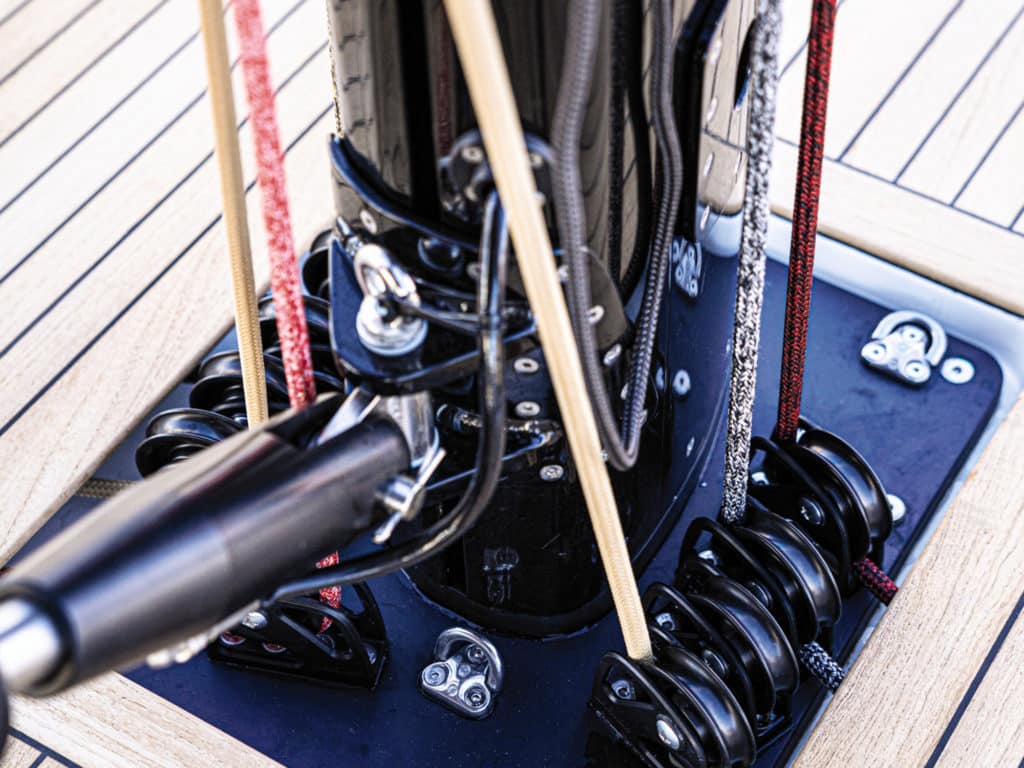
As frustration grew with each (no handicap rule is perfect), alternatives arose, such as the Performance Handicap Racing Fleet, which essentially based one’s handicap on past performance of the same boats in the same fleet. Also, one-design racing became more popular, which spread beyond identical small boats to full-size yachts, popularized in part by builders such as J/Boats and Carroll Marine. The ethos there was: Who cares about intricate rating rules? Let’s just go out and sail fast and have fun!
And that might best sum up the design briefs for the monohulls in this year’s BOTY competition: good all-around performance with comfortable, even luxurious accommodations. Gone are interiors that noted naval architect Robert Perry called “the boy’s cabin in the woods,” deeply influenced by stodgy British designers of the past century and their now-old-fashioned (though sea-friendly, one should note) concepts of a proper yacht, drawn and spec’d by the same guy who designed the hull, deck and rig. Today, dedicated European interior designers are specially commissioned to inject modernity, home fashion colors and textures, amenities, and more light—even dubiously large port lights in the topsides.
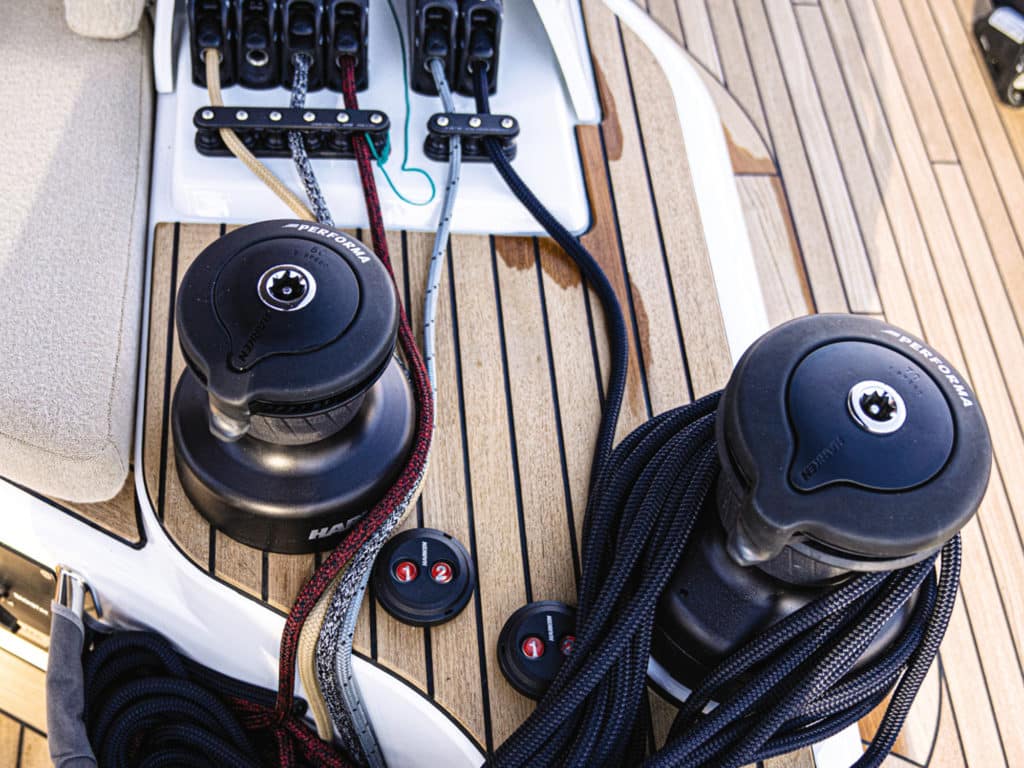
Overhangs, bow and stern, have virtually disappeared. Why? It seems largely a matter of style. Plus, the bonus of increased usable space below, not to mention a longer waterline length for a given length overall, which translates to more speed. Former naval architect for C&C Yachts and Hunter Marine, Rob Mazza, recalls that 19th-century pilot cutters and fishing schooners operating in offshore conditions generally had plumb bows, so in a sense, bow forms have come full circle.
Today’s boats are carrying their wide beam farther aft. Gone are the days of the cod’s head and mackerel tail. Wide, flat canoe bodies are decidedly fast off the wind, and might even surf, but they pay a comfort penalty upwind.
These boats have lighter displacement/length (D/L) ratios, which means flatter bottoms and less stowage and space for tanks. The Beneteau 53 has a D/L of 118, compared with the aforementioned Bermuda 40 of 373. Among entries in this year’s BOTY, the heaviest D/L belonged to the Elan Impression 45.1, with a D/L of 195. Recall that when Perry’s extremely popular Valiant 40 was introduced in 1975, the cruising establishment howled that its D/L of 267 was unsuitable for offshore sailing. My, how times have changed!
Perhaps more important, one must ask: “Have the requirements for a good, safe bluewater cruiser actually changed? Or are the majority of today’s production sailboats really best-suited for coastal cruising?”
The ramifications of lighter displacement don’t end there; designers must consider two types of stability: form and ultimate. As weight is taken out of the boat, beam is increased to improve form stability. And with tanks and machinery sometimes raised, ballast might have to be added and/or lowered to improve ultimate stability.
What else to do? Make the boat bigger all around, which also improves stability and stowage. Certainly the average cruising boat today is longer than those of the earlier decades, both wood and fiberglass. And the necessarily shallower bilges mean pumps must be in good shape and of adequate size. That’s not as immediate an issue with a deep or full keel boat with internal ballast and a deep sump; for instance, I couldn’t reach the bottom of the sump in our 1977 Pearson 365.
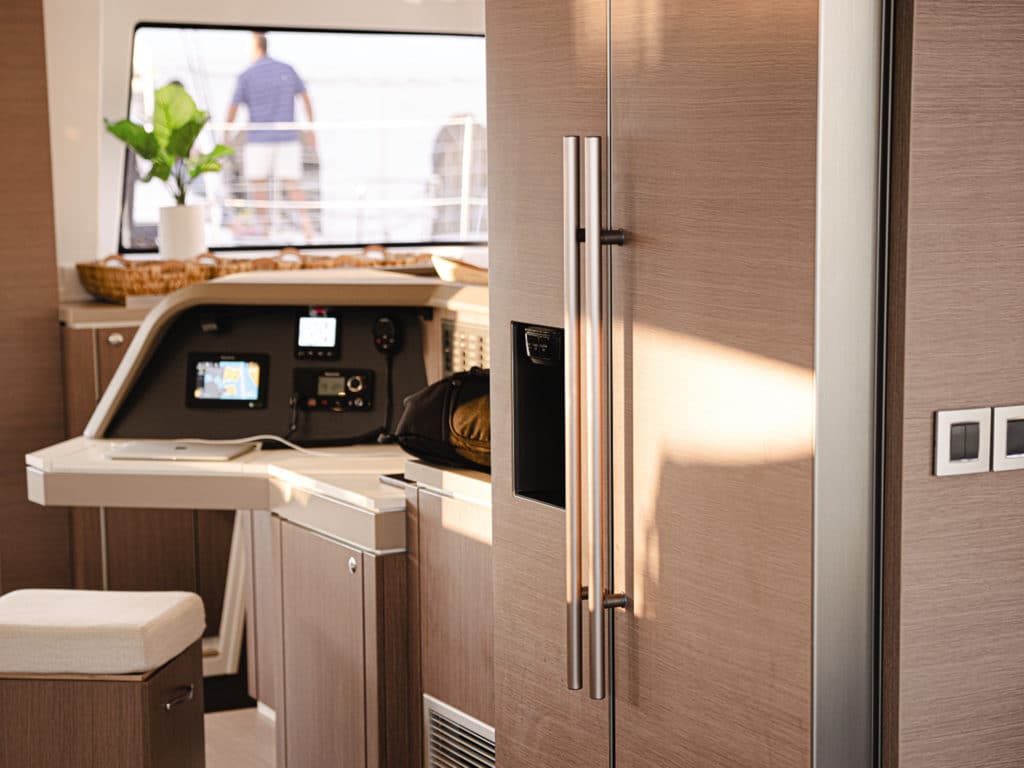
And how do these wide, shallow, lighter boats handle under sail? Like a witch when cracked off the wind. We saw this trend beginning with shorthanded offshore racers like those of the BOC Challenge round-the-world race in the early 1980s. As CW executive editor Herb McCormick, who has some experience in these boats, says, “They’ll knock your teeth out upwind.” But route planning allows designers to minimize time upwind, and cruisers can too…if you have enough room and distance in front of you. Coastal sailors, on the other hand, will inevitably find even moderate displacement boats more comfortable as they punch into head seas trying to make port.
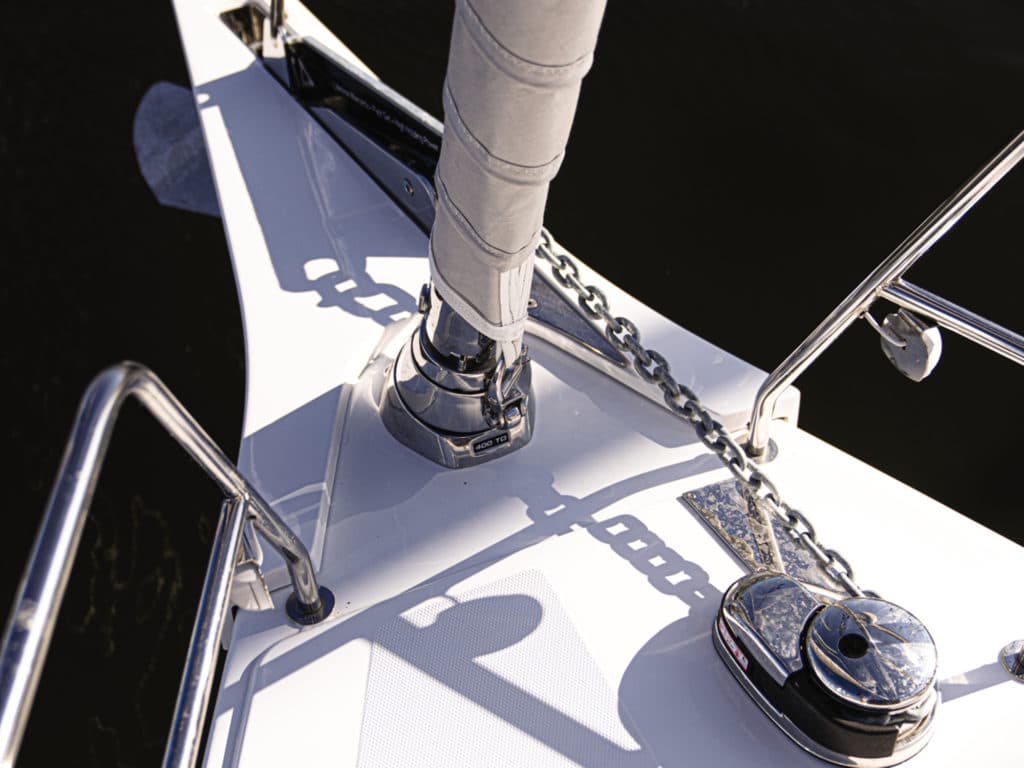
A wide beam carried aft permits a number of useful advantages: the possibility of a dinghy garage under the cockpit on larger boats; easy access to a swim platform and a launched dinghy; and twin helms, which are almost a necessity for good sightlines port and starboard. Of course, two of anything always costs twice as much as one.
Some multihulls now have reverse bows. This retro styling now looks space-age. Very cool. But not everyone is sold on them. Canadian designer Laurie McGowan wrote in a Professional BoatBuilder opinion piece, “I saw through the fog of faddishness and realized that reverse bows are designed to fail—that is, to cause vessels to plunge when lift is required.” Mazza concurs: “Modern multihulls often have reverse stems with negative reserve buoyancy, and those are boats that really can’t afford to bury their bows.”
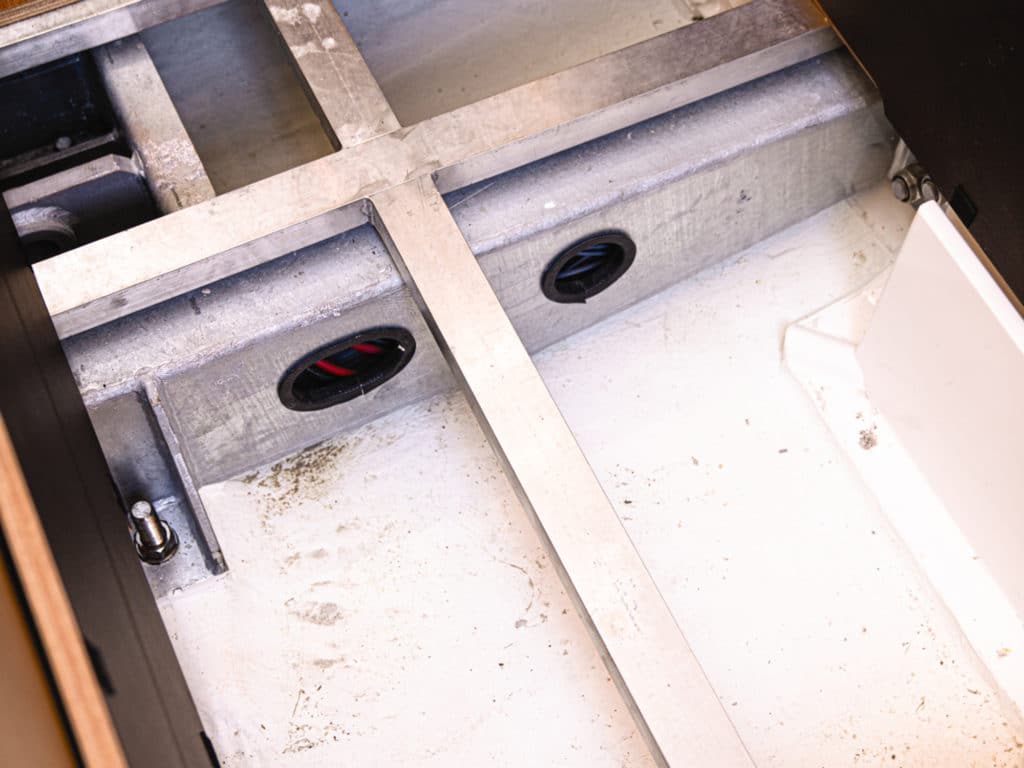
McGowan also cites another designer critiquing reverse bows for being noticeably wet and requiring alternative ground-tackle arrangements. The latter also is problematic on plumb bows, strongly suggesting a platform or sprit to keep the anchor away from the stem.
Rigging Redux
If there was a boat in Annapolis with double lower shrouds, single uppers, and spreaders perpendicular to the boat’s centerline, I must have missed it. I believe every boat we sailed had swept-back spreaders and single lowers. An early criticism of extreme swept-back spreaders, as seen on some B&R rigs installed on Hunter sailboats, was that they prevented fully winging out the mainsail. The counter argument was that so many average sailors never go dead downwind in any case, and broad reaching might get them to their destinations faster anyway—and with their lunch sandwiches still in their stomachs.
That issue aside, the current rigging configuration may allow for better mainsail shape. But as Mazza points out, it’s not necessarily simple: “By sweeping the spreaders, the ‘transverse’ rigging starts to add fore-and-aft support to the midsection of the mast as well, reducing the need for the forward lowers. However, spreader sweep really does complicate rig tuning, especially if you are using the fixed backstay to induce headstay tension. Swept spreaders do make it easier to sheet non-overlapping headsails, and do better support the top of the forestay on fractional rigs.”
Certainly, the days of 150 percent genoas are over, replaced by 100 percent jibs that fit perfectly in the foretriangle, often as a self-tacker.
Another notable piece of rigging the judges found common was some form of lazy jacks or mainsail containment, from traditional, multiple lines secured at the mast and boom; to the Dutchman system with monofilament run through cringles sewn into the sail like a window blind; to sailmaker solutions like the Doyle StackPak. This is good news for all sailors, especially those who sail shorthanded on larger boats.
Construction Codas
Improvements in tooling—that is, the making of molds—are easily evident in today’s boats, particularly with deck details, and in fairness. That’s because many of today’s tools are designed with computer software that is extraordinarily accurate, and that accuracy is transferred flawlessly to big five-axis routers that sculpt from giant blocks of foam the desired shape to within thousandths of an inch. Gone are the days of lofting lines on a plywood floor, taken from a table of offsets, and then building a male plug with wood planks and frames. I once owned a 1960s-era sailboat, built by a reputable company, where the centerline of the cockpit was 7 degrees off the centerline of the deck—and they were one piece!
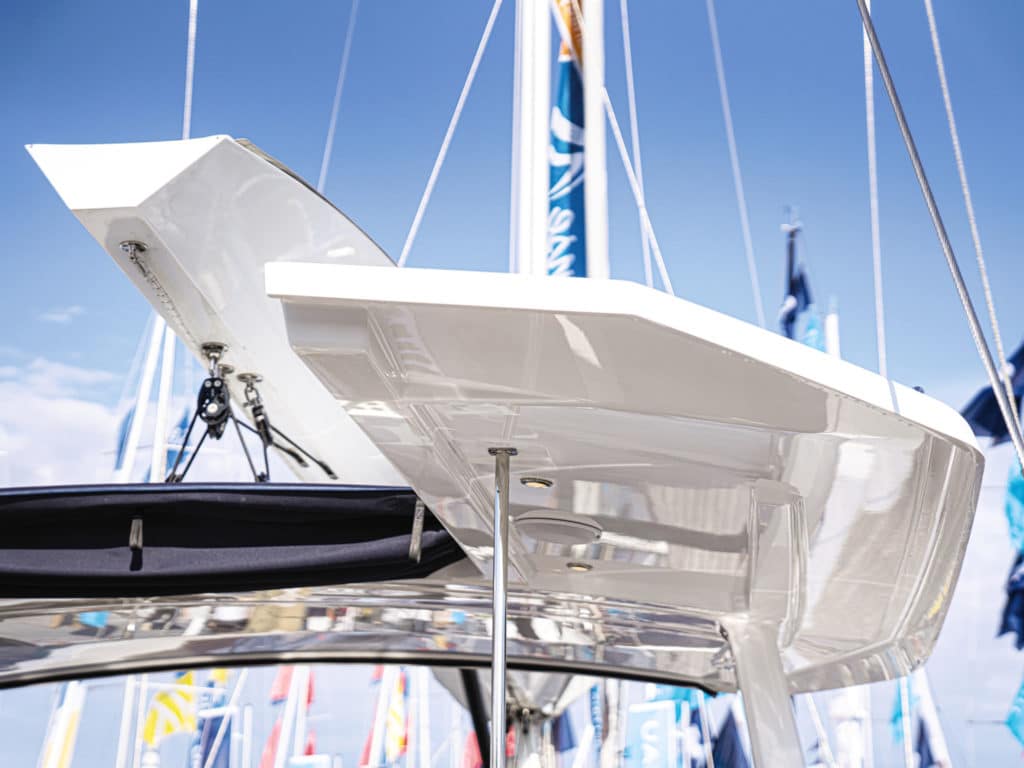
Additive processes, such as 3D printing, are quickly complementing subtractive processes like the milling described above. Already, a company in California has made a multipart mold for a 34-foot sailboat. Advantages include less waste materials.
Job training also has had an impact on the quality of fiberglass boats. There are now numerous schools across the country offering basic-skills training in composites that include spraying molds with gelcoat, lamination, and an introduction to vacuum bagging and infusion.
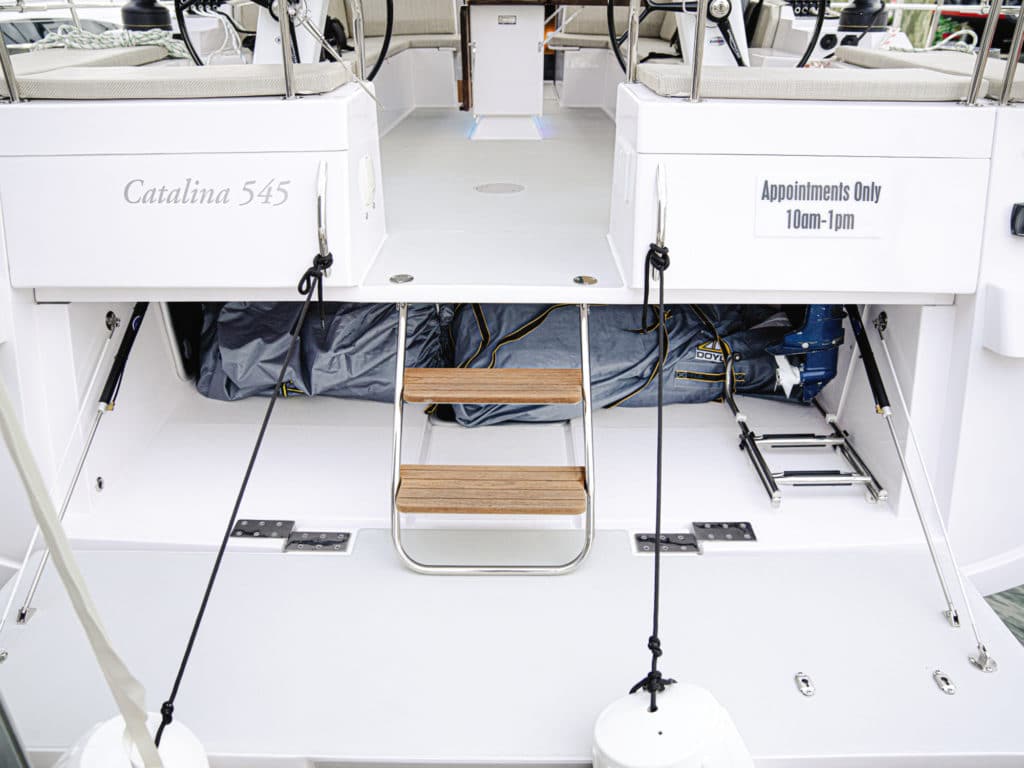
The patent on SCRIMP—perhaps the first widely employed infusion process—has long ago expired, but many builders have adopted it or a similar process whereby layers of fiberglass are placed in the mold dry along with a network of tubes that will carry resin under vacuum pressure to each area of the hull. After careful placement, the entire mold is covered with a bag, a vacuum is drawn by a pump, and lines to the pot of resin are opened. If done correctly, the result is a more uniform fiberglass part with a more controlled glass-to-resin ratio than is achievable with hand lay-up. And as a huge bonus, there are no volatile organic compounds released into the workplace, and no need for expensive exhaust fans and ductwork. OSHA likes that, and so do the workers.
However, sloppy processes and glasswork can still be found on some new boats. Surveyor Jonathan Klopman—who is based in Marblehead, Massachusetts, but has inspected dozens, if not hundreds, of boats damaged by hurricanes in the Caribbean—tells me that he is appalled by some of the shoddy work he sees, such as balsa cores not vacuum-bagged to the fiberglass skins, resulting in delamination. But overall, I believe workmanship has improved, which is evident when you look behind backrests, inside lockers and into bilges, where the tidiness of glasswork (or lack thereof) is often exposed. Mechanical and electrical systems also have improved, in part due to the promulgation of standards by the American Boat & Yacht Council, and informal enforcement by insurance companies and surveyors.
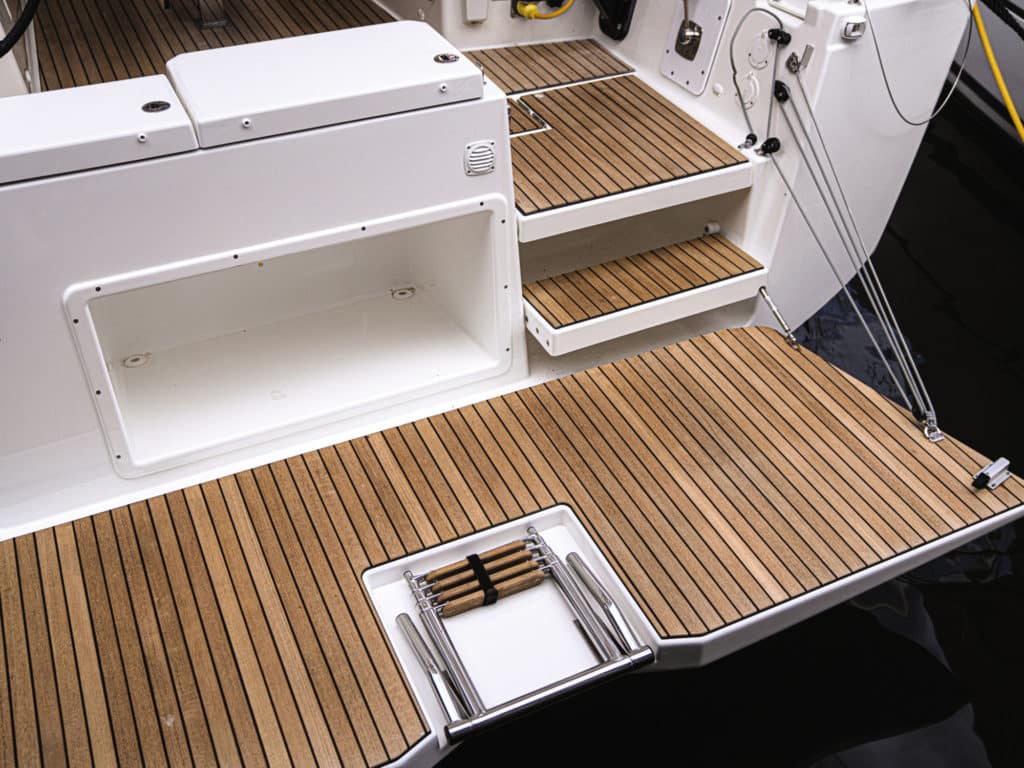
We all know stainless steel isn’t entirely stainless, and that penetrations in the deck are potentially troublesome; allowing moisture to enter a core material, such as end-grain balsa, can have serious consequences. The core and fiberglass skins must be properly bonded and the kerfs not filled with resin. Beginning in the mid-1990s, some builders such as TPI, which built the early Lagoon cruising catamarans, began using structural adhesives, like Plexus, to bond the hull/deck joint rather than using dozens of metal fasteners. These methacrylate resins are now commonly used for this application and others. Klopman says it basically should be considered a permanent bond, that the two parts, in effect, become one. If you think a through-bolted hull/deck joint makes more sense because one could theoretically separate them for repairs, consider how likely that would ever be: not highly.
Fit-and-Finish
Wide transoms spawned an unexpected bonus; besides the possibility of a dinghy “garage” under the cockpit on larger boats, swim platforms are also possible. In more than one BOTY yacht, the aft end of the cockpit rotated down hydraulically to form the swim platform—pretty slick.
Teak decks are still around, despite their spurning for many years by owners who didn’t want the upkeep. In the 1960s and ’70s, they were considered a sign of a classy boat but fell from favor for a variety of reasons: maintenance, weight and threat of damaging the deck core (the bung sealant wears out and water travels down the fastener through the top fiberglass skin into the core). Specialty companies that supply builders, like Teakdecking Systems in Florida, use epoxy resin to bond their product to decks rather than metal fasteners. And the BOTY judges saw several synthetic faux-teak products that are difficult to distinguish from real teak—the Esthec installed on the Bavaria C50 being one example.
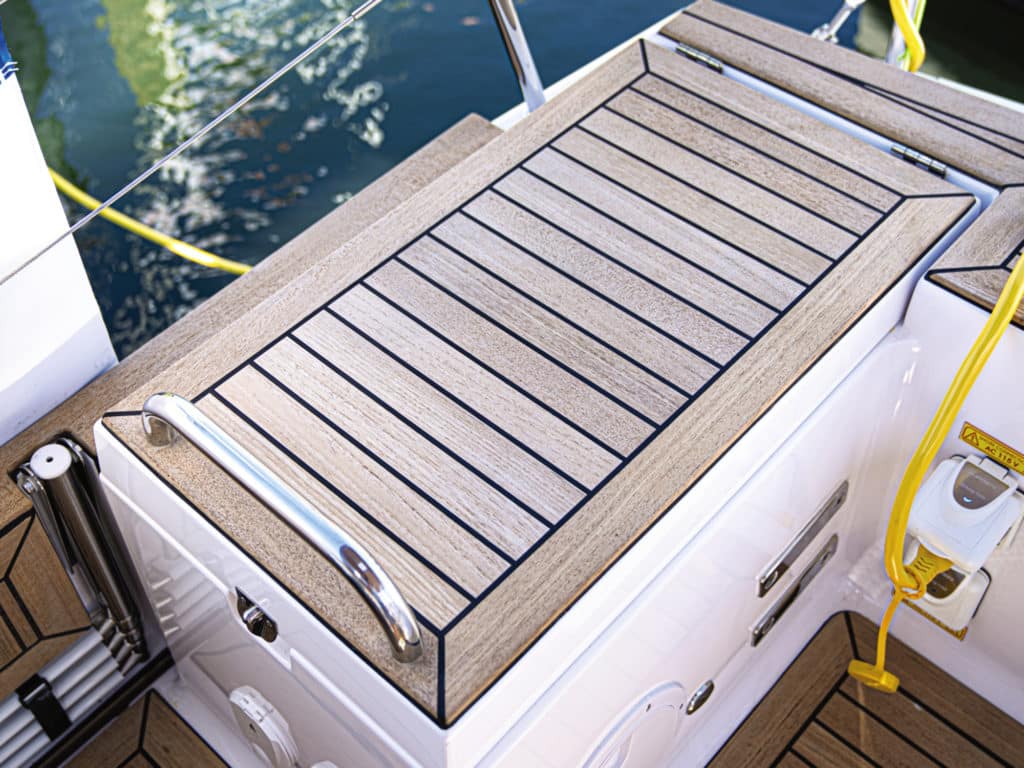
LPG tanks no longer have to be strapped to a stanchion or mounted in a deck box because decks now often incorporate molded lockers specifically designed for one or two tanks of a given size. To meet ABYC standards, they drain overboard. In tandem with these lockers, some boats also have placements or mounts for barbecues that are located out of the wind, obviating the common and exposed stern-rail mount.
Low-voltage LED lights are replacing incandescent bulbs in nearly all applications; improvements in technology have increased brightness (lumens), so some even meet requirements for the range of navigation lights. Advances in battery technology translate to longer life, and depending on type, faster charging. And networked digital switching systems for DC-power distribution also are becoming more common.
Last, I was surprised at how many expensive yachts exhibited at Annapolis had nearly the least-expensive toilets one can buy. Considering the grief caused by small joker valves and poorly sealed hand pumps, one would think builders might install systems that incorporate higher-quality parts or vacuum flushing, and eliminate the minimal hosing that famously permeate odors.
Dan Spurr is an author, editor and cruising sailor who has served on the staffs of Cruising World, Practical Sailor and Professional Boatbuilder. His many books include Heart of Glass , a history of fiberglass boatbuilding and boatbuilders .
Other Design Observations
Here are a few other (surprising) items gleaned from several days of walking the docks and sailing the latest models:
- Multihulls have gained acceptance, though many production models are aimed more at the charter trade than private ownership for solitary cruising. You’d have to have been into boats back in the ’60s and ’70s to remember how skeptical and alarmist the sailing establishment was of two- and three-hull boats: “They’ll capsize and then you’ll drown.” That myth has been roundly debunked. Back then, the only fiberglass-production multihulls were from Europe, many from Prout, which exported a few to the US. There are still plenty of European builders, particularly from France, but South Africa is now a major player in the catamaran market.
- The French builders now own the world market, which of course includes the US. Other than Catalina, few US builders are making a similar impact. In terms of volume, Groupe Beneteau is the largest builder in the world, and they’ve expanded way beyond sailboats into powerboats, runabouts and trawlers.
- Prices seem to have outpaced inflation, perhaps because, like with automobiles, where everyone wants air conditioning, electric windows and automatic transmissions, today’s boats incorporate as standard equipment items that used to be optional. Think hot- and cold-pressure water, pedestal-wheel steering, and full suites of sailing instruments and autopilots.
- More: design , print may 2020 , Sailboats
- More Sailboats

A Gem in New England

Thinking of a Shift to Power?

TradeWinds Debuts 59-foot TWe6 Smart Electric Yacht

Sailboat Preview: Dufour 44

How To Prioritize Your Sailboat’s Spring Checklist

Good Bread for Good Health

Center of Effort
- Digital Edition
- Customer Service
- Privacy Policy
- Email Newsletters
- Cruising World
- Sailing World
- Salt Water Sportsman
- Sport Fishing
- Wakeboarding

THE WORLD’S LARGEST SLOOP
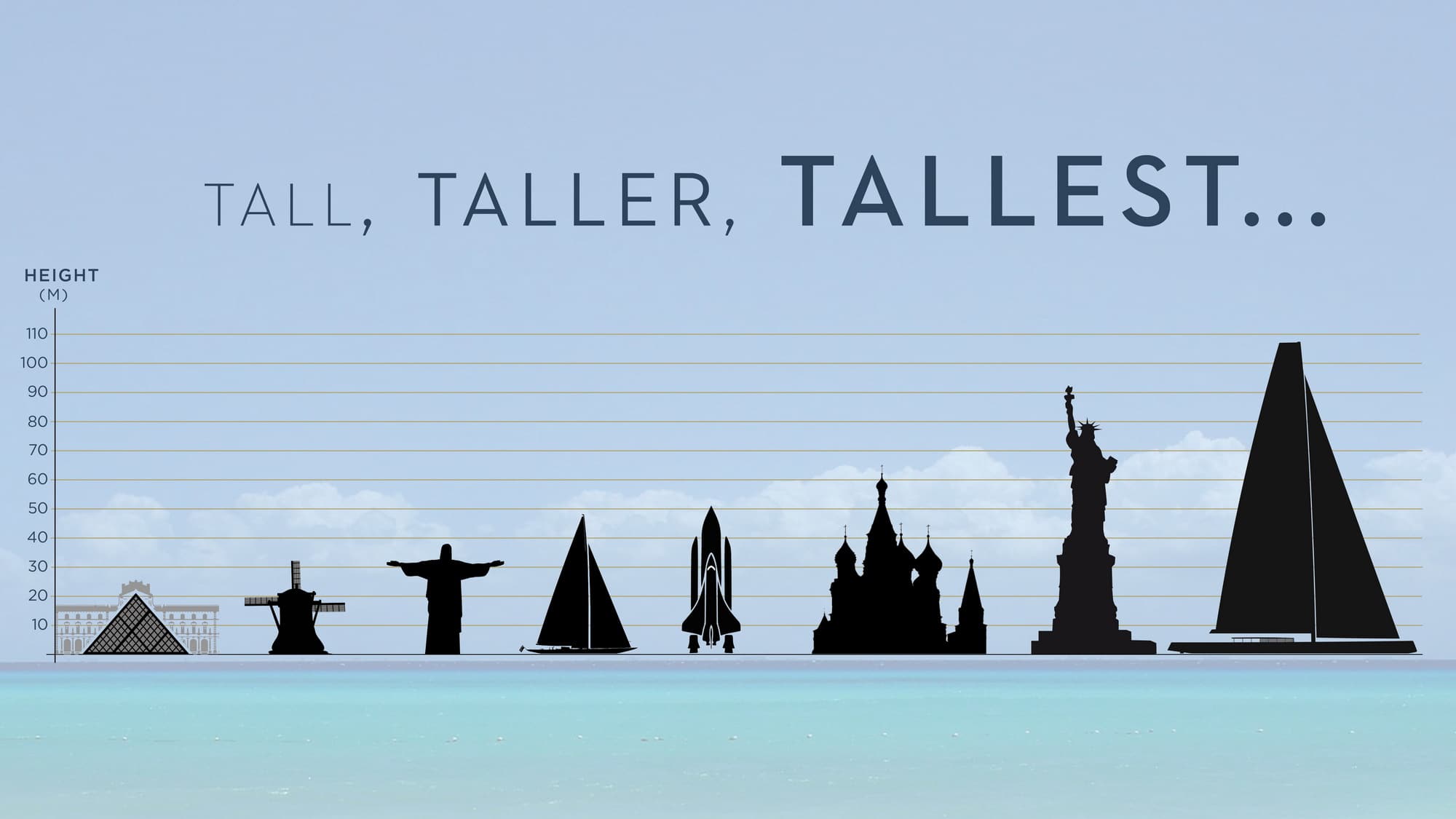
AN UNPRECEDENTED OPPORTUNITY FOR AN INSPIRED OWNER
The APEX 850 mega sloop is one of the most exciting concepts the yachting world has ever seen. Dramatic in scale yet elegant in appearance, the 85 m / 279 ft APEX features a mind-blowing 107 m / 351 ft rig, qualifying as both the world’s largest sloop and the world’s largest aluminium sailing yacht. She will effortlessly join the top ten largest sailing boats.
Inspirational design from celebrated naval architect Malcom McKeon and innovative engineering from Royal Huisman have resulted in a fully-resolved concept for a mega yacht that is bold and ambitious enough to comprehensively redefine on-board lifestyle and sailing experiences.
Just add the refinements that express the vision and creativity of an inspired owner and she will be ready to commence construction. Once on the water, the world will look on in awe.
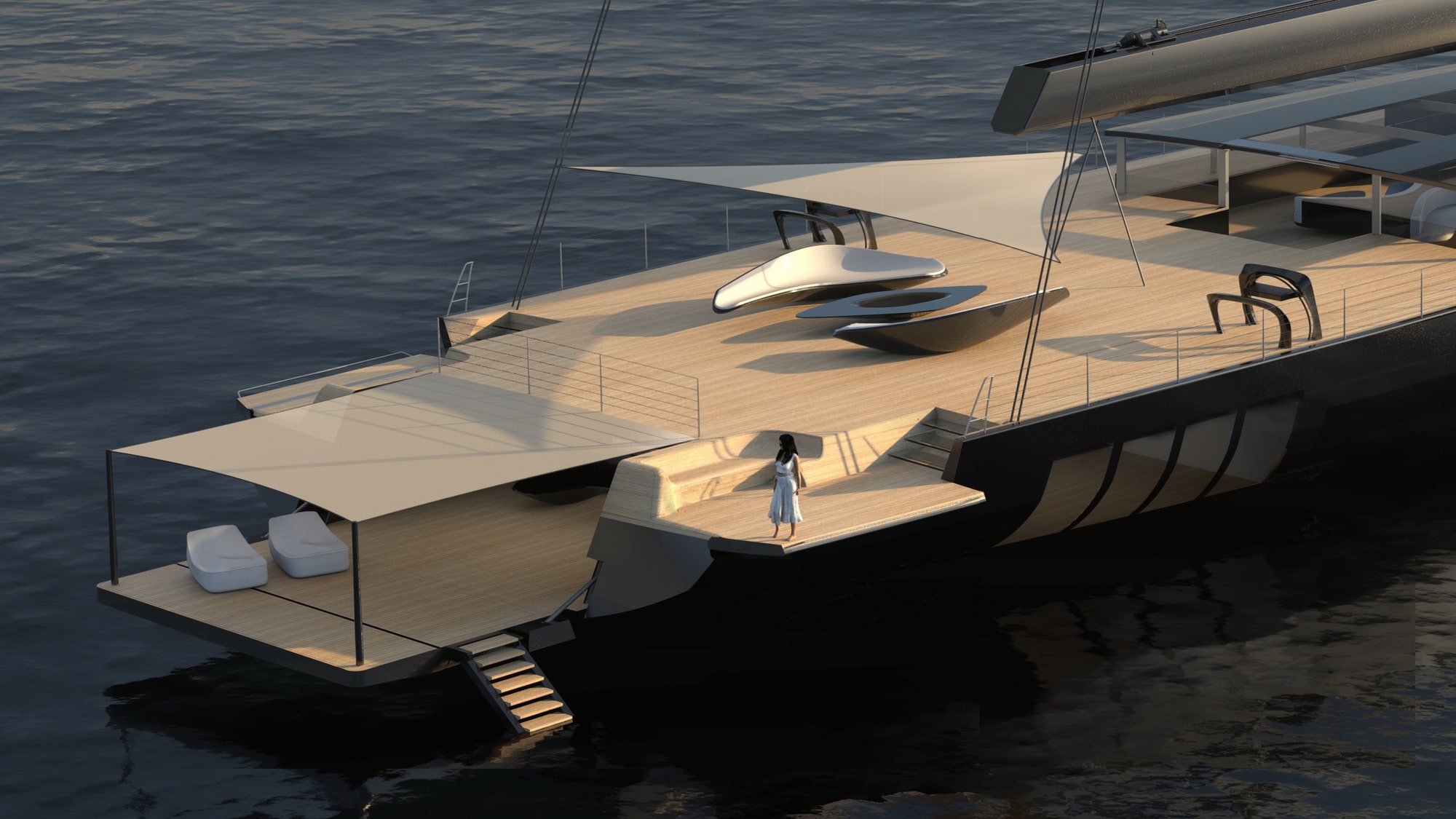
“Two of the world’s ten largest sailing yachts, ATHENA and SEA EAGLE II, are Royal Huisman builds and APEX 850 would make a fitting third, easily becoming the largest member of this elite circle.”
AN ICONIC COLLABORATION
The innovators behind APEX 850 – Malcolm McKeon Yacht Design and Royal Huisman – come with a pedigree that hardly needs introduction to followers of the world’s leading super-sailing yachts. Enjoy watching the video with the designer’s and builder’s comments.
Technically, APEX is a fully resolved concept as you can see via the links below . Yet there remains extensive scope for an Owner to incorporate their own ideas and apply their creativity to realise a personal vision for APEX 850. The Malcolm McKeon / Royal Huisman team are ready to discuss your ideas and help translate them into reality. As we like to say at Royal Huisman: “If you can dream it, we can build it”.
Just ask us about the possibilities.
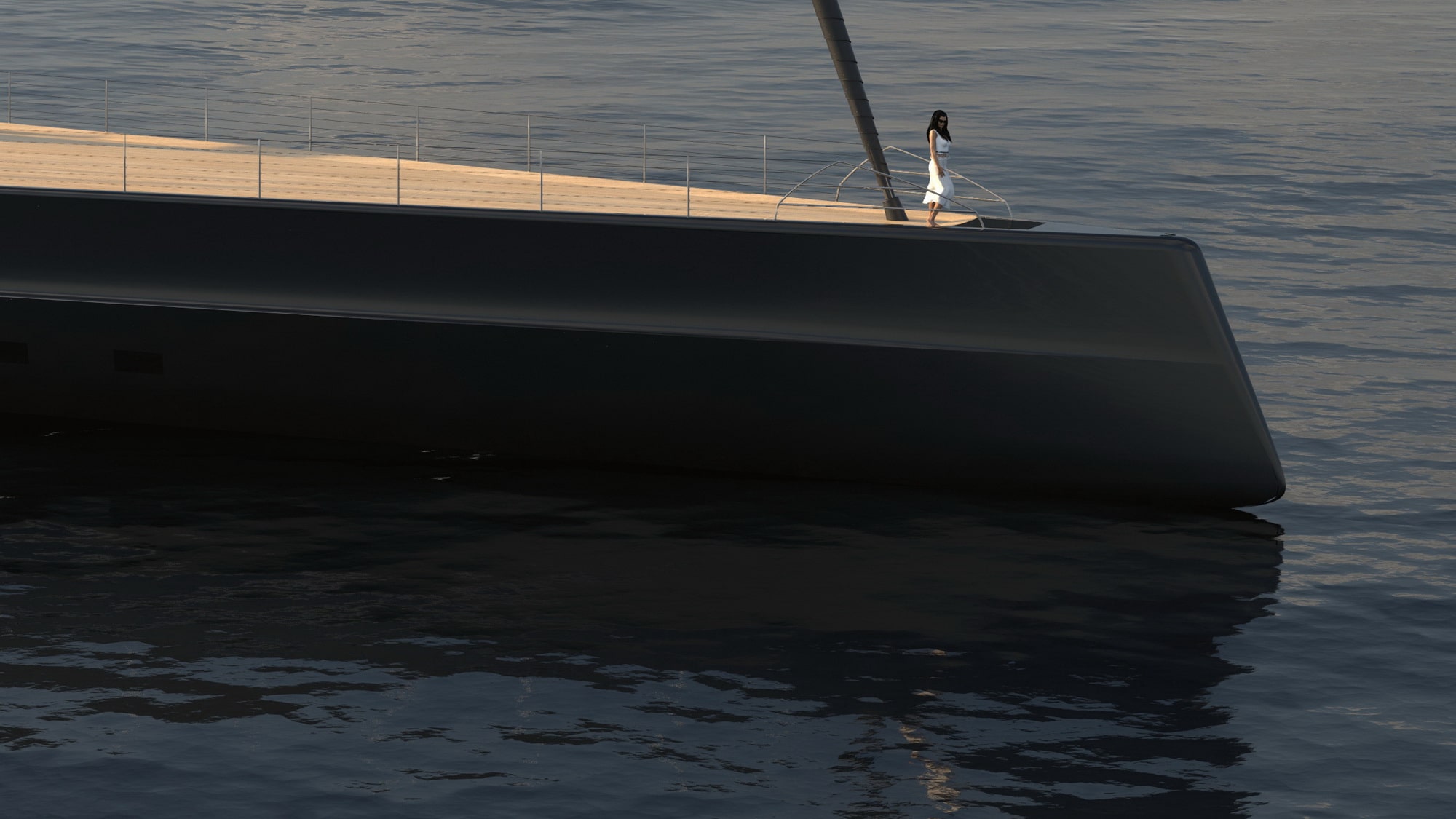
THE ULTIMATE VIRTUAL EXPERIENCE
There is an amazing, stereoscopic Oculus 3D virtual tour exclusively available to prospective Owners. The depth of field and quality of presentation offered by this technology provide the viewer with the most extraordinary, fully immersive, experience of being aboard the world’s largest sloop.
A preview can be found via the online 360 VR tour: click here.
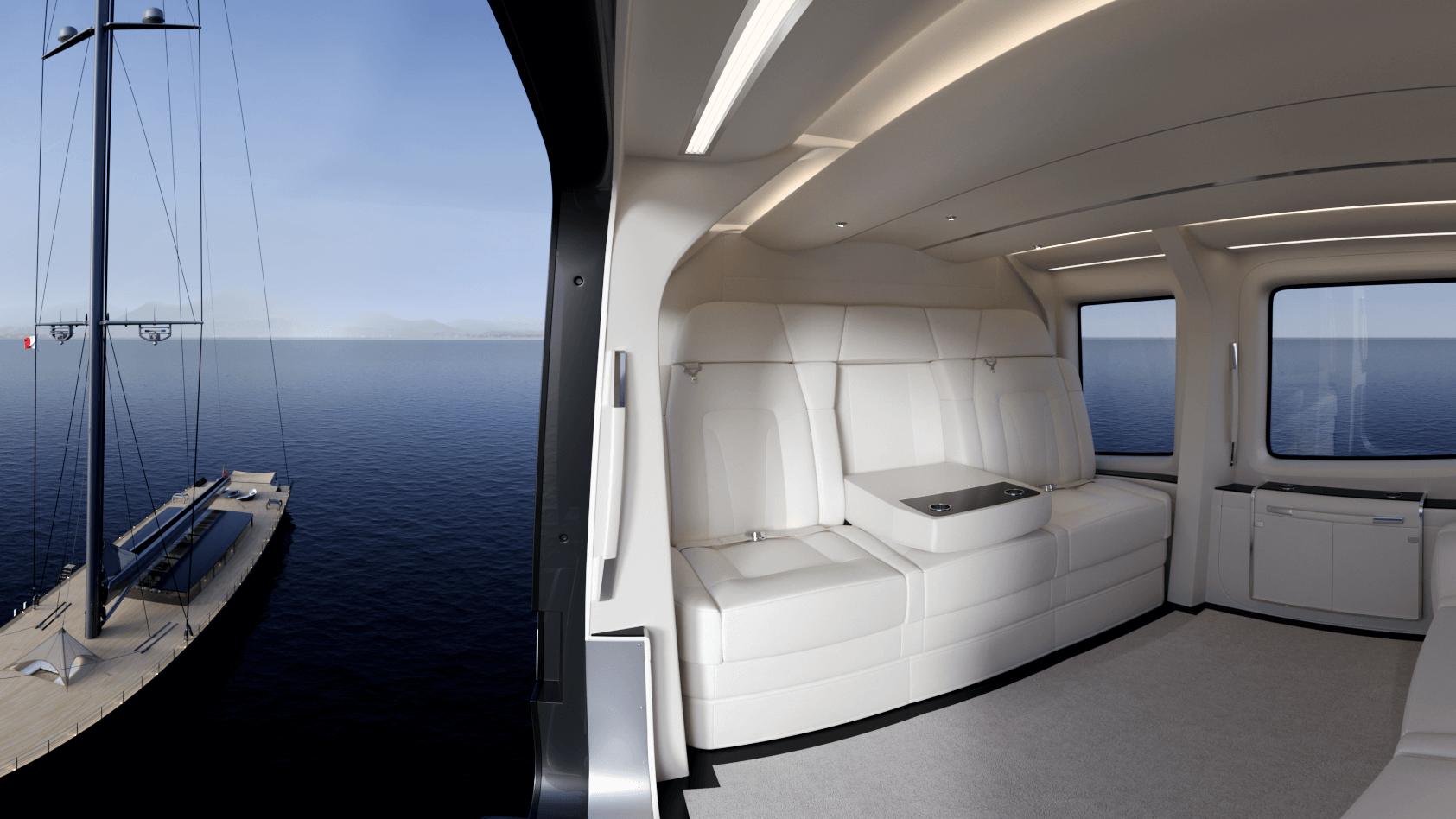
MAKING AN IMPRESSION
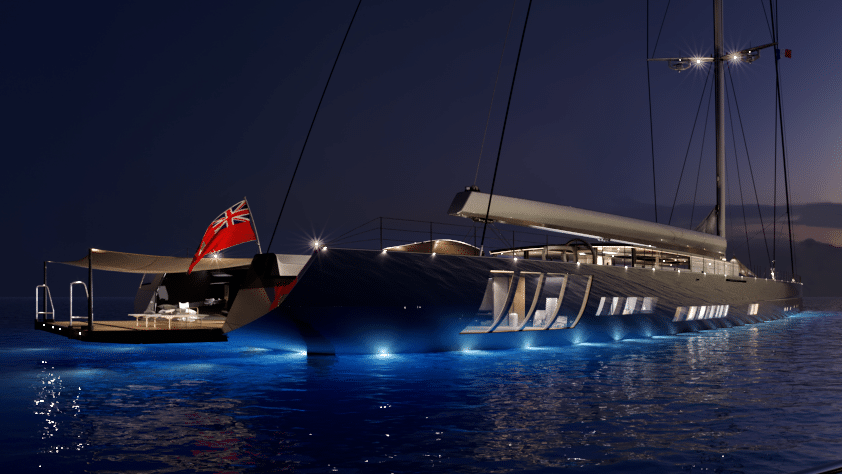
OWNERS’ APARTMENT

CLOSE CONNECTION WITH THE SEA
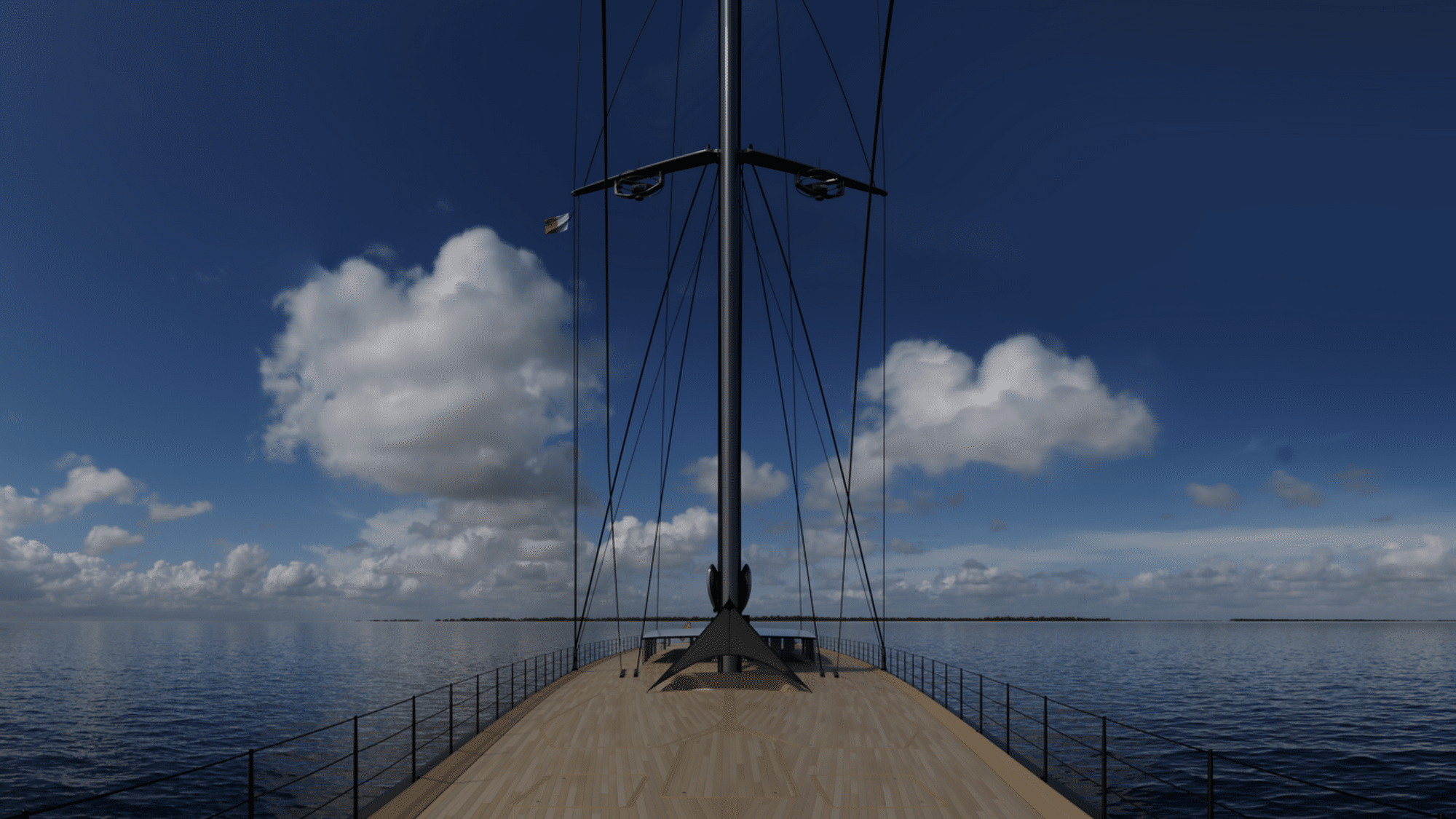
THE HEIGHT OF ELEGANCE
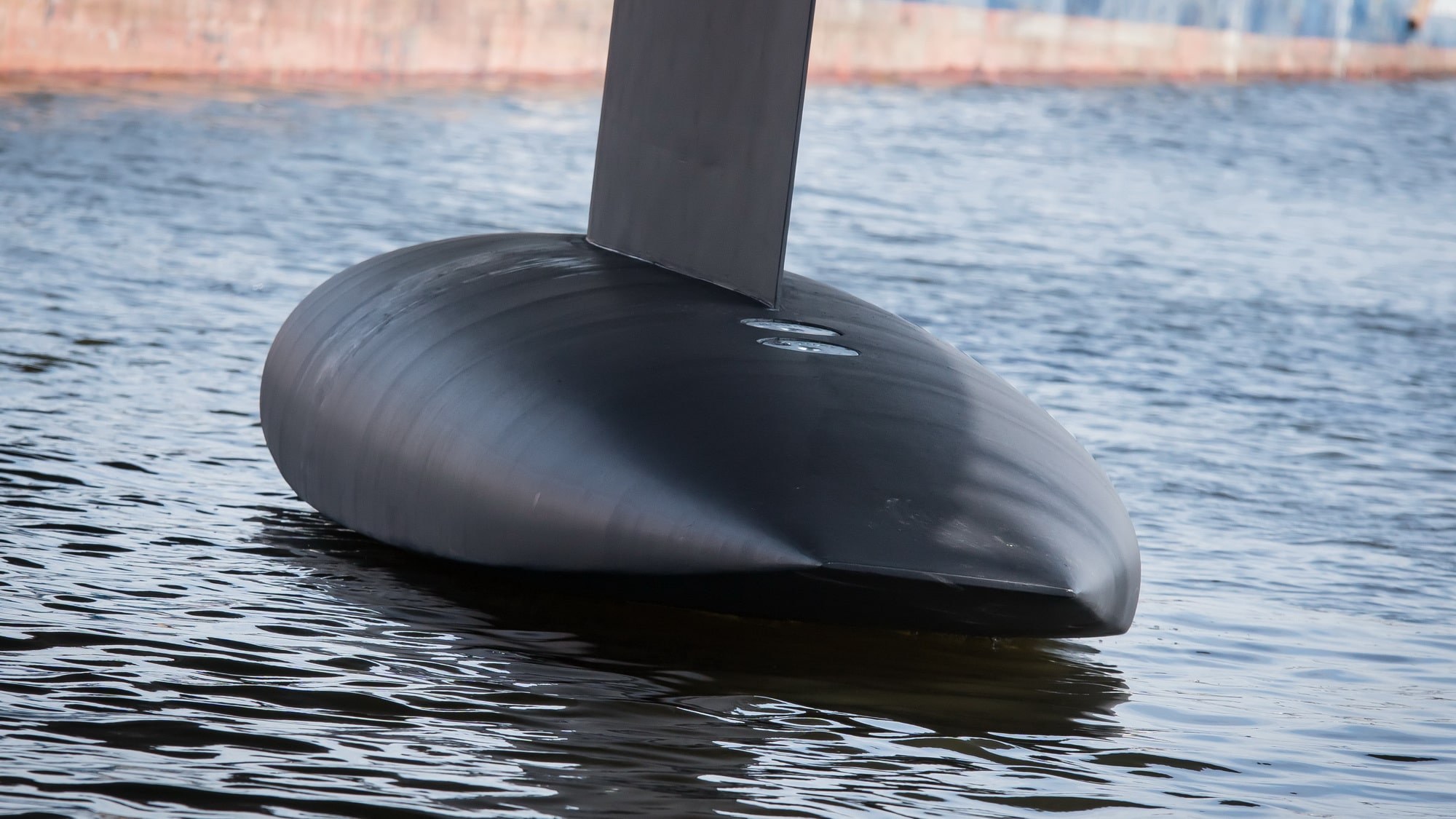
PERFORMANCE, COMFORT AND SECURITY

RIG AND SAILING SYSTEMS BY RONDAL

AT SEA, UNDER SAIL
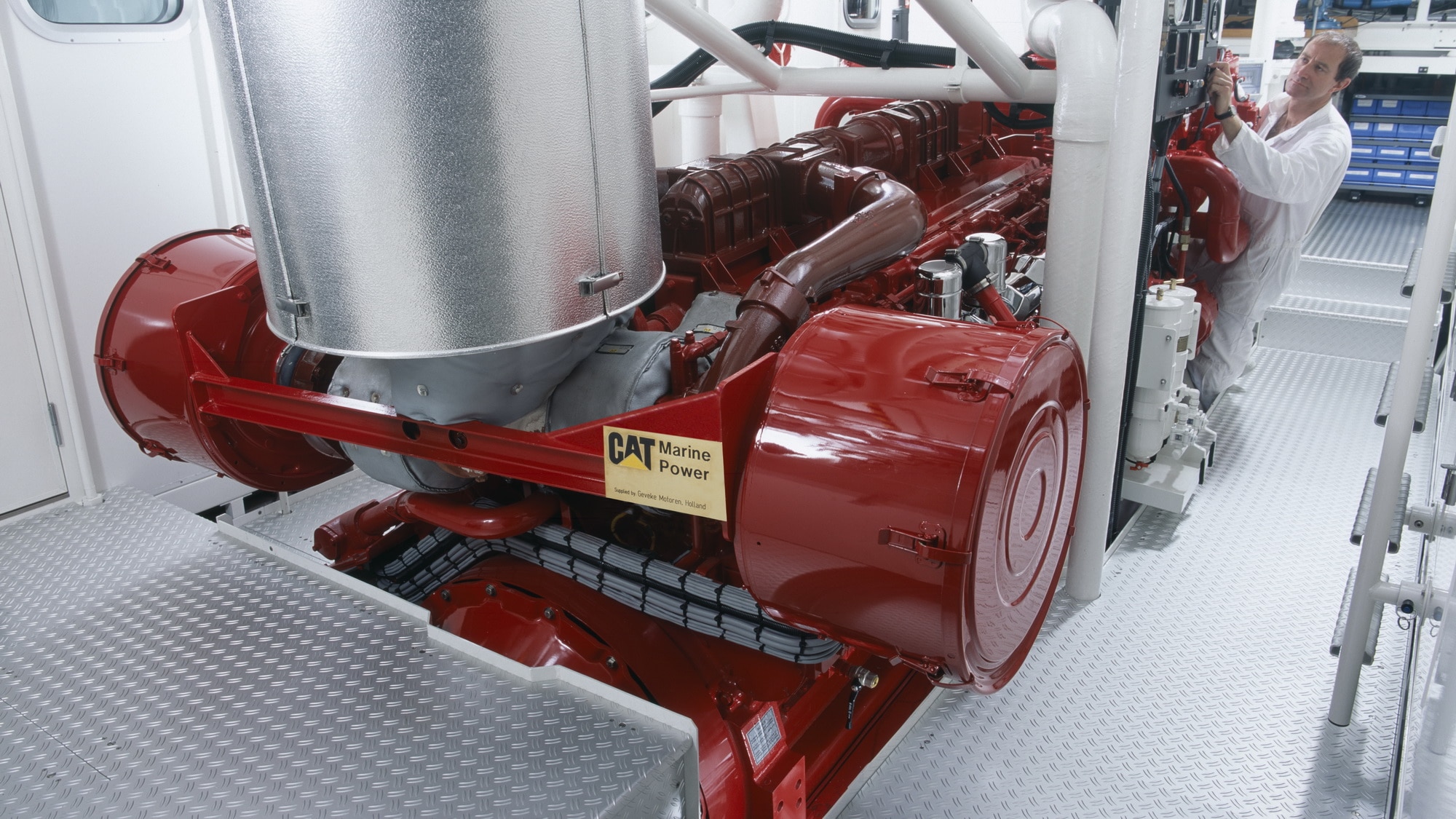
PROPULSION AND ENERGY MANAGEMENT
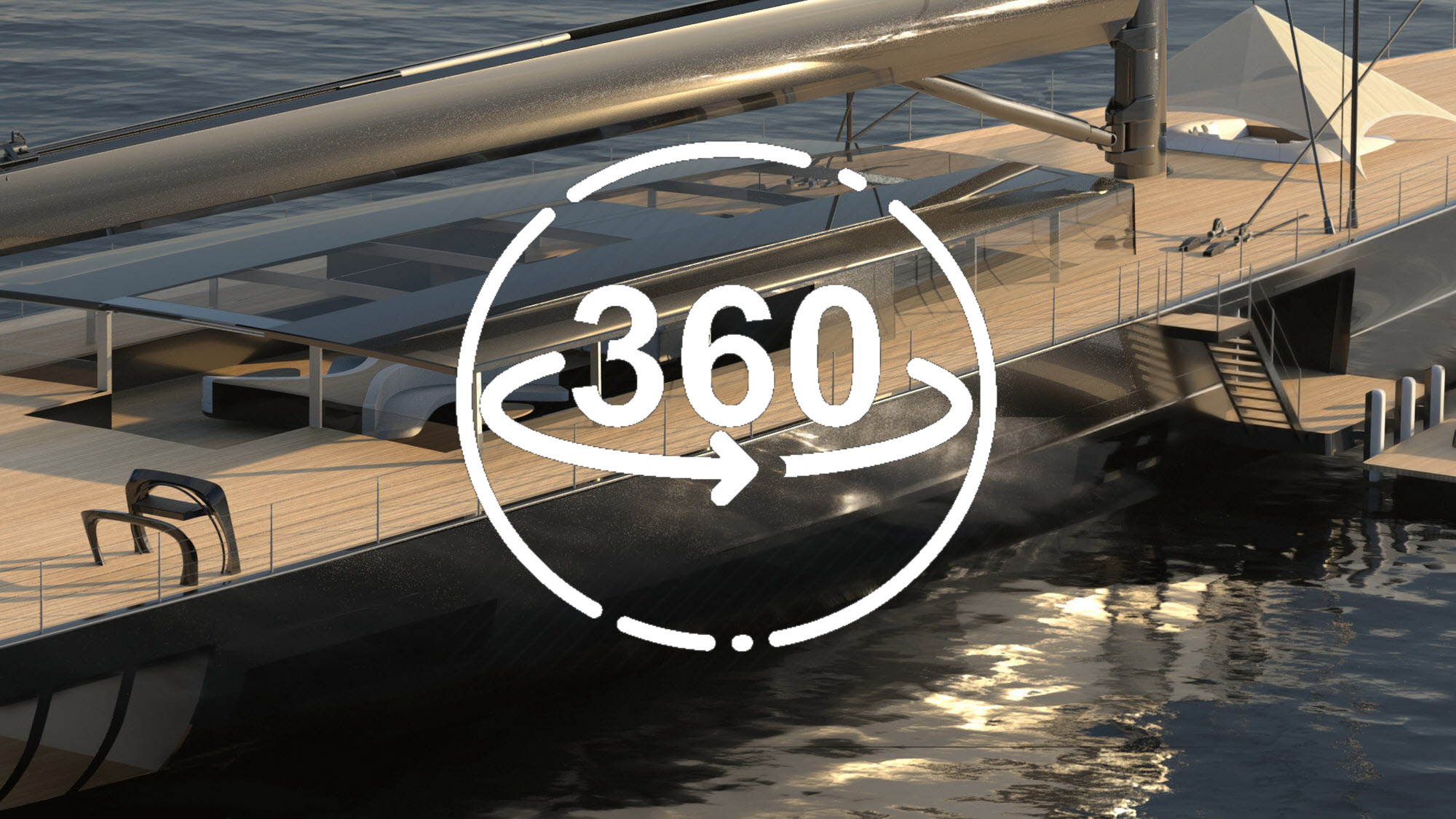
360 VR TOUR

MAIN SPECIFICATIONS
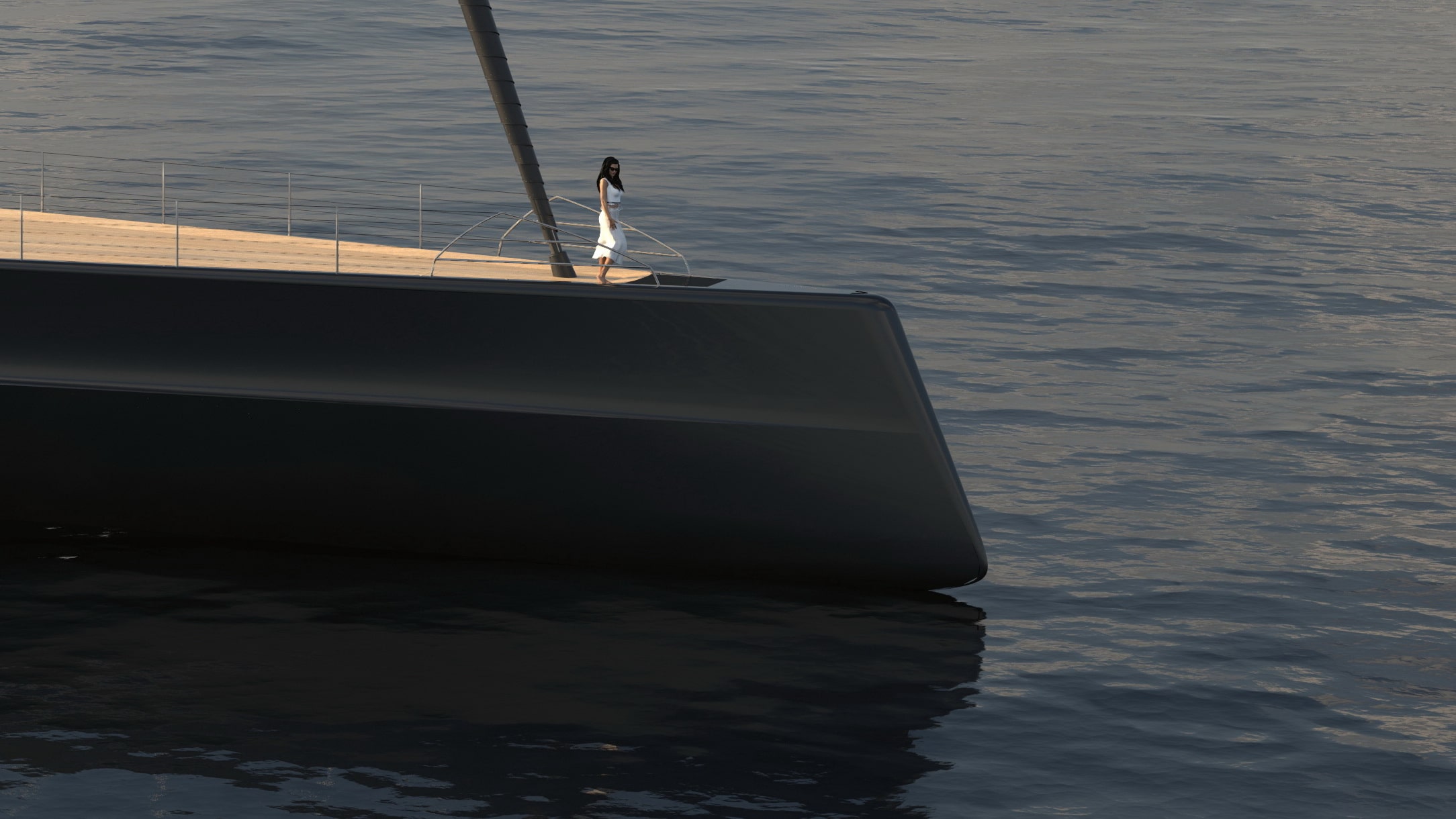
YOUR INDIVIDUAL DREAM

One of the nice things about fashioning successful yachts from across the design spectrum is the leeway it gives to blend ideas. This sleek 133-foot sloop is a superb example as she has a hull shape somewhere in-between Aphrodite I and Bharlin Blue, yet the design is not as plumb-bowed as Aphrodite II and has a narrower stern than Temptation. The original client intended to explore remote areas, hence the inclusion of a distinctive pilot house concept with wraparound windows, within which is incorporated a navigation station and breakfast area. The interior layout also includes an upper saloon with formal dining room, a lower multimedia lounge and three guest suites. Impressive as these areas are, the pièce de résistance below decks is a giant owner's stateroom with walk-in wardrobes. Although changed circumstances forced a rethink for the client, this design simply must take physical shape in the near future. Contact [email protected] for more details.
LOA 40.5 m LWL 35.4 m Beam 8.7 m Draft 1.8 - 4.0 m Sail Area 715 m2


Big Class Yachts
Cruising yachts, j-class yachts, square rigged ships, miscellaneous.
- Motor Yachts

51 M Project Rain...
51 m project rainbow ....

65 M Aquarius II

69 m Project ZERO

81 M Sea Eagle

Aurelius (ex Anna...
Aurelius (ex annagine....

Aurelius (ex Annagine)
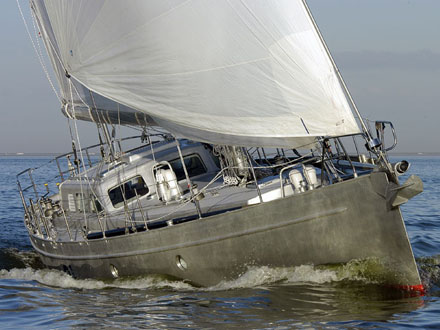
Bestevaer 2

Bestevaer 3
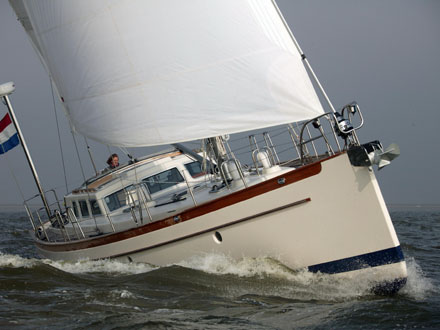
Bestewind 50

Black Pearl

Borkumriff IV

Cisne Branco

Dream Symphony

Geluksvogel

JH2 Rainbow

JK3 Shamrock V

JK4 Endeavour

JK6 Hanuman

JK7 Velsheda

Maltese Falcon

Mikhail S Voronts...
Mikhail s vorontsov.

MY Bestevaer 53

Perseverance

Perseverance 1

Rainbow Warrior I...
Rainbow warrior iii.

Rapsody R110

Sea Bridge One

Shabab Oman II

Stad Amsterdam
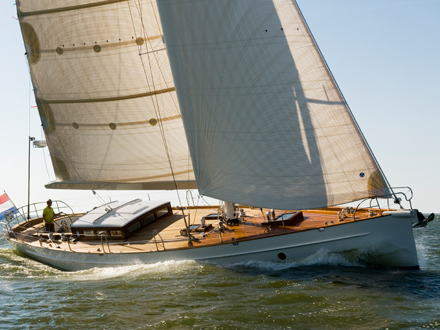
WASP (Ecoliner)

Windjammer Project

Windrose of Amste...
Windrose of amsterdam.

Full list of Designs
Dykstra Naval Architects' designed yachts, vessels and concept designs throughout the years:
- New Sailboats
- Sailboats 21-30ft
- Sailboats 31-35ft
- Sailboats 36-40ft
- Sailboats Over 40ft
- Sailboats Under 21feet
- used_sailboats
- Apps and Computer Programs
- Communications
- Fishfinders
- Handheld Electronics
- Plotters MFDS Rradar
- Wind, Speed & Depth Instruments
- Anchoring Mooring
- Running Rigging
- Sails Canvas
- Standing Rigging
- Diesel Engines
- Off Grid Energy
- Cleaning Waxing
- DIY Projects
- Repair, Tools & Materials
- Spare Parts
- Tools & Gadgets
- Cabin Comfort
- Ventilation
- Footwear Apparel
- Foul Weather Gear
- Mailport & PS Advisor
- Inside Practical Sailor Blog
- Activate My Web Access
- Reset Password
- Customer Service

- Free Newsletter

What You Can Learn on a Quick Test Sail

Cabo Rico’s Classic Cutter

Bob Perrys Salty Tayana 37-Footer Boat Review

Tartan 30: An Affordable Classic

Preparing Yourself for Solo Sailing

Your New Feature-Packed VHF Radio

Preparing A Boat to Sail Solo

Solar Panels: Go Rigid If You have the Space…

When Should We Retire Dyneema Stays and Running Rigging?

Rethinking MOB Prevention

Top-notch Wind Indicators

The Everlasting Multihull Trampoline

Taking Care of Your 12-Volt Lead-Acid Battery Bank

Hassle-free Pumpouts

What Your Boat and the Baltimore Super Container Ship May Have…

Check Your Shorepower System for Hidden Dangers

Waste Not is the Rule. But How Do We Get There?

How to Handle the Head

The Day Sailor’s First-Aid Kit

Choosing and Securing Seat Cushions

How to Select Crew for a Passage or Delivery

Re-sealing the Seams on Waterproof Fabrics

Waxing and Polishing Your Boat

Reducing Engine Room Noise

Tricks and Tips to Forming Do-it-yourself Rigging Terminals

Marine Toilet Maintenance Tips


Learning to Live with Plastic Boat Bits
- Sailboat Reviews
Practical Sailor Takes a Look at Trends in Modern Boat Design
Is the quest for speed and interior comfort trumping smart design in todays sailboats.
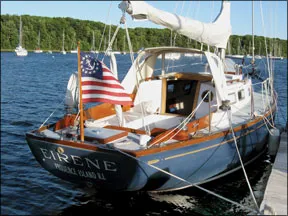
Practical Sailor editors have noticed the increasing tendency in newer-model sailboats to be ill-mannered in gusty conditions. Establishing balance between the sails and the hull is one of the main factors in quality boat design. For correct trim, many things must be considered: the ballast package location, the combined longitudinal center of gravity (LCG), and the longitudinal center of buoyancy. At the same time, to maintain a balanced helm, the keel must promote sufficient lead (the fore and aft distance between the center of effort and the center of lateral resistance). To highlight how these boat design principles play out, Practical Sailor looks at classic sailboats such as the Bill Shaw-designed Pearson 32, Ericson 41, Valiant 40, and Peterson 44, and compares their keel/sail ratios and lead values to more modern sailboat designs such as the Catalina, Hunter, Tartan, and Beneteau.
In the course of taking out boats for testing, Practical Sailor editors have observed an increased tendency for new-model sailboats to be ill-mannered in gusty conditions. We have been watching this trend for several years, and it seems to be becoming more usual than unusual.
In a typical situation, we will be sailing the test boat on the wind in 12 or so knots of breeze and everything is fine. Then, the breeze picks up to about 15 knots and the helm loads up. OK, thats to be expected, so we flatten the main, drop down the traveler, and that takes care of it.
Then we get a puff. Were already on the point of needing to reef, so in the puff, were overcanvassed. Instead of just heeling farther, the boat begins to round up. Fighting it with the helm is hard work, and easing the main so it luffs doesn’t help much.
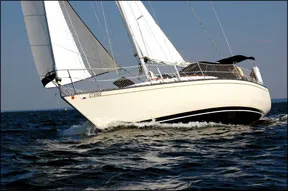
Photo by Ralph Naranjo
We take in a reef, which usually means we roll in a bit of the jib or a bit of the main, or both, and the helm lightens up. We trim to the new wind and sail along, a bit slower now in the light spots, but then the next gust comes along, and the helm immediately loads up again.
In the worst case weve experienced, the boat rounded up so quickly that it tacked, even though the helm was hard over in the opposite direction. To prove that wasnt a fluke caused by a temporary diversion into a parallel universe, it did the same thing on the other tack.
Practical Sailor editors are old enough to remember a generation of cruising boats that didnt behave in this manner. For sure, there have always been twitchy boats, but most, when hit by a gust, would heel a little more, put some pressure on the wheel or tiller, and once the boat picked up speed, the pressure would come right off. A boat like that will sail for a long time with a loose lashing on the helm.
So, where does this bad habit come from? Several trends in modern cruising yacht design can share the blame. One of them is builders inclination to tilt their designs toward the performance end of the cruisers spectrum. Many recent and current cruising boats, if suitably fitted out with racing sails and the hardware and software to tweak them, could put up an impressive show on the race course.
The sensitivity to trim that accompanies such potential isn’t always suited to cruising shorthanded or with a family, when balance and good manners are key both to enjoyment and, to a degree, safety.
Establishing Balance
Many factors contribute to the balance of a sailboat. The obvious and principal pair are the sails and the hull. When working up a new design, the architect develops these in close association, but both are in turn influenced by other aspects of the boats design as it evolves.
In the standard approach, the designer works up preliminary drawings to express the basic requirements of the design brief, which normally include a desired length, displacement, cabin arrangement, and sailplan to provide the desired performance.
He then sketches out the hull lines (the matrix of contours that define its three-dimensional shape and its volume) to enclose the interior and meet expressed performance goals. The preliminary lines also serve as a basis on which to perform a number of calculations, one of them being the location of the center of buoyancy (CB).
With everything roughed out, the designer then “weighs” every item that will go into the complete boat, from the hull laminate to the toothbrush holder, but excluding the ballast. He combines these weights and their locations on the three axes, X, Y, and Z, to calculate the center of gravity (CG) of the whole package. Computer programs have helped to speed up this process and make volume calculations more accurate, but the process hasn’t changed much.
For the boat to float on its desired lines, the ballast package must then be designed and located to bring the combined longitudinal CG (LCG) of hull and ballast to the same fore-and-aft location as the CB (LCB). Once everything has been resolved satisfactorily, the designer can finalize the lines, carry out the necessary calculations, and establish shape and locations for the keel and the sailplan.
On most boats of current design, the ballast also constitutes the fin keel, and in that role, its location determines the center of lateral resistance (CLR), which in conjunction with the center of effort (CE) of the sailplan, influences how the boat balances under sail.
Even as boat design procedures have evolved from three-dimensional modeling using half hulls, through two-dimensional modeling using pen on vellum, to three-dimensional virtual modeling on computers, the fundamental principles have remained constant. One of the fundamental values used for predicting the proclivities of a boats helm is the dimension termed “lead.” Lead, pronounced “leed,” is the fore and aft distance between the CE and the CLR, expressed as a percentage of the waterline length (DWL).
“Skenes Elements of Yacht Design,” as revised by Francis S. Kinney, and other references for yacht design provide rules of thumb for calculating lead from the sailplan and the hull profile. (See illustration above).
Looking at the diagram, its easy to see how lead is an elusive quantity. First of all, no boat sails with the sailplan as shown-the sails are never flat and on centerline. The traditional range for lead places the CE forward of the CLR by 14 to 19 percent of DWL. This value is lifted from “Skenes,” for years the first reference for any designer. Since that book was written and updated, hull forms have changed, and with them, optimum values for lead.
On designs with fin keels, lead is often calculated with reference to the keel alone. One feature remains constant whatever the design. Moving the centers closer together-reducing lead-increases the tendency to weather helm. Moving them apart reduces that tendency. If the lead is too great, the result may be lee helm, which is generally considered undesirable-and is in fact, rare.
In Kinneys prime years, the 1960s to the 1980s, the basic working sailplan of a sloop included a 150-percent genoa, which would have the effect of moving the CE closer to the CLR. Many designs today have headsails with short or even no overlap and very often a full-battened mainsail with lots of roach. The different aerodynamic characteristics of such rigs might well affect optimum lead, something which designers can only determine through experience. (If a boatbuilder offers an in-mast furling mainsail as an option, its effect on lead will differ from that of the “classic” sailboat.)
The effective CLR can also be very different from that calculated. On a deep-bodied, full-keel hull, that difference simply might be the difference between the geometric center and the center of hydrodynamic pressure of the whole profile.
A sharp bow with a pronounced “chin” might well move the effective CLR forward. On a modern, fin-keeled boat with a shallow, broad canoe body like that of a dinghy, the keel makes a proportionately larger contribution to lateral resistance, so the location of the keel will strongly influence where that resistance operates.
Obviously the rudder, too, is part of the lateral plane, but if our objective is to sail with light to neutral pressure on the helm, under normal conditions, it should not be making a significant contribution to lateral resistance. Its role is to provide a means to change the boats direction and to compensate for the constant fluctuations in the forces applied to the boat in the normal course of sailing. A certain amount of pressure in the form of weather helm helps by providing positive feedback to the helmsman on the state of balance. That said, on many racing hulls, the rudder is designed to contribute lift and has an active role in driving the boat to windward. (It is worth noting that those wide-bodied race boats also tend to have twin rudders.)
Then and Now
Even in the age of computer modeling, yacht design remains a series of compromises. At the moment, it seems the pendulum has swung to a point where high-volume, wide-beam shapes dominate. With them come large rigs to overcome skin drag and its negative effect in light air. As a result, theres a need to sail the vessel as flat as possible or suffer the consequences.
The sailplan and outboard profiles of boats from different eras represent the shift in yacht design that has occurred during recent decades. The modern boats have longer proportional waterlines, indicating higher potential speed. It also means that the boats immersed volume, or displacement, has been distributed over a greater length.
Given two boats of similar displacement like the classic Pearson 32 and the modern Tartan 3400 (above), the Tartan winds up with a shallower canoe body. This also contributes to its being potentially faster and, if both boats had the same draft, would give the keel a slight advantage in span, and therefore effectiveness to windward.
So far so good, but a shallower canoe body forces the cabin sole upward, especially if the belowdecks accommodations are to take full advantage of the wide beam favored in the modern hull. To achieve comparable headroom with its older counterpart, the cabintop has to go up, too, and to ensure sitting headroom on the settees under the sidedeck, so does the freeboard.
Ultimately, the whole deck moves upward. To ensure the boom doesn’t sweep everybody out of the cockpit during an unplanned jibe, the boom too goes up. If sail area is not to be compromised, the entire mainsail goes up, and with it, its center of effort. The bigger the boat, the less pronounced these differences become as the proportions become more relaxed.
Differences are visible, too, between the boats keels; the modern Tartans is smaller in area. While it might be claimed that less wetted surface promises higher sailing speeds in light air, some builders accept a smaller keel to simplify the manufacture of the hull.
In a perfect world, the designer draws a keel to suit the boats sail area and other characteristics, places it to obtain the desired sailing performance, then massages the needed ballast to both fit the keel and trim the boat correctly. The volume of the ballast is usually less than that of the keel, and the builder has to do some intricate laminating work to mold a keel to receive ballast internally or a stub to which to bolt it externally.
On many production boats today, the keels are bolted directly to the bottom of a fair canoe body, a practice which eliminates much labor. The consequence is that the area of the keel is determined by the weight, and therefore the volume, of the ballast. To achieve the desired hydrodynamic properties and mechanical strength-it mustnt bend under the influence of normal sailing loads-a given volume of ballast can be formed into a limited range of shapes. Placing ballast in a bulb at the bottom aids the keels efficiency by creating an endplate effect and raises stiffness by placing ballast low, but it means that the keels lateral plane is sharply reduced.
For a more dramatic representation of how changes in keel design can affect helm balance, compare a Cruising Club of America (CCA) design like the Ericson 41 above, to a modern equivalent with comparable sail area like the Beneteau 46.
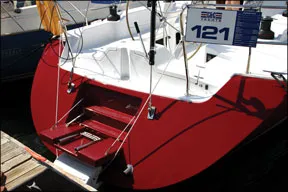
When sailing, two boats are subjected to similar forces on the sails. Resisting that side force are the immersed hull, the keel, and the rudder. If the hulls offer similar resistance, the remaining force is shared between the keel and rudder. If one keel is smaller than the other (as is clearly the case here), the effect is to increase the share taken by the rudder.
When the sails are trimmed properly and all is in balance, the rudder will carry a small load. If however, you hit a gust, the rudder must pick up a high proportion of the added side thrust until balance is restored, usually by some adjustment to sail trim.
Simply put, boats of the general modern type are not forgiving in changeable conditions, say, for example when the apparent wind is in the 12- to 18-knot range. At the higher end, youd want to be reefed; at the lower end, probably not.
On a day when you expect the wind to soften rather than harden, youd rather not put in the reef, so that you can maintain speed in the lulls. In the puffs, you want your hands free to ease the traveler and flatten the jib, which is hard to do if the helm is a handful. Compounding the problem on most boats, the mainsail controls are usually not within reach of the helm.
On racing boats, such sensitivity isn’t an issue. On the contrary, sufficient crew are on hand to make adjustments on the fly as quickly and often as needed to keep the boat sailing at her fastest.
Cruising boats are often sailed shorthanded and by crews who are not looking for a constant physical workout. An autopilot might be doing most of the steering, and good balance is helpful in protecting it from having to work too hard-or from being overpowered.
Another striking difference between the older and newer designs is visible in the plan (overhead) view. By 1980, cruising-boat hulls were already becoming beamy relative to boats of the 1960s and 1970s. The current trend is to carry the beam aft, so that in the region of the rudder, its as much as 85 percent of the maximum beam, far wider than the 55 percent to 60 percent once considered acceptable. The principal beneficiary of this extra breadth is the boats interior-builders often offer twin double cabins aft where a generation ago they might have squeezed in a quarter berth and a cockpit locker. The cockpit, too, becomes roomier, and the transom, scooped and sculpted, is transformed into a swim platform and dinghy dock.

Photo by Jarrod Scanlon
All this additional boat aft adds weight aft, in both construction materials and outfit. To compensate, the ballast-that is to say, the keel-has to be fitted farther forward.
The full beam aft does provide a significant boost to the boats ability to carry sail. As the boat heels, the center of buoyancy moves quickly outboard, away from the center of gravity. This lengthens the righting arm, giving a positive contribution toward stability, but it also moves the immersed centerline of the hull away from the static centerline along which both the keel and the rudder are attached. Depending on the hulls shape, this can create a distortion in the immersed volume, which can in turn affect the dynamics acting on it.
Effect of Keel Area
Another factor entering the equation is the area of the keel. This, too, is apparent when comparing the drawings of the older and newer generation boats. Many of the standard tracts on the design of sailing yachts are, lets say, vague on what keel area is adequate or even desirable, although many designers have come up with their own formulas.
Because the keel is reacting in the water to forces generated on the sails by the wind, it makes sense that the area of a fin keel should be related in some way to sail area.
When naval architect Dave Gerr took over as director of the Westlawn Institute of Marine Technology, he found the course materials for sailing yacht design had little detailed explanation on this topic, a gap he subsequently filled. Briefly, he recommends no fin keel should be less that 2.5 percent of the sail area (mainsail 100 percent foretriangle) and need be no more than 5 percent. The smaller value is appropriate for a racing boat with a full crew aboard to trim and tweak the sails to every change in the wind. The larger area is suited to cruising boats, which need to be more forgiving to shorthanded crews.
Current Design Trends
In the past, racing measurement rules have been criticized because the boats designed to compete under them have become type-formed, sometimes with unwelcome consequences in how they handle. We might just as easily level criticism at present-day marketing and manufacturing methods for doing the same to cruising boats.
Lets face it, but for a few differences in sailplans and keel shapes, modern cruising sailboats are quite generic below the sheerline. They are all beamy; they carry their beam aft; they have long waterlines; they have dinghy-like underbodies; and they have spade rudders. The forces that have created this shape have at least as much to do with how many people can sleep and shower in them comfortably as with how the boats will sail.
Dishing out the hull shape in this manner makes it fairly easy to push through the water, but arranging the keel, rudder, and sails so they work in concert has become a more complex problem, exacerbated by having to compensate for extra weight of accommodations aft, something thats less of an issue in raceboats.
The byproduct of these design parameters is zesty performance, a bonus for the marketing department, but speed for its own sake is not the first priority of cruising sailors. In the brochure for the Beneteau 37, the boats polar diagram shows a maximum theoretical sailing speed of over 12 knots in 30 knots of wind. When cruising sailors encounter 30-knot winds, they are more likely to hunker down in the expectation it will blow even harder than they are to set the chute to go surfing. What they want is a boat that will take readily to hunkering, and all the signs indicate those boats are getting fewer in number . . . and they are mostly older designs.
- The Balancing Act
- Pearson 32 vs. Tartan 3400
- Ericson 41 vs. Beneteau 46
- Practical Sailor Design Guide
- The Modern Hull and Helm Balance
RELATED ARTICLES MORE FROM AUTHOR
Leave a reply cancel reply.
Log in to leave a comment
Latest Videos

The Great Loop – The Basics

Bottom Paint Showdown – Six Paints, One Winner!

Tartan 30 | Boat Review

Fuel Contamination? The Baltimore Francis Key Bridge Collapse
- Privacy Policy
- Do Not Sell My Personal Information
- Online Account Activation
- Privacy Manager

- About Chuck Paine Yacht Design
- THE FULL CIRCLE 30
- 26’ FRANCES. A small double-ended cruiser.
- THE LEVANT 15
- Much more about the LEVANT 15
- 24′ Double-ended voyager CAROL
- BELLA LUNA- A Chuck Paine perfected Herreshoff Alerion
- THE PAINE DVT
- The Paine 14 – A Herreshoff – inspired daysailor
- Lots More about the PAINE 14
- My Yacht Designs: The Book
- Designs I’ve Loved!
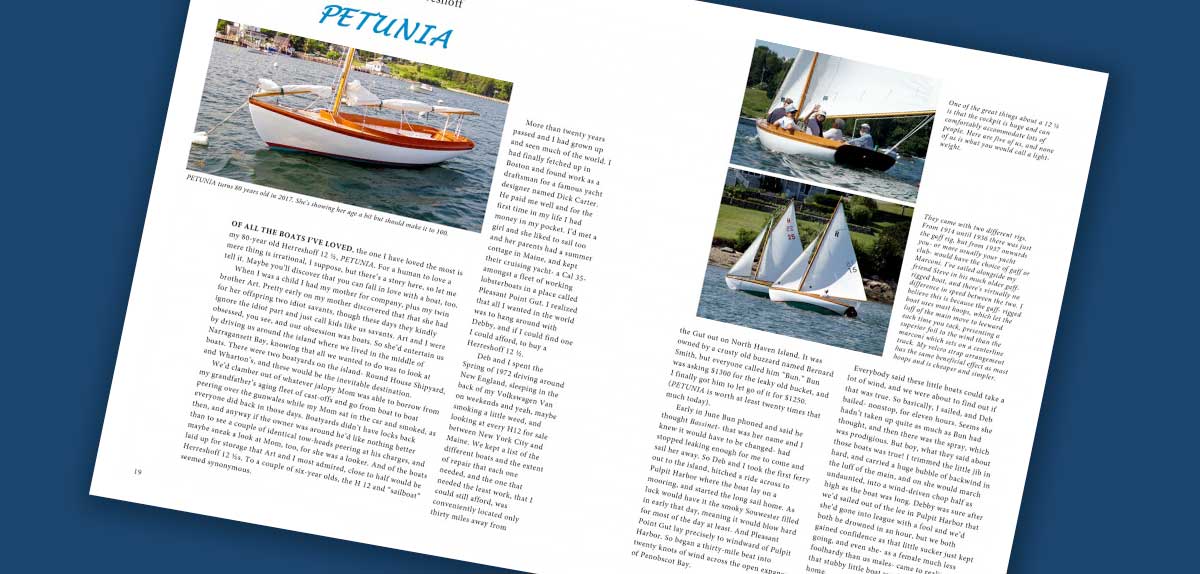
Welcome to Chuck Paine’s new website. Chuck Paine has been designing and building yachts for over 60 years. He has been the chief designer for many of the world’s highest quality yacht builders. Morris Yachts, Lyman-Morse Boatbuilding, Cabo Rico Yachts, Able Marine, York Marine and French & Webb in America, Bowman and Victoria Yachts in the UK, Kanter in Canada, Kelly Archer in New Zealand, and Gouwerok in Holland are a few examples of high-end yachtbuilders who have built more than 1000 individual yachts to Paine designs.
It has not escaped Chuck’s notice of late that the majority of large yachts today spend their lives unused in marinas, incurring slip fees and maintenance expenses without providing any enjoyment to their owners. Only the smaller, easily singlehanded boats seem to be used on sparkling summer weekends.
So in the past few years, Chuck has devoted his talents to a new era in yacht design: designing and building small, elegant, easily usable, classic sailboats with eternal appeal, affordable in view of their gemstone quality; but like all of his oeuvre to date, devoid of any pretense of being cheap. This site provides access to Chuck’s archive of yacht designs and highlights the growing portfolio of small, easily maintained and easily gotten going sailboat designs he is focusing on these days.
With a lifetime of experience to guide him, Chuck has written two books which should be of interest to students of yacht design. While one is regrettably out of print, the more recent book can be purchased in printed form, and both are instantly available as digital downloads from this website. Read these books, forget the headlines, put on plenty of sunscreen, and go sailing!
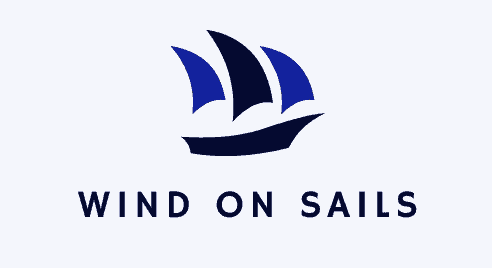
The Ultimate Guide to Sail Boat Designs: Exploring Sail Shape, Masts and Keel Types in 2023
- June 4, 2023

When it comes to sail boat designs, there is a wide array of options available, each with its own unique characteristics and advantages. From the shape of the sails to the number of masts and the type of keel, every aspect plays a crucial role in determining a sailboat’s performance, stability, and manoeuvrability. In this comprehensive guide, we will delve into the fascinating world of sail boat designs, exploring the various elements and their significance.
Table of Contents
The sail shape is a fundamental aspect of sail boat design, directly impacting its speed, windward performance, and maneuverability. There are several types of sail shapes, including:
1. Bermuda Rig:
The Bermuda rig is a widely used sail shape known for its versatility and performance. It features a triangular mainsail and a jib, offering excellent maneuverability and the ability to sail close to the wind. The Bermuda rig’s design allows for efficient use of wind energy, enabling sailboats to achieve higher speeds. The tall, triangular mainsail provides a larger surface area for capturing the wind, while the jib helps to balance the sail plan and optimize performance. This rig is commonly found in modern recreational sailboats and racing yachts. Its sleek and streamlined appearance adds to its aesthetic appeal, making it a popular choice among sailors of all levels of experience.
2. Gaff Rig:
The Gaff rig is a classic sail shape that exudes elegance and nostalgia. It features a four-sided mainsail with a gaff and a topsail, distinguishing it from other sail designs. The gaff, a horizontal spar, extends diagonally from the mast, providing additional area for the mainsail. This configuration allows for a taller and more powerful sail, making the Gaff rig particularly suited for downwind sailing. The Gaff rig offers a traditional aesthetic and is often found in vintage and classic sailboats, evoking a sense of nostalgia for a bygone era of maritime exploration. The distinctive shape of the Gaff rig, with its graceful curves and intricate rigging, adds a touch of timeless charm to any sailboat that dons this rig.
3. Lateen Rig:
The Lateen rig is a unique and versatile sail design that has been used for centuries in various parts of the world. It features a triangular sail that is rigged on a long yard, extending diagonally from the mast. This configuration allows for easy adjustment of the sail’s angle to catch the wind efficiently, making the Lateen rig suitable for a wide range of wind conditions. The Lateen rig is known for its ability to provide both power and maneuverability, making it ideal for small to medium-sized sailboats and traditional vessels like dhow boats. Its versatility allows sailors to navigate narrow waterways and make tight turns with ease. The distinctive silhouette of a sailboat with a Lateen rig, with its sleek triangular sail and graceful curves, evokes a sense of adventure and a connection to seafaring traditions from around the world.
Number of Masts
The number of masts in a sail boat design affects its stability, sail area, and overall performance. Let’s explore a few common configurations:
1. Sloop Rig:
The sloop rig is one of the most popular and versatile sail boat designs, favoured by sailors around the world. It consists of a single mast and two sails—a mainsail and a jib. The sloop rig offers simplicity, ease of handling, and excellent performance across various wind conditions. The mainsail, situated behind the mast, provides the primary driving force, while the jib helps to balance the sail plan and improve manoeuvrability. This configuration allows for efficient upwind sailing, as the sails can be trimmed independently to optimize performance. The sloop rig is commonly found in modern recreational sailboats due to its versatility, enabling sailors to enjoy cruising, racing, or day sailing with ease. Its streamlined design and sleek appearance on the water make it both aesthetically pleasing and efficient, capturing the essence of the sailing experience.
2. Cutter Rig:
The cutter rig is a versatile and robust sail boat design that offers excellent performance, especially in challenging weather conditions. It features a single mast and multiple headsails, typically including a larger headsail forward of the mast, known as the cutter rig’s distinguishing feature. This configuration provides a wide range of sail combinations, enabling sailors to adjust the sail plan to suit varying wind strengths and directions. The larger headsail enhances the boat’s downwind performance, while the smaller headsails offer increased flexibility and improved balance. The cutter rig excels in heavy weather, as it allows for easy reefing and depowering by simply reducing or eliminating the headsails. This design is commonly found in offshore cruising sailboats and has a strong reputation for its reliability and seaworthiness. The cutter rig combines versatility, stability, and the ability to handle adverse conditions, making it a preferred choice for sailors seeking both performance and safety on their voyages.
3. Ketch Rig:
The Ketch rig is a sail boat design characterized by the presence of two masts, with the main mast being taller than the mizzen mast. This configuration offers a divided sail plan, providing sailors with increased flexibility, balance, and versatility. The main advantage of the Ketch rig is the ability to distribute the sail area across multiple sails, allowing for easier handling and reduced stress on each individual sail. The mizzen mast, positioned aft of the main mast, helps to improve the sailboat’s balance, especially in strong winds or when sailing downwind. The Ketch rig is often favoured by cruisers and long-distance sailors as it provides a range of sail combinations suitable for various wind conditions. With its distinctive double-mast appearance, the Ketch rig exudes a classic charm and is well-regarded for its stability, comfort, and suitability for extended journeys on the open seas.
The keel is the part of the sail boat that provides stability and prevents drifting sideways due to the force of the wind. Here are some common keel types:
1. Fin Keel:
The fin keel is a popular keel type in sail boat design known for its excellent upwind performance and stability. It is a long, narrow keel that extends vertically from the sailboat’s hull, providing a substantial amount of ballast to counterbalance the force of the wind. The fin keel’s streamlined shape minimizes drag and enables the sailboat to cut through the water with efficiency. This design enhances the sailboat’s ability to sail close to the wind, making it ideal for racing and performance-oriented sailboats. The fin keel also reduces leeway, which refers to the sideways movement of the boat caused by the wind. This improves the sailboat’s ability to maintain a straight course and enhances overall manoeuvrability. Sailboats with fin keels are commonly found in coastal and offshore racing as well as cruising vessels, where stability and responsiveness are valued. The fin keel’s combination of performance, stability, and reduced leeway makes it a preferred choice for sailors seeking speed and agility on the water.
2. Full Keel:
The full keel is a design known for its exceptional stability and seaworthiness. It extends along the entire length of the sailboat, providing a continuous surface that adds substantial weight and ballast. This configuration offers significant advantages in terms of tracking and resistance to drifting sideways. The full keel’s deep draft helps to prevent leeway and allows the sailboat to maintain a steady course even in adverse conditions. Its robust construction enhances the sailboat’s ability to handle heavy seas and provides a comfortable ride for sailors on extended journeys. While full keel sailboats may sacrifice some manoeuvrability, their stability and predictable handling make them a popular choice for offshore cruising and long-distance voyages. The full keel design has stood the test of time and is often associated with classic and traditional sailboat aesthetics, appealing to sailors seeking reliability, comfort, and the ability to tackle challenging ocean passages with confidence.
3. Wing Keel:
The wing keel is a unique keel design that offers a combination of reduced draft and improved stability. It features a bulbous extension or wings on the bottom of the keel, which effectively increases the keel’s surface area. This design allows sailboats to navigate in shallower waters without sacrificing stability and performance. The wings create additional lift and prevent excessive leeway, enhancing the sailboat’s upwind capabilities. The reduced draft of the wing keel enables sailors to explore coastal areas and anchor in shallower anchorages that would be inaccessible to sailboats with deeper keels. The wing keel is particularly well-suited for sailboats in areas with variable water depths or tidal ranges. This keel design offers the advantages of increased manoeuvrability and improved performance while maintaining stability, making it a popular choice for sailors seeking versatility in a range of sailing environments.
In the vast world of sail boat designs, sail shape, number of masts, and keel types play pivotal roles in determining a boat’s performance and handling characteristics. Whether you’re a recreational sailor, a racer, or a cruiser, understanding these design elements can help you make informed choices when selecting a sailboat.
Remember to consider your specific needs, preferences, and intended use of the boat when choosing a sail boat design. Each design has its strengths and weaknesses, and finding the perfect combination will greatly enhance your sailing experience.
By gaining a deeper understanding of sail boat designs, you can embark on your next sailing adventure with confidence and make the most of the wind’s power.
Related Posts

Sailing Navigation: Exploring Modern Techniques for Navigating the Seas in 2023
- June 10, 2023

Sailing in Different Directions: Harnessing the Wind’s Power in 2023

Sailing Terms Demystified: A Comprehensive Guide to 14 Common Sailing Terminology
- May 28, 2023
grundig yacht boy p 2000
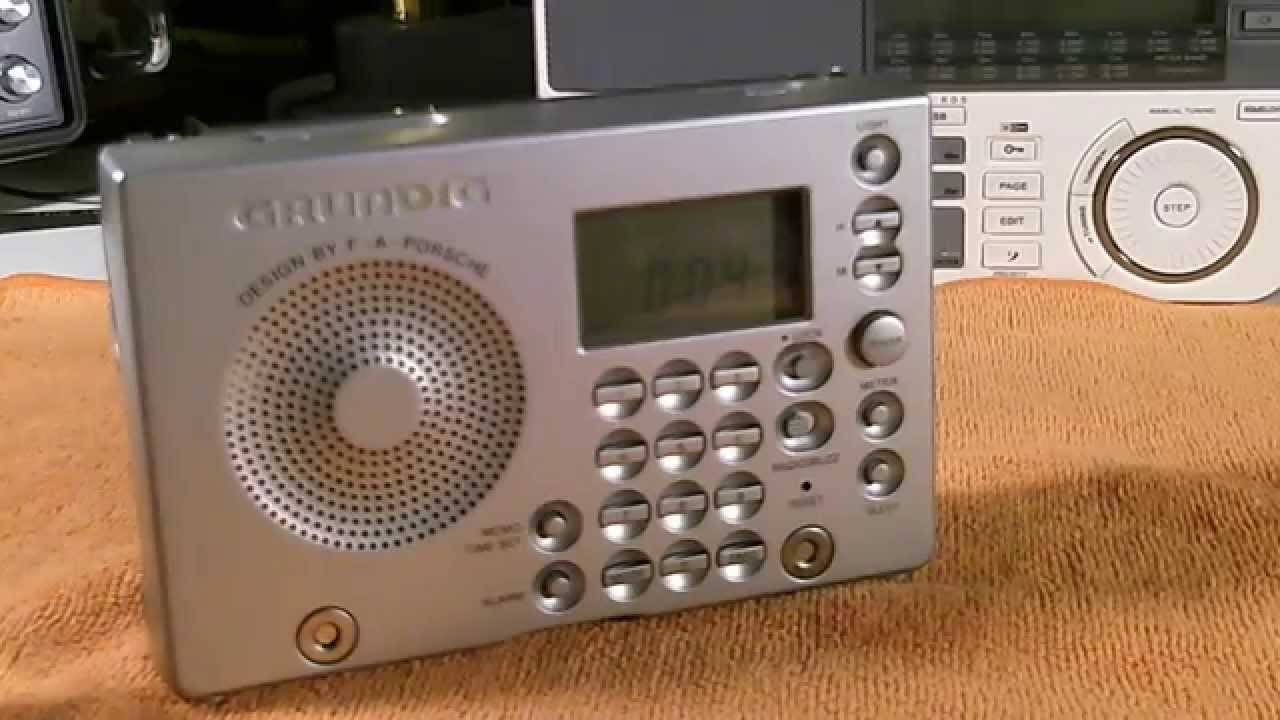
facebook inc 2015 case study analysis

- business plan
- course work
- research paper
argumentative essay opposing view examples
- Link to facebook
- Link to linkedin
- Link to twitter
- Link to youtube
- Writing Tips
A Guide to Rebuttals in Argumentative Essays

4-minute read
- 27th May 2023
Rebuttals are an essential part of a strong argument. But what are they, exactly, and how can you use them effectively? Read on to find out.
What Is a Rebuttal?
When writing an argumentative essay , there’s always an opposing point of view. You can’t present an argument without the possibility of someone disagreeing.
Sure, you could just focus on your argument and ignore the other perspective, but that weakens your essay. Coming up with possible alternative points of view, or counterarguments, and being prepared to address them, gives you an edge. A rebuttal is your response to these opposing viewpoints.
How Do Rebuttals Work?
With a rebuttal, you can take the fighting power away from any opposition to your idea before they have a chance to attack. For a rebuttal to work, it needs to follow the same formula as the other key points in your essay: it should be researched, developed, and presented with evidence.
Rebuttals in Action
Suppose you’re writing an essay arguing that strawberries are the best fruit. A potential counterargument could be that strawberries don’t work as well in baked goods as other berries do, as they can get soggy and lose some of their flavor. Your rebuttal would state this point and then explain why it’s not valid:
Read on for a few simple steps to formulating an effective rebuttal.
Step 1. Come up with a Counterargument
A strong rebuttal is only possible when there’s a strong counterargument. You may be convinced of your idea but try to place yourself on the other side. Rather than addressing weak opposing views that are easy to fend off, try to come up with the strongest claims that could be made.
In your essay, explain the counterargument and agree with it. That’s right, agree with it – to an extent. State why there’s some truth to it and validate the concerns it presents.
Step 2. Point Out Its Flaws
Now that you’ve presented a counterargument, poke holes in it . To do so, analyze the argument carefully and notice if there are any biases or caveats that weaken it. Looking at the claim that strawberries don’t work well in baked goods, a weakness could be that this argument only applies when strawberries are baked in a pie.
Find this useful?
Subscribe to our newsletter and get writing tips from our editors straight to your inbox.
Step 3. Present New Points
Once you reveal the counterargument’s weakness, present a new perspective, and provide supporting evidence to show that your argument is still the correct one. This means providing new points that the opposer may not have considered when presenting their claim.
Offering new ideas that weaken a counterargument makes you come off as authoritative and informed, which will make your readers more likely to agree with you.
Summary: Rebuttals
Rebuttals are essential when presenting an argument. Even if a counterargument is stronger than your point, you can construct an effective rebuttal that stands a chance against it.
We hope this guide helps you to structure and format your argumentative essay . And once you’ve finished writing, send a copy to our expert editors. We’ll ensure perfect grammar, spelling, punctuation, referencing, and more. Try it out for free today!
Frequently Asked Questions
What is a rebuttal in an essay.
A rebuttal is a response to a counterargument. It presents the potential counterclaim, discusses why it could be valid, and then explains why the original argument is still correct.
How do you form an effective rebuttal?
To use rebuttals effectively, come up with a strong counterclaim and respectfully point out its weaknesses. Then present new ideas that fill those gaps and strengthen your point.
Share this article:
Post A New Comment
Got content that needs a quick turnaround? Let us polish your work. Explore our editorial business services.
3-minute read
What Is a Content Editor?
Are you interested in learning more about the role of a content editor and the...
The Benefits of Using an Online Proofreading Service
Proofreading is important to ensure your writing is clear and concise for your readers. Whether...
2-minute read
6 Online AI Presentation Maker Tools
Creating presentations can be time-consuming and frustrating. Trying to construct a visually appealing and informative...
What Is Market Research?
No matter your industry, conducting market research helps you keep up to date with shifting...
8 Press Release Distribution Services for Your Business
In a world where you need to stand out, press releases are key to being...
How to Get a Patent
In the United States, the US Patent and Trademarks Office issues patents. In the United...

Make sure your writing is the best it can be with our expert English proofreading and editing.

Your version of Internet Explorer is either running in "Compatibility View" or is too outdated to display this site. If you believe your version of Internet Explorer is up to date, please remove this site from Compatibility View by opening Tools > Compatibility View settings (IE11) or clicking the broken page icon in your address bar (IE9, IE10)
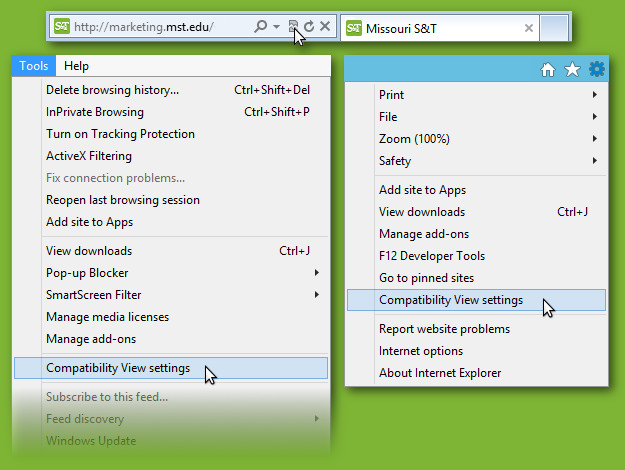
Missouri S&T Missouri S&T
- Future Students
- Current Students
- Faculty and Staff
- writingcenter.mst.edu
- Online Resources
- Writing Guides
- Counter Arguments
Writing and Communication Center
- 314 Curtis Laws Wilson Library, 400 W 14th St Rolla, MO 65409 United States
- (573) 341-4436
- [email protected]
Counter Argument
One way to strengthen your argument and demonstrate a comprehensive understanding of the issue you are discussing is to anticipate and address counter arguments, or objections. By considering opposing views, you show that you have thought things through, and you dispose of some of the reasons your audience might have for not accepting your argument. Ask yourself what someone who disagrees with you might say in response to each of the points you’ve made or about your position as a whole.
If you can’t immediately imagine another position, here are some strategies to try:
- Do some research. It may seem to you that no one could possibly disagree with the position you are taking, but someone probably has. Look around to see what stances people have and do take on the subject or argument you plan to make, so that you know what environment you are addressing.
- Talk with a friend or with your instructor. Another person may be able to play devil’s advocate and suggest counter arguments that haven’t occurred to you.
- Consider each of your supporting points individually. Even if you find it difficult to see why anyone would disagree with your central argument, you may be able to imagine more easily how someone could disagree with the individual parts of your argument. Then you can see which of these counter arguments are most worth considering. For example, if you argued “Cats make the best pets. This is because they are clean and independent,” you might imagine someone saying “Cats do not make the best pets. They are dirty and demanding.”
Once you have considered potential counter arguments, decide how you might respond to them: Will you concede that your opponent has a point but explain why your audience should nonetheless accept your argument? Or will you reject the counterargument and explain why it is mistaken? Either way, you will want to leave your reader with a sense that your argument is stronger than opposing arguments.
Two strategies are available to incorporate counter arguments into your essay:
Refutation:
Refutation seeks to disprove opposing arguments by pointing out their weaknesses. This approach is generally most effective if it is not hostile or sarcastic; with methodical, matter-of-fact language, identify the logical, theoretical, or factual flaws of the opposition.
For example, in an essay supporting the reintroduction of wolves into western farmlands, a writer might refute opponents by challenging the logic of their assumptions:
Although some farmers have expressed concern that wolves might pose a threat to the safety of sheep, cattle, or even small children, their fears are unfounded. Wolves fear humans even more than humans fear wolves and will trespass onto developed farmland only if desperate for food. The uninhabited wilderness that will become the wolves’ new home has such an abundance of food that there is virtually no chance that these shy animals will stray anywhere near humans.
Here, the writer acknowledges the opposing view (wolves will endanger livestock and children) and refutes it (the wolves will never be hungry enough to do so).
Accommodation:
Accommodation acknowledges the validity of the opposing view, but argues that other considerations outweigh it. In other words, this strategy turns the tables by agreeing (to some extent) with the opposition.
For example, the writer arguing for the reintroduction of wolves might accommodate the opposing view by writing:
Critics of the program have argued that reintroducing wolves is far too expensive a project to be considered seriously at this time. Although the reintroduction program is costly, it will only become more costly the longer it is put on hold. Furthermore, wolves will help control the population of pest animals in the area, saving farmers money on extermination costs. Finally, the preservation of an endangered species is worth far more to the environment and the ecological movement than the money that taxpayers would save if this wolf relocation initiative were to be abandoned.
This writer acknowledges the opposing position (the program is too expensive), agrees (yes, it is expensive), and then argues that despite the expense the program is worthwhile.
Some Final Hints
Don’t play dirty. When you summarize opposing arguments, be charitable. Present each argument fairly and objectively, rather than trying to make it look foolish. You want to convince your readers that you have carefully considered all sides of the issues and that you are not simply attacking or caricaturing your opponents.
Sometimes less is more. It is usually better to consider one or two serious counter arguments in some depth, rather than to address every counterargument.
Keep an open mind. Be sure that your reply is consistent with your original argument. Careful consideration of counter arguments can complicate or change your perspective on an issue. There’s nothing wrong with adopting a different perspective or changing your mind, but if you do, be sure to revise your thesis accordingly.
Have a language expert improve your writing
Run a free plagiarism check in 10 minutes, generate accurate citations for free.
- Knowledge Base
- How to write an argumentative essay | Examples & tips
How to Write an Argumentative Essay | Examples & Tips
Published on July 24, 2020 by Jack Caulfield . Revised on July 23, 2023.
An argumentative essay expresses an extended argument for a particular thesis statement . The author takes a clearly defined stance on their subject and builds up an evidence-based case for it.
Instantly correct all language mistakes in your text
Upload your document to correct all your mistakes in minutes

Table of contents
When do you write an argumentative essay, approaches to argumentative essays, introducing your argument, the body: developing your argument, concluding your argument, other interesting articles, frequently asked questions about argumentative essays.
You might be assigned an argumentative essay as a writing exercise in high school or in a composition class. The prompt will often ask you to argue for one of two positions, and may include terms like “argue” or “argument.” It will frequently take the form of a question.
The prompt may also be more open-ended in terms of the possible arguments you could make.
Argumentative writing at college level
At university, the vast majority of essays or papers you write will involve some form of argumentation. For example, both rhetorical analysis and literary analysis essays involve making arguments about texts.
In this context, you won’t necessarily be told to write an argumentative essay—but making an evidence-based argument is an essential goal of most academic writing, and this should be your default approach unless you’re told otherwise.
Examples of argumentative essay prompts
At a university level, all the prompts below imply an argumentative essay as the appropriate response.
Your research should lead you to develop a specific position on the topic. The essay then argues for that position and aims to convince the reader by presenting your evidence, evaluation and analysis.
- Don’t just list all the effects you can think of.
- Do develop a focused argument about the overall effect and why it matters, backed up by evidence from sources.
- Don’t just provide a selection of data on the measures’ effectiveness.
- Do build up your own argument about which kinds of measures have been most or least effective, and why.
- Don’t just analyze a random selection of doppelgänger characters.
- Do form an argument about specific texts, comparing and contrasting how they express their thematic concerns through doppelgänger characters.
Prevent plagiarism. Run a free check.
An argumentative essay should be objective in its approach; your arguments should rely on logic and evidence, not on exaggeration or appeals to emotion.
There are many possible approaches to argumentative essays, but there are two common models that can help you start outlining your arguments: The Toulmin model and the Rogerian model.
Toulmin arguments
The Toulmin model consists of four steps, which may be repeated as many times as necessary for the argument:
- Make a claim
- Provide the grounds (evidence) for the claim
- Explain the warrant (how the grounds support the claim)
- Discuss possible rebuttals to the claim, identifying the limits of the argument and showing that you have considered alternative perspectives
The Toulmin model is a common approach in academic essays. You don’t have to use these specific terms (grounds, warrants, rebuttals), but establishing a clear connection between your claims and the evidence supporting them is crucial in an argumentative essay.
Say you’re making an argument about the effectiveness of workplace anti-discrimination measures. You might:
- Claim that unconscious bias training does not have the desired results, and resources would be better spent on other approaches
- Cite data to support your claim
- Explain how the data indicates that the method is ineffective
- Anticipate objections to your claim based on other data, indicating whether these objections are valid, and if not, why not.
Rogerian arguments
The Rogerian model also consists of four steps you might repeat throughout your essay:
- Discuss what the opposing position gets right and why people might hold this position
- Highlight the problems with this position
- Present your own position , showing how it addresses these problems
- Suggest a possible compromise —what elements of your position would proponents of the opposing position benefit from adopting?
This model builds up a clear picture of both sides of an argument and seeks a compromise. It is particularly useful when people tend to disagree strongly on the issue discussed, allowing you to approach opposing arguments in good faith.
Say you want to argue that the internet has had a positive impact on education. You might:
- Acknowledge that students rely too much on websites like Wikipedia
- Argue that teachers view Wikipedia as more unreliable than it really is
- Suggest that Wikipedia’s system of citations can actually teach students about referencing
- Suggest critical engagement with Wikipedia as a possible assignment for teachers who are skeptical of its usefulness.
You don’t necessarily have to pick one of these models—you may even use elements of both in different parts of your essay—but it’s worth considering them if you struggle to structure your arguments.
Regardless of which approach you take, your essay should always be structured using an introduction , a body , and a conclusion .
Like other academic essays, an argumentative essay begins with an introduction . The introduction serves to capture the reader’s interest, provide background information, present your thesis statement , and (in longer essays) to summarize the structure of the body.
Hover over different parts of the example below to see how a typical introduction works.
The spread of the internet has had a world-changing effect, not least on the world of education. The use of the internet in academic contexts is on the rise, and its role in learning is hotly debated. For many teachers who did not grow up with this technology, its effects seem alarming and potentially harmful. This concern, while understandable, is misguided. The negatives of internet use are outweighed by its critical benefits for students and educators—as a uniquely comprehensive and accessible information source; a means of exposure to and engagement with different perspectives; and a highly flexible learning environment.
The body of an argumentative essay is where you develop your arguments in detail. Here you’ll present evidence, analysis, and reasoning to convince the reader that your thesis statement is true.
In the standard five-paragraph format for short essays, the body takes up three of your five paragraphs. In longer essays, it will be more paragraphs, and might be divided into sections with headings.
Each paragraph covers its own topic, introduced with a topic sentence . Each of these topics must contribute to your overall argument; don’t include irrelevant information.
This example paragraph takes a Rogerian approach: It first acknowledges the merits of the opposing position and then highlights problems with that position.
Hover over different parts of the example to see how a body paragraph is constructed.
A common frustration for teachers is students’ use of Wikipedia as a source in their writing. Its prevalence among students is not exaggerated; a survey found that the vast majority of the students surveyed used Wikipedia (Head & Eisenberg, 2010). An article in The Guardian stresses a common objection to its use: “a reliance on Wikipedia can discourage students from engaging with genuine academic writing” (Coomer, 2013). Teachers are clearly not mistaken in viewing Wikipedia usage as ubiquitous among their students; but the claim that it discourages engagement with academic sources requires further investigation. This point is treated as self-evident by many teachers, but Wikipedia itself explicitly encourages students to look into other sources. Its articles often provide references to academic publications and include warning notes where citations are missing; the site’s own guidelines for research make clear that it should be used as a starting point, emphasizing that users should always “read the references and check whether they really do support what the article says” (“Wikipedia:Researching with Wikipedia,” 2020). Indeed, for many students, Wikipedia is their first encounter with the concepts of citation and referencing. The use of Wikipedia therefore has a positive side that merits deeper consideration than it often receives.
Receive feedback on language, structure, and formatting
Professional editors proofread and edit your paper by focusing on:
- Academic style
- Vague sentences
- Style consistency
See an example

An argumentative essay ends with a conclusion that summarizes and reflects on the arguments made in the body.
No new arguments or evidence appear here, but in longer essays you may discuss the strengths and weaknesses of your argument and suggest topics for future research. In all conclusions, you should stress the relevance and importance of your argument.
Hover over the following example to see the typical elements of a conclusion.
The internet has had a major positive impact on the world of education; occasional pitfalls aside, its value is evident in numerous applications. The future of teaching lies in the possibilities the internet opens up for communication, research, and interactivity. As the popularity of distance learning shows, students value the flexibility and accessibility offered by digital education, and educators should fully embrace these advantages. The internet’s dangers, real and imaginary, have been documented exhaustively by skeptics, but the internet is here to stay; it is time to focus seriously on its potential for good.
If you want to know more about AI tools , college essays , or fallacies make sure to check out some of our other articles with explanations and examples or go directly to our tools!
- Ad hominem fallacy
- Post hoc fallacy
- Appeal to authority fallacy
- False cause fallacy
- Sunk cost fallacy
College essays
- Choosing Essay Topic
- Write a College Essay
- Write a Diversity Essay
- College Essay Format & Structure
- Comparing and Contrasting in an Essay
(AI) Tools
- Grammar Checker
- Paraphrasing Tool
- Text Summarizer
- AI Detector
- Plagiarism Checker
- Citation Generator
An argumentative essay tends to be a longer essay involving independent research, and aims to make an original argument about a topic. Its thesis statement makes a contentious claim that must be supported in an objective, evidence-based way.
An expository essay also aims to be objective, but it doesn’t have to make an original argument. Rather, it aims to explain something (e.g., a process or idea) in a clear, concise way. Expository essays are often shorter assignments and rely less on research.
At college level, you must properly cite your sources in all essays , research papers , and other academic texts (except exams and in-class exercises).
Add a citation whenever you quote , paraphrase , or summarize information or ideas from a source. You should also give full source details in a bibliography or reference list at the end of your text.
The exact format of your citations depends on which citation style you are instructed to use. The most common styles are APA , MLA , and Chicago .
The majority of the essays written at university are some sort of argumentative essay . Unless otherwise specified, you can assume that the goal of any essay you’re asked to write is argumentative: To convince the reader of your position using evidence and reasoning.
In composition classes you might be given assignments that specifically test your ability to write an argumentative essay. Look out for prompts including instructions like “argue,” “assess,” or “discuss” to see if this is the goal.
Cite this Scribbr article
If you want to cite this source, you can copy and paste the citation or click the “Cite this Scribbr article” button to automatically add the citation to our free Citation Generator.
Caulfield, J. (2023, July 23). How to Write an Argumentative Essay | Examples & Tips. Scribbr. Retrieved April 9, 2024, from https://www.scribbr.com/academic-essay/argumentative-essay/
Is this article helpful?

Jack Caulfield
Other students also liked, how to write a thesis statement | 4 steps & examples, how to write topic sentences | 4 steps, examples & purpose, how to write an expository essay, "i thought ai proofreading was useless but..".
I've been using Scribbr for years now and I know it's a service that won't disappoint. It does a good job spotting mistakes”
When you write an academic essay, you make an argument: you propose a thesis and offer some reasoning, using evidence, that suggests why the thesis is true. When you counter-argue, you consider a possible argument against your thesis or some aspect of your reasoning. This is a good way to test your ideas when drafting, while you still have time to revise them. And in the finished essay, it can be a persuasive and (in both senses of the word) disarming tactic. It allows you to anticipate doubts and pre-empt objections that a skeptical reader might have; it presents you as the kind of person who weighs alternatives before arguing for one, who confronts difficulties instead of sweeping them under the rug, who is more interested in discovering the truth than winning a point.
Not every objection is worth entertaining, of course, and you shouldn't include one just to include one. But some imagining of other views, or of resistance to one's own, occurs in most good essays. And instructors are glad to encounter counterargument in student papers, even if they haven't specifically asked for it.
The Turn Against
Counterargument in an essay has two stages: you turn against your argument to challenge it and then you turn back to re-affirm it. You first imagine a skeptical reader, or cite an actual source, who might resist your argument by pointing out
- a problem with your demonstration, e.g., that a different conclusion could be drawn from the same facts, a key assumption is unwarranted, a key term is used unfairly, certain evidence is ignored or played down;
- one or more disadvantages or practical drawbacks to what you propose;
- an alternative explanation or proposal that makes more sense.
You introduce this turn against with a phrase like One might object here that... or It might seem that... or It's true that... or Admittedly,... or Of course,... or with an anticipated challenging question: But how...? or But why...? or But isn't this just...? or But if this is so, what about...? Then you state the case against yourself as briefly but as clearly and forcefully as you can, pointing to evidence where possible. (An obviously feeble or perfunctory counterargument does more harm than good.)
The Turn Back
Your return to your own argument—which you announce with a but, yet, however, nevertheless or still —must likewise involve careful reasoning, not a flippant (or nervous) dismissal. In reasoning about the proposed counterargument, you may
- refute it, showing why it is mistaken—an apparent but not real problem;
- acknowledge its validity or plausibility, but suggest why on balance it's relatively less important or less likely than what you propose, and thus doesn't overturn it;
- concede its force and complicate your idea accordingly—restate your thesis in a more exact, qualified, or nuanced way that takes account of the objection, or start a new section in which you consider your topic in light of it. This will work if the counterargument concerns only an aspect of your argument; if it undermines your whole case, you need a new thesis.
Where to Put a Counterargument
Counterargument can appear anywhere in the essay, but it most commonly appears
- as part of your introduction—before you propose your thesis—where the existence of a different view is the motive for your essay, the reason it needs writing;
- as a section or paragraph just after your introduction, in which you lay out the expected reaction or standard position before turning away to develop your own;
- as a quick move within a paragraph, where you imagine a counterargument not to your main idea but to the sub-idea that the paragraph is arguing or is about to argue;
- as a section or paragraph just before the conclusion of your essay, in which you imagine what someone might object to what you have argued.
But watch that you don't overdo it. A turn into counterargument here and there will sharpen and energize your essay, but too many such turns will have the reverse effect by obscuring your main idea or suggesting that you're ambivalent.
Counterargument in Pre-Writing and Revising
Good thinking constantly questions itself, as Socrates observed long ago. But at some point in the process of composing an essay, you need to switch off the questioning in your head and make a case. Having such an inner conversation during the drafting stage, however, can help you settle on a case worth making. As you consider possible theses and begin to work on your draft, ask yourself how an intelligent person might plausibly disagree with you or see matters differently. When you can imagine an intelligent disagreement, you have an arguable idea.
And, of course, the disagreeing reader doesn't need to be in your head: if, as you're starting work on an essay, you ask a few people around you what they think of topic X (or of your idea about X) and keep alert for uncongenial remarks in class discussion and in assigned readings, you'll encounter a useful disagreement somewhere. Awareness of this disagreement, however you use it in your essay, will force you to sharpen your own thinking as you compose. If you come to find the counterargument truer than your thesis, consider making it your thesis and turning your original thesis into a counterargument. If you manage to draft an essay without imagining a counterargument, make yourself imagine one before you revise and see if you can integrate it.
Gordon Harvey (adapted from The Academic Essay: A Brief Anatomy), for the Writing Center at Harvard University
- Library Catalogue
Templates for structuring argumentative essays with practice exercises and solutions
On this page, thesis statement, referring to others’ work.
- Using impersonal language
Agreeing with what you’ve reviewed in the “They say” section
Disagreeing with what you’ve reviewed in the “they say” section.
- Agreeing and disagreeing simultaneously
My critics say
This page introduces a framework for writing argumentative/analytical essays, following a structure dubbed “They Say, I Say, My Critics Say, I Respond.” [1]
This page also includes a number of templates [2] or examples that you may find helpful for writing argumentative/analytical essays. Keep in mind that it is possible to change the sequence of the framework sections. Also, the templates can be used interchangeably.
A principal element of an argumentative/analytical essay is the thesis statement.
A thesis statement is one or two sentences (maybe more in longer essays) typically occurring near the end of an essay introduction; it shows your position regarding the topic you are investigating or your answer(s) to the question(s) that you are responding to.
Here are some templates that may help you write an effective thesis statement:
- In this paper, I argue that .......... because ..........
- In the pages that follow, I will argue that .......... because ..........
- Although/Even though .......... this essay argues that/I will argue that .......... because ..........
- This paper attempts to show that ..........
- This paper contests the claim that ..........
- This paper argues that ..........
- The central thesis of this paper is ..........
- In this essay, I attempt to defend the view that ..........
Thesis statement exercise and solutions
Imagine that you have been asked to write an argumentative essay about physical education in the Canadian high school system. Use one of the templates suggested to write a thesis statement about this topic.
- In the pages that follow, I will argue that physical education in the Canadian high school system has been largely ineffective because it has remained limited in its range of exercises and has failed to connect with students’ actual interests, such a dance and martial arts.
- This paper attempts to show that physical education is a crucial aspect of the Canadian high school system because many teenagers do not experience encouragement to do physical activity outside of school and contemporary life is increasingly sedentary for people of all ages.
The body of an essay usually begins by providing a background of the topic or a summary of the resources that you have reviewed (this is sometimes called a literature review). Here, you bring other people’s views into the paper. You want to show your readers what other scholars say (“they say”) about the topic, using techniques like paraphrasing, summarizing, and direct quotation.
You can start this section using one the following templates or examples to delve into the topic.
They say exercise and solutions
Imagine that you are now trying to incorporate some sources into your academic paper about physical education in the Canadian high school system. Try using a couple of templates from the “They Say” section of the handout.
Bonus exercise: See if you can identify the “template” structure that each of the sentences below is using (hint, they are different from the templates provided above).
- Brown (2018) rejects the idea that the levels of climate change we are currently seeing can be considered “natural” or “cyclical” (p. 108).
- According to Marshall (2017), we can see evidence of both code-switching and code-meshing in students’ reflective essay writing (p. 88).
- Previous studies of physical education have revealed that teenagers experience a significant degree of dissatisfaction with their gym classes (Wilson, 2010; Vowel et al, 1999; Mossman, 1986).
- A number of studies conducted prior to the 1990s have demonstrated that teenagers used to experience more encouragement to engage in physical activities outside of school hours (Sohal, 1954; Silverman, 1965; Lu, 1970; Mossman, 1986).
- Jones’ (2017) investigations of sedentariness among young people have shown significant increases in illness among teenagers who do not engage in regular physical activity.
After the background section (e.g., summary or literature review), you need to include your own position on the topic (“I say”). Tell your reader if, for instance, you agree, disagree, or even both agree and disagree with the work you have reviewed.
You can use one of the following templates or samples to bring your voice in:
- It could be argued that ..........
- It is evident/clear/obvious that the role of modern arts is ..........
- Clearly/Evidently, the role of education is ..........
- There is no little doubt that ..........
- I agree (that) ..........
- I support the view that ...........
- I concur with the view that ..........
- I disagree (that) ..........
- I disagree with the view that ..........
- I challenge/contest the view that ..........
- I oppose/am opposed to ..........
- I disagree with X’s view that .......... because, as recent research has shown, ..........
- X contradicts herself/can’t have it both ways. On the one hand, she argues ........... On the other hand, she also says ..........
- By focusing on .........., X overlooks the deeper problem of ..........
- Although I agree with X up to a point, I cannot accept his overriding assumption that ..........
- Although I disagree with much that X says, I fully endorse his final conclusion that ..........
- Though I concede that .........., I still insist that ..........
- X is right that .........., but she seems on more dubious ground that when she claims that ..........
- While X is probably wrong when she claims tha ..........., she is right that ..........
- Whereas X provides ample evidence that .........., Y and Z’s research on .......... and .......... convinces me that .......... instead.
- I’m of two minds about X’s claim that ........... On the one hand, I agree that .......... On the other hand, I’m not sure if ..........
- My feelings on the issue are mixed. I do support X’s position that .........., but I find Y’s argument about .......... and Z’s research on .......... to be equally persuasive.
I say exercises and solutions
Try using a template from each of the sections below to bring your own position into your writing:
- Agreeing with what you’ve reviewed
- Disagreeing with that you’ve reviewed
Using impersonal language There is little doubt that the teenage years are important for establishing life-long habits.
Agreeing with what you’ve reviewed in the “They say” section I support the view, presented by Vowel et al (1999) that effective physical education needs to consider the heightened self-consciousness that many teenagers experience and, in particular, needs to be sensitive to the body image issues that can be pervasive among young people.
Disagreeing with what you’ve reviewed in the “They say” section By focusing on school physical education programs and their shortcomings, Wilson (2010) overlooks the deeper problem that young people are experiencing a lack of motivation to incorporate healthy exercise into their daily lives.
Agreeing and Disagreeing simultaneously Though I concede that school physical education programs are valuable, I still insist that they cannot be the sole or even the primary way that we promote an active lifestyle among young people.
In a good argumentative essay, in addition to expressing your position and argument, you should consider possible opposing views to your argument: refer to what your opponents say (“my critics say”) and why they may disagree with your argument.
Including the ideas of those who may disagree with you makes up the counterargument section of your paper. You can refer to actual people, including other research scholars who may disagree with you, or try and imagine what those who disagree with you might say.
Remember, a thesis should be debatable, so you should be able to imagine someone disagreeing you’re your position. Here are some templates that may help you in writing counterargument:
My critics say exercise and solutions
Using one of the templates, try imagining a counterargument for the thesis you drafted earlier.
Sociocultural theorists used to believe that adolescence was a time of “natural defiance” (Fung, 1995) and therefore discounted the role of educational programs aimed at supporting teenagers to form healthy habits. Much of the focus of schooling therefore became about teaching specific content and skills.
Critics may call into question my assumption that effective physical education can help establish life-long healthy living habits.
After explaining what your opponents say, you have to refute them. This is sometimes called the rebuttal. Here, you can show your readers that your opponents either fail to provide enough evidence to support their argument or their evidence lacks credibility and/or is flawed.
Alternatively, you may argue that your opponents’ argument is valid, but not persuasive enough to be used in your study, or that their argument could be valid in a different context.
Don’t forget that for each part of your argument, you must provide enough evidence for the claims that you make. This means that if you include one of these templates in your essays, you have to explain the evidence it presents in a way that is clear and convincing for your reader.
I respond exercise and solutions
Using one of the templates, craft a rebuttal to the counterargument you just created.
Sociocultural theorists used to believe that adolescence was a time of “natural defiance” (Fung, 1995) and therefore discounted the role of educational programs aimed at supporting teenagers to form healthy habits. Much of the focus of schooling therefore became about teaching specific content and skills. However, this argument fails to demonstrate that the defiance observed during adolescence was “natural” or inherent and not a product of a specific cultural environment. It therefore does not convince me that education during the adolescent years needs to remain rigidly focused on content and skills.
Critics may call into question my assumption that effective physical education can help establish life-long healthy living habits. While it is true that we cannot assume that physical education will automatically lead to the establishment of healthy habits, I maintain that the creation of such habits, rather than simply teaching specific physical education content or skills, should be the central goal of an effective physical education program.
Graff, G., & Birkenstein, C. (2017). They say / I say: The moves that matter in academic writing, with readings (3rd ed.). New York: Norton W. W. Company.
Marshall, S. (2017). Advance in academic writing: Integrating research, critical thinking, academic reading and writing. Toronto, Canada: Pearson Education ESL.
Morley, J. (2014). Academic phrasebank. Retrieved from http://www.phrasebank.manchester.ac.uk/
[1] Adapted from Graff and Birkenstein (2016).
[2] The templates used in this handout are adapted from Morley (2014), Marshall (2017), and Graff and Birkenstein (2016).
Purdue Online Writing Lab Purdue OWL® College of Liberal Arts
Argumentative Essays

Welcome to the Purdue OWL
This page is brought to you by the OWL at Purdue University. When printing this page, you must include the entire legal notice.
Copyright ©1995-2018 by The Writing Lab & The OWL at Purdue and Purdue University. All rights reserved. This material may not be published, reproduced, broadcast, rewritten, or redistributed without permission. Use of this site constitutes acceptance of our terms and conditions of fair use.
The Modes of Discourse—Exposition, Description, Narration, Argumentation (EDNA)—are common paper assignments you may encounter in your writing classes. Although these genres have been criticized by some composition scholars, the Purdue OWL recognizes the wide spread use of these approaches and students’ need to understand and produce them.
What is an argumentative essay?
The argumentative essay is a genre of writing that requires the student to investigate a topic; collect, generate, and evaluate evidence; and establish a position on the topic in a concise manner.
Please note : Some confusion may occur between the argumentative essay and the expository essay. These two genres are similar, but the argumentative essay differs from the expository essay in the amount of pre-writing (invention) and research involved. The argumentative essay is commonly assigned as a capstone or final project in first year writing or advanced composition courses and involves lengthy, detailed research. Expository essays involve less research and are shorter in length. Expository essays are often used for in-class writing exercises or tests, such as the GED or GRE.
Argumentative essay assignments generally call for extensive research of literature or previously published material. Argumentative assignments may also require empirical research where the student collects data through interviews, surveys, observations, or experiments. Detailed research allows the student to learn about the topic and to understand different points of view regarding the topic so that she/he may choose a position and support it with the evidence collected during research. Regardless of the amount or type of research involved, argumentative essays must establish a clear thesis and follow sound reasoning.
The structure of the argumentative essay is held together by the following.
- A clear, concise, and defined thesis statement that occurs in the first paragraph of the essay.
In the first paragraph of an argument essay, students should set the context by reviewing the topic in a general way. Next the author should explain why the topic is important ( exigence ) or why readers should care about the issue. Lastly, students should present the thesis statement. It is essential that this thesis statement be appropriately narrowed to follow the guidelines set forth in the assignment. If the student does not master this portion of the essay, it will be quite difficult to compose an effective or persuasive essay.
- Clear and logical transitions between the introduction, body, and conclusion.
Transitions are the mortar that holds the foundation of the essay together. Without logical progression of thought, the reader is unable to follow the essay’s argument, and the structure will collapse. Transitions should wrap up the idea from the previous section and introduce the idea that is to follow in the next section.
- Body paragraphs that include evidential support.
Each paragraph should be limited to the discussion of one general idea. This will allow for clarity and direction throughout the essay. In addition, such conciseness creates an ease of readability for one’s audience. It is important to note that each paragraph in the body of the essay must have some logical connection to the thesis statement in the opening paragraph. Some paragraphs will directly support the thesis statement with evidence collected during research. It is also important to explain how and why the evidence supports the thesis ( warrant ).
However, argumentative essays should also consider and explain differing points of view regarding the topic. Depending on the length of the assignment, students should dedicate one or two paragraphs of an argumentative essay to discussing conflicting opinions on the topic. Rather than explaining how these differing opinions are wrong outright, students should note how opinions that do not align with their thesis might not be well informed or how they might be out of date.
- Evidential support (whether factual, logical, statistical, or anecdotal).
The argumentative essay requires well-researched, accurate, detailed, and current information to support the thesis statement and consider other points of view. Some factual, logical, statistical, or anecdotal evidence should support the thesis. However, students must consider multiple points of view when collecting evidence. As noted in the paragraph above, a successful and well-rounded argumentative essay will also discuss opinions not aligning with the thesis. It is unethical to exclude evidence that may not support the thesis. It is not the student’s job to point out how other positions are wrong outright, but rather to explain how other positions may not be well informed or up to date on the topic.
- A conclusion that does not simply restate the thesis, but readdresses it in light of the evidence provided.
It is at this point of the essay that students may begin to struggle. This is the portion of the essay that will leave the most immediate impression on the mind of the reader. Therefore, it must be effective and logical. Do not introduce any new information into the conclusion; rather, synthesize the information presented in the body of the essay. Restate why the topic is important, review the main points, and review your thesis. You may also want to include a short discussion of more research that should be completed in light of your work.
A complete argument
Perhaps it is helpful to think of an essay in terms of a conversation or debate with a classmate. If I were to discuss the cause of World War II and its current effect on those who lived through the tumultuous time, there would be a beginning, middle, and end to the conversation. In fact, if I were to end the argument in the middle of my second point, questions would arise concerning the current effects on those who lived through the conflict. Therefore, the argumentative essay must be complete, and logically so, leaving no doubt as to its intent or argument.
The five-paragraph essay
A common method for writing an argumentative essay is the five-paragraph approach. This is, however, by no means the only formula for writing such essays. If it sounds straightforward, that is because it is; in fact, the method consists of (a) an introductory paragraph (b) three evidentiary body paragraphs that may include discussion of opposing views and (c) a conclusion.
Longer argumentative essays
Complex issues and detailed research call for complex and detailed essays. Argumentative essays discussing a number of research sources or empirical research will most certainly be longer than five paragraphs. Authors may have to discuss the context surrounding the topic, sources of information and their credibility, as well as a number of different opinions on the issue before concluding the essay. Many of these factors will be determined by the assignment.

Choose Your Test
Sat / act prep online guides and tips, how to write an a+ argumentative essay.
Miscellaneous

You'll no doubt have to write a number of argumentative essays in both high school and college, but what, exactly, is an argumentative essay and how do you write the best one possible? Let's take a look.
A great argumentative essay always combines the same basic elements: approaching an argument from a rational perspective, researching sources, supporting your claims using facts rather than opinion, and articulating your reasoning into the most cogent and reasoned points. Argumentative essays are great building blocks for all sorts of research and rhetoric, so your teachers will expect you to master the technique before long.
But if this sounds daunting, never fear! We'll show how an argumentative essay differs from other kinds of papers, how to research and write them, how to pick an argumentative essay topic, and where to find example essays. So let's get started.
What Is an Argumentative Essay? How Is it Different from Other Kinds of Essays?
There are two basic requirements for any and all essays: to state a claim (a thesis statement) and to support that claim with evidence.
Though every essay is founded on these two ideas, there are several different types of essays, differentiated by the style of the writing, how the writer presents the thesis, and the types of evidence used to support the thesis statement.
Essays can be roughly divided into four different types:
#1: Argumentative #2: Persuasive #3: Expository #4: Analytical
So let's look at each type and what the differences are between them before we focus the rest of our time to argumentative essays.
Argumentative Essay
Argumentative essays are what this article is all about, so let's talk about them first.
An argumentative essay attempts to convince a reader to agree with a particular argument (the writer's thesis statement). The writer takes a firm stand one way or another on a topic and then uses hard evidence to support that stance.
An argumentative essay seeks to prove to the reader that one argument —the writer's argument— is the factually and logically correct one. This means that an argumentative essay must use only evidence-based support to back up a claim , rather than emotional or philosophical reasoning (which is often allowed in other types of essays). Thus, an argumentative essay has a burden of substantiated proof and sources , whereas some other types of essays (namely persuasive essays) do not.
You can write an argumentative essay on any topic, so long as there's room for argument. Generally, you can use the same topics for both a persuasive essay or an argumentative one, so long as you support the argumentative essay with hard evidence.
Example topics of an argumentative essay:
- "Should farmers be allowed to shoot wolves if those wolves injure or kill farm animals?"
- "Should the drinking age be lowered in the United States?"
- "Are alternatives to democracy effective and/or feasible to implement?"
The next three types of essays are not argumentative essays, but you may have written them in school. We're going to cover them so you know what not to do for your argumentative essay.
Persuasive Essay
Persuasive essays are similar to argumentative essays, so it can be easy to get them confused. But knowing what makes an argumentative essay different than a persuasive essay can often mean the difference between an excellent grade and an average one.
Persuasive essays seek to persuade a reader to agree with the point of view of the writer, whether that point of view is based on factual evidence or not. The writer has much more flexibility in the evidence they can use, with the ability to use moral, cultural, or opinion-based reasoning as well as factual reasoning to persuade the reader to agree the writer's side of a given issue.
Instead of being forced to use "pure" reason as one would in an argumentative essay, the writer of a persuasive essay can manipulate or appeal to the reader's emotions. So long as the writer attempts to steer the readers into agreeing with the thesis statement, the writer doesn't necessarily need hard evidence in favor of the argument.
Often, you can use the same topics for both a persuasive essay or an argumentative one—the difference is all in the approach and the evidence you present.
Example topics of a persuasive essay:
- "Should children be responsible for their parents' debts?"
- "Should cheating on a test be automatic grounds for expulsion?"
- "How much should sports leagues be held accountable for player injuries and the long-term consequences of those injuries?"
Expository Essay
An expository essay is typically a short essay in which the writer explains an idea, issue, or theme , or discusses the history of a person, place, or idea.
This is typically a fact-forward essay with little argument or opinion one way or the other.
Example topics of an expository essay:
- "The History of the Philadelphia Liberty Bell"
- "The Reasons I Always Wanted to be a Doctor"
- "The Meaning Behind the Colloquialism ‘People in Glass Houses Shouldn't Throw Stones'"
Analytical Essay
An analytical essay seeks to delve into the deeper meaning of a text or work of art, or unpack a complicated idea . These kinds of essays closely interpret a source and look into its meaning by analyzing it at both a macro and micro level.
This type of analysis can be augmented by historical context or other expert or widely-regarded opinions on the subject, but is mainly supported directly through the original source (the piece or art or text being analyzed) .
Example topics of an analytical essay:
- "Victory Gin in Place of Water: The Symbolism Behind Gin as the Only Potable Substance in George Orwell's 1984"
- "Amarna Period Art: The Meaning Behind the Shift from Rigid to Fluid Poses"
- "Adultery During WWII, as Told Through a Series of Letters to and from Soldiers"

There are many different types of essay and, over time, you'll be able to master them all.
A Typical Argumentative Essay Assignment
The average argumentative essay is between three to five pages, and will require at least three or four separate sources with which to back your claims . As for the essay topic , you'll most often be asked to write an argumentative essay in an English class on a "general" topic of your choice, ranging the gamut from science, to history, to literature.
But while the topics of an argumentative essay can span several different fields, the structure of an argumentative essay is always the same: you must support a claim—a claim that can reasonably have multiple sides—using multiple sources and using a standard essay format (which we'll talk about later on).
This is why many argumentative essay topics begin with the word "should," as in:
- "Should all students be required to learn chemistry in high school?"
- "Should children be required to learn a second language?"
- "Should schools or governments be allowed to ban books?"
These topics all have at least two sides of the argument: Yes or no. And you must support the side you choose with evidence as to why your side is the correct one.
But there are also plenty of other ways to frame an argumentative essay as well:
- "Does using social media do more to benefit or harm people?"
- "Does the legal status of artwork or its creators—graffiti and vandalism, pirated media, a creator who's in jail—have an impact on the art itself?"
- "Is or should anyone ever be ‘above the law?'"
Though these are worded differently than the first three, you're still essentially forced to pick between two sides of an issue: yes or no, for or against, benefit or detriment. Though your argument might not fall entirely into one side of the divide or another—for instance, you could claim that social media has positively impacted some aspects of modern life while being a detriment to others—your essay should still support one side of the argument above all. Your final stance would be that overall , social media is beneficial or overall , social media is harmful.
If your argument is one that is mostly text-based or backed by a single source (e.g., "How does Salinger show that Holden Caulfield is an unreliable narrator?" or "Does Gatsby personify the American Dream?"), then it's an analytical essay, rather than an argumentative essay. An argumentative essay will always be focused on more general topics so that you can use multiple sources to back up your claims.
Good Argumentative Essay Topics
So you know the basic idea behind an argumentative essay, but what topic should you write about?
Again, almost always, you'll be asked to write an argumentative essay on a free topic of your choice, or you'll be asked to select between a few given topics . If you're given complete free reign of topics, then it'll be up to you to find an essay topic that no only appeals to you, but that you can turn into an A+ argumentative essay.
What makes a "good" argumentative essay topic depends on both the subject matter and your personal interest —it can be hard to give your best effort on something that bores you to tears! But it can also be near impossible to write an argumentative essay on a topic that has no room for debate.
As we said earlier, a good argumentative essay topic will be one that has the potential to reasonably go in at least two directions—for or against, yes or no, and why . For example, it's pretty hard to write an argumentative essay on whether or not people should be allowed to murder one another—not a whole lot of debate there for most people!—but writing an essay for or against the death penalty has a lot more wiggle room for evidence and argument.
A good topic is also one that can be substantiated through hard evidence and relevant sources . So be sure to pick a topic that other people have studied (or at least studied elements of) so that you can use their data in your argument. For example, if you're arguing that it should be mandatory for all middle school children to play a sport, you might have to apply smaller scientific data points to the larger picture you're trying to justify. There are probably several studies you could cite on the benefits of physical activity and the positive effect structure and teamwork has on young minds, but there's probably no study you could use where a group of scientists put all middle-schoolers in one jurisdiction into a mandatory sports program (since that's probably never happened). So long as your evidence is relevant to your point and you can extrapolate from it to form a larger whole, you can use it as a part of your resource material.
And if you need ideas on where to get started, or just want to see sample argumentative essay topics, then check out these links for hundreds of potential argumentative essay topics.
101 Persuasive (or Argumentative) Essay and Speech Topics
301 Prompts for Argumentative Writing
Top 50 Ideas for Argumentative/Persuasive Essay Writing
[Note: some of these say "persuasive essay topics," but just remember that the same topic can often be used for both a persuasive essay and an argumentative essay; the difference is in your writing style and the evidence you use to support your claims.]

KO! Find that one argumentative essay topic you can absolutely conquer.
Argumentative Essay Format
Argumentative Essays are composed of four main elements:
- A position (your argument)
- Your reasons
- Supporting evidence for those reasons (from reliable sources)
- Counterargument(s) (possible opposing arguments and reasons why those arguments are incorrect)
If you're familiar with essay writing in general, then you're also probably familiar with the five paragraph essay structure . This structure is a simple tool to show how one outlines an essay and breaks it down into its component parts, although it can be expanded into as many paragraphs as you want beyond the core five.
The standard argumentative essay is often 3-5 pages, which will usually mean a lot more than five paragraphs, but your overall structure will look the same as a much shorter essay.
An argumentative essay at its simplest structure will look like:
Paragraph 1: Intro
- Set up the story/problem/issue
- Thesis/claim
Paragraph 2: Support
- Reason #1 claim is correct
- Supporting evidence with sources
Paragraph 3: Support
- Reason #2 claim is correct
Paragraph 4: Counterargument
- Explanation of argument for the other side
- Refutation of opposing argument with supporting evidence
Paragraph 5: Conclusion
- Re-state claim
- Sum up reasons and support of claim from the essay to prove claim is correct
Now let's unpack each of these paragraph types to see how they work (with examples!), what goes into them, and why.
Paragraph 1—Set Up and Claim
Your first task is to introduce the reader to the topic at hand so they'll be prepared for your claim. Give a little background information, set the scene, and give the reader some stakes so that they care about the issue you're going to discuss.
Next, you absolutely must have a position on an argument and make that position clear to the readers. It's not an argumentative essay unless you're arguing for a specific claim, and this claim will be your thesis statement.
Your thesis CANNOT be a mere statement of fact (e.g., "Washington DC is the capital of the United States"). Your thesis must instead be an opinion which can be backed up with evidence and has the potential to be argued against (e.g., "New York should be the capital of the United States").
Paragraphs 2 and 3—Your Evidence
These are your body paragraphs in which you give the reasons why your argument is the best one and back up this reasoning with concrete evidence .
The argument supporting the thesis of an argumentative essay should be one that can be supported by facts and evidence, rather than personal opinion or cultural or religious mores.
For example, if you're arguing that New York should be the new capital of the US, you would have to back up that fact by discussing the factual contrasts between New York and DC in terms of location, population, revenue, and laws. You would then have to talk about the precedents for what makes for a good capital city and why New York fits the bill more than DC does.
Your argument can't simply be that a lot of people think New York is the best city ever and that you agree.
In addition to using concrete evidence, you always want to keep the tone of your essay passionate, but impersonal . Even though you're writing your argument from a single opinion, don't use first person language—"I think," "I feel," "I believe,"—to present your claims. Doing so is repetitive, since by writing the essay you're already telling the audience what you feel, and using first person language weakens your writing voice.
For example,
"I think that Washington DC is no longer suited to be the capital city of the United States."
"Washington DC is no longer suited to be the capital city of the United States."
The second statement sounds far stronger and more analytical.
Paragraph 4—Argument for the Other Side and Refutation
Even without a counter argument, you can make a pretty persuasive claim, but a counterargument will round out your essay into one that is much more persuasive and substantial.
By anticipating an argument against your claim and taking the initiative to counter it, you're allowing yourself to get ahead of the game. This way, you show that you've given great thought to all sides of the issue before choosing your position, and you demonstrate in multiple ways how yours is the more reasoned and supported side.
Paragraph 5—Conclusion
This paragraph is where you re-state your argument and summarize why it's the best claim.
Briefly touch on your supporting evidence and voila! A finished argumentative essay.

Your essay should have just as awesome a skeleton as this plesiosaur does. (In other words: a ridiculously awesome skeleton)
Argumentative Essay Example: 5-Paragraph Style
It always helps to have an example to learn from. I've written a full 5-paragraph argumentative essay here. Look at how I state my thesis in paragraph 1, give supporting evidence in paragraphs 2 and 3, address a counterargument in paragraph 4, and conclude in paragraph 5.
Topic: Is it possible to maintain conflicting loyalties?
Paragraph 1
It is almost impossible to go through life without encountering a situation where your loyalties to different people or causes come into conflict with each other. Maybe you have a loving relationship with your sister, but she disagrees with your decision to join the army, or you find yourself torn between your cultural beliefs and your scientific ones. These conflicting loyalties can often be maintained for a time, but as examples from both history and psychological theory illustrate, sooner or later, people have to make a choice between competing loyalties, as no one can maintain a conflicting loyalty or belief system forever.
The first two sentences set the scene and give some hypothetical examples and stakes for the reader to care about.
The third sentence finishes off the intro with the thesis statement, making very clear how the author stands on the issue ("people have to make a choice between competing loyalties, as no one can maintain a conflicting loyalty or belief system forever." )
Paragraphs 2 and 3
Psychological theory states that human beings are not equipped to maintain conflicting loyalties indefinitely and that attempting to do so leads to a state called "cognitive dissonance." Cognitive dissonance theory is the psychological idea that people undergo tremendous mental stress or anxiety when holding contradictory beliefs, values, or loyalties (Festinger, 1957). Even if human beings initially hold a conflicting loyalty, they will do their best to find a mental equilibrium by making a choice between those loyalties—stay stalwart to a belief system or change their beliefs. One of the earliest formal examples of cognitive dissonance theory comes from Leon Festinger's When Prophesy Fails . Members of an apocalyptic cult are told that the end of the world will occur on a specific date and that they alone will be spared the Earth's destruction. When that day comes and goes with no apocalypse, the cult members face a cognitive dissonance between what they see and what they've been led to believe (Festinger, 1956). Some choose to believe that the cult's beliefs are still correct, but that the Earth was simply spared from destruction by mercy, while others choose to believe that they were lied to and that the cult was fraudulent all along. Both beliefs cannot be correct at the same time, and so the cult members are forced to make their choice.
But even when conflicting loyalties can lead to potentially physical, rather than just mental, consequences, people will always make a choice to fall on one side or other of a dividing line. Take, for instance, Nicolaus Copernicus, a man born and raised in Catholic Poland (and educated in Catholic Italy). Though the Catholic church dictated specific scientific teachings, Copernicus' loyalty to his own observations and scientific evidence won out over his loyalty to his country's government and belief system. When he published his heliocentric model of the solar system--in opposition to the geocentric model that had been widely accepted for hundreds of years (Hannam, 2011)-- Copernicus was making a choice between his loyalties. In an attempt t o maintain his fealty both to the established system and to what he believed, h e sat on his findings for a number of years (Fantoli, 1994). But, ultimately, Copernicus made the choice to side with his beliefs and observations above all and published his work for the world to see (even though, in doing so, he risked both his reputation and personal freedoms).
These two paragraphs provide the reasons why the author supports the main argument and uses substantiated sources to back those reasons.
The paragraph on cognitive dissonance theory gives both broad supporting evidence and more narrow, detailed supporting evidence to show why the thesis statement is correct not just anecdotally but also scientifically and psychologically. First, we see why people in general have a difficult time accepting conflicting loyalties and desires and then how this applies to individuals through the example of the cult members from the Dr. Festinger's research.
The next paragraph continues to use more detailed examples from history to provide further evidence of why the thesis that people cannot indefinitely maintain conflicting loyalties is true.
Paragraph 4
Some will claim that it is possible to maintain conflicting beliefs or loyalties permanently, but this is often more a matter of people deluding themselves and still making a choice for one side or the other, rather than truly maintaining loyalty to both sides equally. For example, Lancelot du Lac typifies a person who claims to maintain a balanced loyalty between to two parties, but his attempt to do so fails (as all attempts to permanently maintain conflicting loyalties must). Lancelot tells himself and others that he is equally devoted to both King Arthur and his court and to being Queen Guinevere's knight (Malory, 2008). But he can neither be in two places at once to protect both the king and queen, nor can he help but let his romantic feelings for the queen to interfere with his duties to the king and the kingdom. Ultimately, he and Queen Guinevere give into their feelings for one another and Lancelot—though he denies it—chooses his loyalty to her over his loyalty to Arthur. This decision plunges the kingdom into a civil war, ages Lancelot prematurely, and ultimately leads to Camelot's ruin (Raabe, 1987). Though Lancelot claimed to have been loyal to both the king and the queen, this loyalty was ultimately in conflict, and he could not maintain it.
Here we have the acknowledgement of a potential counter-argument and the evidence as to why it isn't true.
The argument is that some people (or literary characters) have asserted that they give equal weight to their conflicting loyalties. The refutation is that, though some may claim to be able to maintain conflicting loyalties, they're either lying to others or deceiving themselves. The paragraph shows why this is true by providing an example of this in action.
Paragraph 5
Whether it be through literature or history, time and time again, people demonstrate the challenges of trying to manage conflicting loyalties and the inevitable consequences of doing so. Though belief systems are malleable and will often change over time, it is not possible to maintain two mutually exclusive loyalties or beliefs at once. In the end, people always make a choice, and loyalty for one party or one side of an issue will always trump loyalty to the other.
The concluding paragraph summarizes the essay, touches on the evidence presented, and re-states the thesis statement.
How to Write an Argumentative Essay: 8 Steps
Writing the best argumentative essay is all about the preparation, so let's talk steps:
#1: Preliminary Research
If you have the option to pick your own argumentative essay topic (which you most likely will), then choose one or two topics you find the most intriguing or that you have a vested interest in and do some preliminary research on both sides of the debate.
Do an open internet search just to see what the general chatter is on the topic and what the research trends are.
Did your preliminary reading influence you to pick a side or change your side? Without diving into all the scholarly articles at length, do you believe there's enough evidence to support your claim? Have there been scientific studies? Experiments? Does a noted scholar in the field agree with you? If not, you may need to pick another topic or side of the argument to support.
#2: Pick Your Side and Form Your Thesis
Now's the time to pick the side of the argument you feel you can support the best and summarize your main point into your thesis statement.
Your thesis will be the basis of your entire essay, so make sure you know which side you're on, that you've stated it clearly, and that you stick by your argument throughout the entire essay .
#3: Heavy-Duty Research Time
You've taken a gander at what the internet at large has to say on your argument, but now's the time to actually read those sources and take notes.
Check scholarly journals online at Google Scholar , the Directory of Open Access Journals , or JStor . You can also search individual university or school libraries and websites to see what kinds of academic articles you can access for free. Keep track of your important quotes and page numbers and put them somewhere that's easy to find later.
And don't forget to check your school or local libraries as well!
#4: Outline
Follow the five-paragraph outline structure from the previous section.
Fill in your topic, your reasons, and your supporting evidence into each of the categories.
Before you begin to flesh out the essay, take a look at what you've got. Is your thesis statement in the first paragraph? Is it clear? Is your argument logical? Does your supporting evidence support your reasoning?
By outlining your essay, you streamline your process and take care of any logic gaps before you dive headfirst into the writing. This will save you a lot of grief later on if you need to change your sources or your structure, so don't get too trigger-happy and skip this step.
Now that you've laid out exactly what you'll need for your essay and where, it's time to fill in all the gaps by writing it out.
Take it one step at a time and expand your ideas into complete sentences and substantiated claims. It may feel daunting to turn an outline into a complete draft, but just remember that you've already laid out all the groundwork; now you're just filling in the gaps.
If you have the time before deadline, give yourself a day or two (or even just an hour!) away from your essay . Looking it over with fresh eyes will allow you to see errors, both minor and major, that you likely would have missed had you tried to edit when it was still raw.
Take a first pass over the entire essay and try your best to ignore any minor spelling or grammar mistakes—you're just looking at the big picture right now. Does it make sense as a whole? Did the essay succeed in making an argument and backing that argument up logically? (Do you feel persuaded?)
If not, go back and make notes so that you can fix it for your final draft.
Once you've made your revisions to the overall structure, mark all your small errors and grammar problems so you can fix them in the next draft.
#7: Final Draft
Use the notes you made on the rough draft and go in and hack and smooth away until you're satisfied with the final result.
A checklist for your final draft:
- Formatting is correct according to your teacher's standards
- No errors in spelling, grammar, and punctuation
- Essay is the right length and size for the assignment
- The argument is present, consistent, and concise
- Each reason is supported by relevant evidence
- The essay makes sense overall
#8: Celebrate!
Once you've brought that final draft to a perfect polish and turned in your assignment, you're done! Go you!

Be prepared and ♪ you'll never go hungry again ♪, *cough*, or struggle with your argumentative essay-writing again. (Walt Disney Studios)
Good Examples of Argumentative Essays Online
Theory is all well and good, but examples are key. Just to get you started on what a fully-fleshed out argumentative essay looks like, let's see some examples in action.
Check out these two argumentative essay examples on the use of landmines and freons (and note the excellent use of concrete sources to back up their arguments!).
The Use of Landmines
A Shattered Sky
The Take-Aways: Keys to Writing an Argumentative Essay
At first, writing an argumentative essay may seem like a monstrous hurdle to overcome, but with the proper preparation and understanding, you'll be able to knock yours out of the park.
Remember the differences between a persuasive essay and an argumentative one, make sure your thesis is clear, and double-check that your supporting evidence is both relevant to your point and well-sourced . Pick your topic, do your research, make your outline, and fill in the gaps. Before you know it, you'll have yourself an A+ argumentative essay there, my friend.
What's Next?
Now you know the ins and outs of an argumentative essay, but how comfortable are you writing in other styles? Learn more about the four writing styles and when it makes sense to use each .
Understand how to make an argument, but still having trouble organizing your thoughts? Check out our guide to three popular essay formats and choose which one is right for you.
Ready to make your case, but not sure what to write about? We've created a list of 50 potential argumentative essay topics to spark your imagination.
Courtney scored in the 99th percentile on the SAT in high school and went on to graduate from Stanford University with a degree in Cultural and Social Anthropology. She is passionate about bringing education and the tools to succeed to students from all backgrounds and walks of life, as she believes open education is one of the great societal equalizers. She has years of tutoring experience and writes creative works in her free time.
Student and Parent Forum
Our new student and parent forum, at ExpertHub.PrepScholar.com , allow you to interact with your peers and the PrepScholar staff. See how other students and parents are navigating high school, college, and the college admissions process. Ask questions; get answers.

Ask a Question Below
Have any questions about this article or other topics? Ask below and we'll reply!
Improve With Our Famous Guides
- For All Students
The 5 Strategies You Must Be Using to Improve 160+ SAT Points
How to Get a Perfect 1600, by a Perfect Scorer
Series: How to Get 800 on Each SAT Section:
Score 800 on SAT Math
Score 800 on SAT Reading
Score 800 on SAT Writing
Series: How to Get to 600 on Each SAT Section:
Score 600 on SAT Math
Score 600 on SAT Reading
Score 600 on SAT Writing
Free Complete Official SAT Practice Tests
What SAT Target Score Should You Be Aiming For?
15 Strategies to Improve Your SAT Essay
The 5 Strategies You Must Be Using to Improve 4+ ACT Points
How to Get a Perfect 36 ACT, by a Perfect Scorer
Series: How to Get 36 on Each ACT Section:
36 on ACT English
36 on ACT Math
36 on ACT Reading
36 on ACT Science
Series: How to Get to 24 on Each ACT Section:
24 on ACT English
24 on ACT Math
24 on ACT Reading
24 on ACT Science
What ACT target score should you be aiming for?
ACT Vocabulary You Must Know
ACT Writing: 15 Tips to Raise Your Essay Score
How to Get Into Harvard and the Ivy League
How to Get a Perfect 4.0 GPA
How to Write an Amazing College Essay
What Exactly Are Colleges Looking For?
Is the ACT easier than the SAT? A Comprehensive Guide
Should you retake your SAT or ACT?
When should you take the SAT or ACT?
Stay Informed
Get the latest articles and test prep tips!
Looking for Graduate School Test Prep?
Check out our top-rated graduate blogs here:
GRE Online Prep Blog
GMAT Online Prep Blog
TOEFL Online Prep Blog
Holly R. "I am absolutely overjoyed and cannot thank you enough for helping me!”
Argumentative Essay Examples to Inspire You (+ Free Formula)
.webp)
Meredith Sell
Have you ever been asked to explain your opinion on a controversial issue?
- Maybe your family got into a discussion about chemical pesticides
- Someone at work argues against investing resources into your project
- Your partner thinks intermittent fasting is the best way to lose weight and you disagree
Proving your point in an argumentative essay can be challenging, unless you are using a proven formula.
Argumentative essay formula & example
In the image below, you can see a recommended structure for argumentative essays. It starts with the topic sentence, which establishes the main idea of the essay. Next, this hypothesis is developed in the development stage. Then, the rebuttal, or the refutal of the main counter argument or arguments. Then, again, development of the rebuttal. This is followed by an example, and ends with a summary. This is a very basic structure, but it gives you a bird-eye-view of how a proper argumentative essay can be built.

Writing an argumentative essay (for a class, a news outlet, or just for fun) can help you improve your understanding of an issue and sharpen your thinking on the matter. Using researched facts and data, you can explain why you or others think the way you do, even while other reasonable people disagree.
Free AI argumentative essay generator > Free AI argumentative essay generator >

What Is an Argumentative Essay?
An argumentative essay is an explanatory essay that takes a side.
Instead of appealing to emotion and personal experience to change the reader’s mind, an argumentative essay uses logic and well-researched factual information to explain why the thesis in question is the most reasonable opinion on the matter.
Over several paragraphs or pages, the author systematically walks through:
- The opposition (and supporting evidence)
- The chosen thesis (and its supporting evidence)
At the end, the author leaves the decision up to the reader, trusting that the case they’ve made will do the work of changing the reader’s mind. Even if the reader’s opinion doesn’t change, they come away from the essay with a greater understanding of the perspective presented — and perhaps a better understanding of their original opinion.
All of that might make it seem like writing an argumentative essay is way harder than an emotionally-driven persuasive essay — but if you’re like me and much more comfortable spouting facts and figures than making impassioned pleas, you may find that an argumentative essay is easier to write.
Plus, the process of researching an argumentative essay means you can check your assumptions and develop an opinion that’s more based in reality than what you originally thought. I know for sure that my opinions need to be fact checked — don’t yours?
So how exactly do we write the argumentative essay?
How do you start an argumentative essay
First, gain a clear understanding of what exactly an argumentative essay is. To formulate a proper topic sentence, you have to be clear on your topic, and to explore it through research.
Students have difficulty starting an essay because the whole task seems intimidating, and they are afraid of spending too much time on the topic sentence. Experienced writers, however, know that there is no set time to spend on figuring out your topic. It's a real exploration that is based to a large extent on intuition.
6 Steps to Write an Argumentative Essay (Persuasion Formula)
Use this checklist to tackle your essay one step at a time:

1. Research an issue with an arguable question
To start, you need to identify an issue that well-informed people have varying opinions on. Here, it’s helpful to think of one core topic and how it intersects with another (or several other) issues. That intersection is where hot takes and reasonable (or unreasonable) opinions abound.
I find it helpful to stage the issue as a question.
For example:
Is it better to legislate the minimum size of chicken enclosures or to outlaw the sale of eggs from chickens who don’t have enough space?
Should snow removal policies focus more on effectively keeping roads clear for traffic or the environmental impacts of snow removal methods?
Once you have your arguable question ready, start researching the basic facts and specific opinions and arguments on the issue. Do your best to stay focused on gathering information that is directly relevant to your topic. Depending on what your essay is for, you may reference academic studies, government reports, or newspaper articles.
Research your opposition and the facts that support their viewpoint as much as you research your own position . You’ll need to address your opposition in your essay, so you’ll want to know their argument from the inside out.
2. Choose a side based on your research
You likely started with an inclination toward one side or the other, but your research should ultimately shape your perspective. So once you’ve completed the research, nail down your opinion and start articulating the what and why of your take.
What: I think it’s better to outlaw selling eggs from chickens whose enclosures are too small.
Why: Because if you regulate the enclosure size directly, egg producers outside of the government’s jurisdiction could ship eggs into your territory and put nearby egg producers out of business by offering better prices because they don’t have the added cost of larger enclosures.
This is an early form of your thesis and the basic logic of your argument. You’ll want to iterate on this a few times and develop a one-sentence statement that sums up the thesis of your essay.
Thesis: Outlawing the sale of eggs from chickens with cramped living spaces is better for business than regulating the size of chicken enclosures.
Now that you’ve articulated your thesis , spell out the counterargument(s) as well. Putting your opposition’s take into words will help you throughout the rest of the essay-writing process. (You can start by choosing the counter argument option with Wordtune Spices .)

Counterargument: Outlawing the sale of eggs from chickens with too small enclosures will immediately drive up egg prices for consumers, making the low-cost protein source harder to afford — especially for low-income consumers.
There may be one main counterargument to articulate, or several. Write them all out and start thinking about how you’ll use evidence to address each of them or show why your argument is still the best option.
3. Organize the evidence — for your side and the opposition
You did all of that research for a reason. Now’s the time to use it.
Hopefully, you kept detailed notes in a document, complete with links and titles of all your source material. Go through your research document and copy the evidence for your argument and your opposition’s into another document.
List the main points of your argument. Then, below each point, paste the evidence that backs them up.
If you’re writing about chicken enclosures, maybe you found evidence that shows the spread of disease among birds kept in close quarters is worse than among birds who have more space. Or maybe you found information that says eggs from free-range chickens are more flavorful or nutritious. Put that information next to the appropriate part of your argument.
Repeat the process with your opposition’s argument: What information did you find that supports your opposition? Paste it beside your opposition’s argument.
You could also put information here that refutes your opposition, but organize it in a way that clearly tells you — at a glance — that the information disproves their point.
Counterargument: Outlawing the sale of eggs from chickens with too small enclosures will immediately drive up egg prices for consumers.
BUT: Sicknesses like avian flu spread more easily through small enclosures and could cause a shortage that would drive up egg prices naturally, so ensuring larger enclosures is still a better policy for consumers over the long term.
As you organize your research and see the evidence all together, start thinking through the best way to order your points.
Will it be better to present your argument all at once or to break it up with opposition claims you can quickly refute? Would some points set up other points well? Does a more complicated point require that the reader understands a simpler point first?
Play around and rearrange your notes to see how your essay might flow one way or another.
4. Freewrite or outline to think through your argument
Is your brain buzzing yet? At this point in the process, it can be helpful to take out a notebook or open a fresh document and dump whatever you’re thinking on the page.
Where should your essay start? What ground-level information do you need to provide your readers before you can dive into the issue?
Use your organized evidence document from step 3 to think through your argument from beginning to end, and determine the structure of your essay.
There are three typical structures for argumentative essays:
- Make your argument and tackle opposition claims one by one, as they come up in relation to the points of your argument - In this approach, the whole essay — from beginning to end — focuses on your argument, but as you make each point, you address the relevant opposition claims individually. This approach works well if your opposition’s views can be quickly explained and refuted and if they directly relate to specific points in your argument.
- Make the bulk of your argument, and then address the opposition all at once in a paragraph (or a few) - This approach puts the opposition in its own section, separate from your main argument. After you’ve made your case, with ample evidence to convince your readers, you write about the opposition, explaining their viewpoint and supporting evidence — and showing readers why the opposition’s argument is unconvincing. Once you’ve addressed the opposition, you write a conclusion that sums up why your argument is the better one.
- Open your essay by talking about the opposition and where it falls short. Build your entire argument to show how it is superior to that opposition - With this structure, you’re showing your readers “a better way” to address the issue. After opening your piece by showing how your opposition’s approaches fail, you launch into your argument, providing readers with ample evidence that backs you up.
As you think through your argument and examine your evidence document, consider which structure will serve your argument best. Sketch out an outline to give yourself a map to follow in the writing process. You could also rearrange your evidence document again to match your outline, so it will be easy to find what you need when you start writing.
5. Write your first draft
You have an outline and an organized document with all your points and evidence lined up and ready. Now you just have to write your essay.
In your first draft, focus on getting your ideas on the page. Your wording may not be perfect (whose is?), but you know what you’re trying to say — so even if you’re overly wordy and taking too much space to say what you need to say, put those words on the page.
Follow your outline, and draw from that evidence document to flesh out each point of your argument. Explain what the evidence means for your argument and your opposition. Connect the dots for your readers so they can follow you, point by point, and understand what you’re trying to say.
As you write, be sure to include:
1. Any background information your reader needs in order to understand the issue in question.
2. Evidence for both your argument and the counterargument(s). This shows that you’ve done your homework and builds trust with your reader, while also setting you up to make a more convincing argument. (If you find gaps in your research while you’re writing, Wordtune Spices can source statistics or historical facts on the fly!)

Get Wordtune for free > Get Wordtune for free >
3. A conclusion that sums up your overall argument and evidence — and leaves the reader with an understanding of the issue and its significance. This sort of conclusion brings your essay to a strong ending that doesn’t waste readers’ time, but actually adds value to your case.
6. Revise (with Wordtune)
The hard work is done: you have a first draft. Now, let’s fine tune your writing.
I like to step away from what I’ve written for a day (or at least a night of sleep) before attempting to revise. It helps me approach clunky phrases and rough transitions with fresh eyes. If you don’t have that luxury, just get away from your computer for a few minutes — use the bathroom, do some jumping jacks, eat an apple — and then come back and read through your piece.
As you revise, make sure you …
- Get the facts right. An argument with false evidence falls apart pretty quickly, so check your facts to make yours rock solid.
- Don’t misrepresent the opposition or their evidence. If someone who holds the opposing view reads your essay, they should affirm how you explain their side — even if they disagree with your rebuttal.
- Present a case that builds over the course of your essay, makes sense, and ends on a strong note. One point should naturally lead to the next. Your readers shouldn’t feel like you’re constantly changing subjects. You’re making a variety of points, but your argument should feel like a cohesive whole.
- Paraphrase sources and cite them appropriately. Did you skip citations when writing your first draft? No worries — you can add them now. And check that you don’t overly rely on quotations. (Need help paraphrasing? Wordtune can help. Simply highlight the sentence or phrase you want to adjust and sort through Wordtune’s suggestions.)
- Tighten up overly wordy explanations and sharpen any convoluted ideas. Wordtune makes a great sidekick for this too 😉

Words to start an argumentative essay
The best way to introduce a convincing argument is to provide a strong thesis statement . These are the words I usually use to start an argumentative essay:
- It is indisputable that the world today is facing a multitude of issues
- With the rise of ____, the potential to make a positive difference has never been more accessible
- It is essential that we take action now and tackle these issues head-on
- it is critical to understand the underlying causes of the problems standing before us
- Opponents of this idea claim
- Those who are against these ideas may say
- Some people may disagree with this idea
- Some people may say that ____, however
When refuting an opposing concept, use:
- These researchers have a point in thinking
- To a certain extent they are right
- After seeing this evidence, there is no way one can agree with this idea
- This argument is irrelevant to the topic
Are you convinced by your own argument yet? Ready to brave the next get-together where everyone’s talking like they know something about intermittent fasting , chicken enclosures , or snow removal policies?
Now if someone asks you to explain your evidence-based but controversial opinion, you can hand them your essay and ask them to report back after they’ve read it.
Share This Article:

How to Master Concise Writing: 9 Tips to Write Clear and Crisp Content

Title Case vs. Sentence Case: How to Capitalize Your Titles

How to Properly Conduct Research with AI: Tools, Process, and Approach
Looking for fresh content, thank you your submission has been received.

- Customer Reviews
- Extended Essays
- IB Internal Assessment
- Theory of Knowledge
- Literature Review
- Dissertations
- Essay Writing
- Research Writing
- Assignment Help
- Capstone Projects
- College Application
- Online Class
Addressing Opposing Point of Views in an Argumentative Essay
by Antony W
January 16, 2023

Argumentative essay writing is about persuading your readers to accept your stand on an issue or subject as being right regardless of their opinion on the topic.
Unlike a college reflection essay and an expository essay , argumentative writing allows you to remain biased and provide your point of view to your audience, provided your arguments are convincingly logical, reasoned, informed, ethical, and ultimately right and persuasive.
However, argumentative essays need more than your ability to present your stance, or claim, and use relevant, objective evidence to defend your position.
You also need to address the opposing point of views in your argument and there are reasons why.
Why Is It Important to Address Opposing Point of Views in an Argumentative Essay?
As you write your argumentative essays, you’ll come across sensible arguments that challenge your very own.
We call these counterclaims , and they’re significant in persuasive essay writing. Remember, you’ve taken a stand on one position, but your readers know that the other position exists.
In some cases, your audience may even prefer the opposing view to yours until you convince them that your point of view is better or more truthful than the position they currently hold.
So it’s important to address the opposing point of view in your argument as a balancing act. It’s understandable that you don’t want to undermine your argument. But you can’t as easily dismiss the validity of the opposing views or ignore them straight outright.
Again, essays that don’t include counterclaims are generally weak and less persuasive.
When reading such an essay, it’s acceptable to make the assumption that you considered only one side of the subject or issue, even if you looked into both areas in the real sense.
You end up undermining your very own argument, eventually making the essay less effective in communicating your message.
Also by including counterclaims, or the opposing point of views in your argumentative essay, you show your target audience that you invested your time in researching the two sides of an issue.
By doing so, you’re not only able to match your argument to the corresponding counterclaim. You are also able to strengthen your own argument.
When Should Address Opposing Point of Views in an Argumentative Essay?
First address your position on an issue, making sure you provide sufficient objective and reasonable evidence to support your claim. Then, you can work on the counterclaim thereafter.
Of course, you don’t want to go into great details when it comes to addressing the opposing point of views in your essay.
What you have to do instead is to state that you recognize the counterclaim to be accurate, but only to some degree.
Then, you’ll point out what’s wrong with it, using the strongest points or evidence possible so that you don’t weaken your argument.
The Right Way to Address the Opposing Views
When it comes to addressing the opposing point of views in your argumentative essay, you have to do so carefully so that your essay doesn’t end up weak.
The rule of thumb is to be objective and respectful . Also, be distinctive, making sure you make your audience know that this is clearly not your argument. It makes sense to be fair and making sure you address the issue accurately.
Recognizing the opposing point of view isn’t enough. You also have to refute them by showing that your logic clearly supersedes or negates the opposition.
In this case, start with the opposing view, follow that up with a refutation relevant to your argument, and then give concrete evidence to support your refutation.
How to Address Opposing Point of Views in Your Argumentative Essay
Like in a criminal trial, there’s far less conviction and satisfaction if you don’t consider the opposing claims in your argumentative essay.
In other words, you can’t leave objections unanswered and evidence from counterclaims swept under a rag and expect to make your stance convincing.
You have to look into the other side of the issue carefully to convince and satisfy your audience.
1. Research Both Sides of the Argument
We insist on looking at both sides of an argument because your audience may initially not accept your point of view on an issue.
So you need to research both sides before you start to write an argumentative essay . It’s important that you don’t limit yourself to sympathetic sources.
Instead, find sources that both agree and disagree with your argument. Check the authors’ rationale and implementation of evidence so that you can easily understand the opposing view.
2. Understand the Opposing Point of View
Now that you have a clue on what the opposing point of views look like, you should find out why people would hold those positions in the first place.
Are there evidences they look at to arrive to their conclusions? How exactly do they interpret the evidence?
To put this in another way, understanding the opposing point of views will make it easy for you to figure out why your audience may likely disagree with your argument in the first place.
3. Prove Your Position to Be True
When it comes to dealing with counterarguments in argumentative essay, the burden of proof is wholly on you. So don’t just state the opposing view, refute them.
Tell your audience that as much as you recognize the counterclaims as true, they have shortcomings that make them generally weak. Use your strongest points to refute those positions.
Include evidence such as quotes from experts, research studies, statistics, and literary materials to back your argument. Don’t leave readers’ excuse to chance.
Final Thoughts
Arguments that look into both sides of an issue are often stronger and convincing.
Balanced and properly articulated, such essays give your argument more strength and draw in the attention of your readers easily.
Even your readers are more than likely to show respect for the efforts you put in place to give your most reasonable views on the issue. And if you can persuade them well, they’ll be more than willing to consider your position on an issue, even if they didn’t agree with you initially.
About the author
Antony W is a professional writer and coach at Help for Assessment. He spends countless hours every day researching and writing great content filled with expert advice on how to write engaging essays, research papers, and assignments.

8 Effective Strategies to Write Argumentative Essays
In a bustling university town, there lived a student named Alex. Popular for creativity and wit, one challenge seemed insurmountable for Alex– the dreaded argumentative essay!
One gloomy afternoon, as the rain tapped against the window pane, Alex sat at his cluttered desk, staring at a blank document on the computer screen. The assignment loomed large: a 350-600-word argumentative essay on a topic of their choice . With a sigh, he decided to seek help of mentor, Professor Mitchell, who was known for his passion for writing.
Entering Professor Mitchell’s office was like stepping into a treasure of knowledge. Bookshelves lined every wall, faint aroma of old manuscripts in the air and sticky notes over the wall. Alex took a deep breath and knocked on his door.
“Ah, Alex,” Professor Mitchell greeted with a warm smile. “What brings you here today?”
Alex confessed his struggles with the argumentative essay. After hearing his concerns, Professor Mitchell said, “Ah, the argumentative essay! Don’t worry, Let’s take a look at it together.” As he guided Alex to the corner shelf, Alex asked,
Table of Contents
“What is an Argumentative Essay?”
The professor replied, “An argumentative essay is a type of academic writing that presents a clear argument or a firm position on a contentious issue. Unlike other forms of essays, such as descriptive or narrative essays, these essays require you to take a stance, present evidence, and convince your audience of the validity of your viewpoint with supporting evidence. A well-crafted argumentative essay relies on concrete facts and supporting evidence rather than merely expressing the author’s personal opinions . Furthermore, these essays demand comprehensive research on the chosen topic and typically follows a structured format consisting of three primary sections: an introductory paragraph, three body paragraphs, and a concluding paragraph.”
He continued, “Argumentative essays are written in a wide range of subject areas, reflecting their applicability across disciplines. They are written in different subject areas like literature and philosophy, history, science and technology, political science, psychology, economics and so on.
Alex asked,
“When is an Argumentative Essay Written?”
The professor answered, “Argumentative essays are often assigned in academic settings, but they can also be written for various other purposes, such as editorials, opinion pieces, or blog posts. Some situations to write argumentative essays include:
1. Academic assignments
In school or college, teachers may assign argumentative essays as part of coursework. It help students to develop critical thinking and persuasive writing skills .
2. Debates and discussions
Argumentative essays can serve as the basis for debates or discussions in academic or competitive settings. Moreover, they provide a structured way to present and defend your viewpoint.
3. Opinion pieces
Newspapers, magazines, and online publications often feature opinion pieces that present an argument on a current issue or topic to influence public opinion.
4. Policy proposals
In government and policy-related fields, argumentative essays are used to propose and defend specific policy changes or solutions to societal problems.
5. Persuasive speeches
Before delivering a persuasive speech, it’s common to prepare an argumentative essay as a foundation for your presentation.
Regardless of the context, an argumentative essay should present a clear thesis statement , provide evidence and reasoning to support your position, address counterarguments, and conclude with a compelling summary of your main points. The goal is to persuade readers or listeners to accept your viewpoint or at least consider it seriously.”
Handing over a book, the professor continued, “Take a look on the elements or structure of an argumentative essay.”
Elements of an Argumentative Essay
An argumentative essay comprises five essential components:
Claim in argumentative writing is the central argument or viewpoint that the writer aims to establish and defend throughout the essay. A claim must assert your position on an issue and must be arguable. It can guide the entire argument.
2. Evidence
Evidence must consist of factual information, data, examples, or expert opinions that support the claim. Also, it lends credibility by strengthening the writer’s position.
3. Counterarguments
Presenting a counterclaim demonstrates fairness and awareness of alternative perspectives.
4. Rebuttal
After presenting the counterclaim, the writer refutes it by offering counterarguments or providing evidence that weakens the opposing viewpoint. It shows that the writer has considered multiple perspectives and is prepared to defend their position.
The format of an argumentative essay typically follows the structure to ensure clarity and effectiveness in presenting an argument.
How to Write An Argumentative Essay
Here’s a step-by-step guide on how to write an argumentative essay:
1. Introduction
- Begin with a compelling sentence or question to grab the reader’s attention.
- Provide context for the issue, including relevant facts, statistics, or historical background.
- Provide a concise thesis statement to present your position on the topic.
2. Body Paragraphs (usually three or more)
- Start each paragraph with a clear and focused topic sentence that relates to your thesis statement.
- Furthermore, provide evidence and explain the facts, statistics, examples, expert opinions, and quotations from credible sources that supports your thesis.
- Use transition sentences to smoothly move from one point to the next.
3. Counterargument and Rebuttal
- Acknowledge opposing viewpoints or potential objections to your argument.
- Also, address these counterarguments with evidence and explain why they do not weaken your position.
4. Conclusion
- Restate your thesis statement and summarize the key points you’ve made in the body of the essay.
- Leave the reader with a final thought, call to action, or broader implication related to the topic.
5. Citations and References
- Properly cite all the sources you use in your essay using a consistent citation style.
- Also, include a bibliography or works cited at the end of your essay.
6. Formatting and Style
- Follow any specific formatting guidelines provided by your instructor or institution.
- Use a professional and academic tone in your writing and edit your essay to avoid content, spelling and grammar mistakes .
Remember that the specific requirements for formatting an argumentative essay may vary depending on your instructor’s guidelines or the citation style you’re using (e.g., APA, MLA, Chicago). Always check the assignment instructions or style guide for any additional requirements or variations in formatting.
Did you understand what Prof. Mitchell explained Alex? Check it now!
Fill the Details to Check Your Score

Prof. Mitchell continued, “An argumentative essay can adopt various approaches when dealing with opposing perspectives. It may offer a balanced presentation of both sides, providing equal weight to each, or it may advocate more strongly for one side while still acknowledging the existence of opposing views.” As Alex listened carefully to the Professor’s thoughts, his eyes fell on a page with examples of argumentative essay.
Example of an Argumentative Essay
Alex picked the book and read the example. It helped him to understand the concept. Furthermore, he could now connect better to the elements and steps of the essay which Prof. Mitchell had mentioned earlier. Aren’t you keen to know how an argumentative essay should be like? Here is an example of a well-crafted argumentative essay , which was read by Alex. After Alex finished reading the example, the professor turned the page and continued, “Check this page to know the importance of writing an argumentative essay in developing skills of an individual.”
Importance of an Argumentative Essay

After understanding the benefits, Alex was convinced by the ability of the argumentative essays in advocating one’s beliefs and favor the author’s position. Alex asked,
“How are argumentative essays different from the other types?”
Prof. Mitchell answered, “Argumentative essays differ from other types of essays primarily in their purpose, structure, and approach in presenting information. Unlike expository essays, argumentative essays persuade the reader to adopt a particular point of view or take a specific action on a controversial issue. Furthermore, they differ from descriptive essays by not focusing vividly on describing a topic. Also, they are less engaging through storytelling as compared to the narrative essays.
Alex said, “Given the direct and persuasive nature of argumentative essays, can you suggest some strategies to write an effective argumentative essay?
Turning the pages of the book, Prof. Mitchell replied, “Sure! You can check this infographic to get some tips for writing an argumentative essay.”
Effective Strategies to Write an Argumentative Essay

As days turned into weeks, Alex diligently worked on his essay. He researched, gathered evidence, and refined his thesis. It was a long and challenging journey, filled with countless drafts and revisions.
Finally, the day arrived when Alex submitted their essay. As he clicked the “Submit” button, a sense of accomplishment washed over him. He realized that the argumentative essay, while challenging, had improved his critical thinking and transformed him into a more confident writer. Furthermore, Alex received feedback from his professor, a mix of praise and constructive criticism. It was a humbling experience, a reminder that every journey has its obstacles and opportunities for growth.
An argumentative essay can be written as follows- 1. Choose a Topic 2. Research and Collect Evidences 3. Develop a Clear Thesis Statement 4. Outline Your Essay- Introduction, Body Paragraphs and Conclusion 5. Revise and Edit 6. Format and Cite Sources 7. Final Review
One must choose a clear, concise and specific statement as a claim. It must be debatable and establish your position. Avoid using ambiguous or unclear while making a claim. To strengthen your claim, address potential counterarguments or opposing viewpoints. Additionally, use persuasive language and rhetoric to make your claim more compelling
Starting an argument essay effectively is crucial to engage your readers and establish the context for your argument. Here’s how you can start an argument essay are: 1. Begin With an Engaging Hook 2. Provide Background Information 3. Present Your Thesis Statement 4. Briefly Outline Your Main 5. Establish Your Credibility
The key features of an argumentative essay are: 1. Clear and Specific Thesis Statement 2. Credible Evidence 3. Counterarguments 4. Structured Body Paragraph 5. Logical Flow 6. Use of Persuasive Techniques 7. Formal Language
An argumentative essay typically consists of the following main parts or sections: 1. Introduction 2. Body Paragraphs 3. Counterargument and Rebuttal 4. Conclusion 5. References (if applicable)
The main purpose of an argumentative essay is to persuade the reader to accept or agree with a particular viewpoint or position on a controversial or debatable topic. In other words, the primary goal of an argumentative essay is to convince the audience that the author's argument or thesis statement is valid, logical, and well-supported by evidence and reasoning.
Great article! The topic is simplified well! Keep up the good work
Rate this article Cancel Reply
Your email address will not be published.

Enago Academy's Most Popular Articles

- Career Corner
- Trending Now
Recognizing the signs: A guide to overcoming academic burnout
As the sun set over the campus, casting long shadows through the library windows, Alex…

- Diversity and Inclusion
Reassessing the Lab Environment to Create an Equitable and Inclusive Space
The pursuit of scientific discovery has long been fueled by diverse minds and perspectives. Yet…

- AI in Academia
Simplifying the Literature Review Journey — A comparative analysis of 6 AI summarization tools
Imagine having to skim through and read mountains of research papers and books, only to…

- Publishing Research
- Reporting Research
How to Optimize Your Research Process: A step-by-step guide
For researchers across disciplines, the path to uncovering novel findings and insights is often filled…

How to Improve Lab Report Writing: Best practices to follow with and without AI-assistance
Imagine you’re a scientist who just made a ground-breaking discovery! You want to share your…
How to Improve Lab Report Writing: Best practices to follow with and without…
Digital Citations: A comprehensive guide to citing of websites in APA, MLA, and CMOS…
Choosing the Right Analytical Approach: Thematic analysis vs. content analysis for…

Sign-up to read more
Subscribe for free to get unrestricted access to all our resources on research writing and academic publishing including:
- 2000+ blog articles
- 50+ Webinars
- 10+ Expert podcasts
- 50+ Infographics
- 10+ Checklists
- Research Guides
We hate spam too. We promise to protect your privacy and never spam you.
I am looking for Editing/ Proofreading services for my manuscript Tentative date of next journal submission:

What should universities' stance be on AI tools in research and academic writing?

Paper Topics and Opposing Viewpoints
- Get Sources
*Controversial or those with opposing views are marked with a (C).
Topics A to E
Topics f to n, topics o to z.
- Is this Fake News?
There are more options on the Start tab and Get Sources tab.
- Abortion & Coronavirus Outcomes (C)*
- Abortion overturning Roe v. Wade *(C)
- Affirmative Action eliminated (C)*
- Affordable Housing Shortage (C)*
- Affordable Housing vs Proposition 21 (2020) *(C)
- AI can help students learn (C)*
- Anishinaabe now leads Canada's Manitoba, a 1st
- Birth Order Affect Intelligence (C)*
- Book Banning is on the Rise, Why? (C)*
- Buzz on Bees, protecting California Bees
- ChatGPT/Open AI being sued by Authors and Why
- ChatGPT robs students of skills (C)*
- Children's' Mental Health impacted by Covid
- Clean Drinking Water in California (2021)
- Climate Migration (C)*
- Coral (Flordia) Graveyards
- Conspiracy Theories: Do they undermine Democracy? (C)*
- Cryptocurrency Future (C)*
- Death Penalty be banned (C)*
- Debt Ceiling Law (2023) (*C)
- Digital Dragon - Geofencing Warrants
- Does diet soda make you gain weight?
- Don’t Say Gay Florida Law
- Early Childhood Homelessness
- Education and learning during pandemic disparity (C)*
- Food Insecurity
- Global Warming Facts
- Gun Control (C)*
- Hate Incidents of Anti-Asian and the Broader Landscape of Racial Bias
- Hate Speech on Facebook called by United Nations
- Human Trafficking
- Hybrid Work [Working from Home] (C)*
- Immigrants and the Economy
- Immigrants to citizens (C)*
- Juneteenth, National Holiday and what is it?
- Made to order embryos (C)*
- Marijuana//Cannabis Greenhouse Gas Emissions
- Mars Triple MIssion
- Medical Marijuana (C)*
- Mental Health from NIMH
- Mexican-U.S. border fenced? (C)*
- Near Death Experiences
- No junk food in school lunches fight obesity (C)*
- Ocean Plastic Pollution a problem?
- Online dating
- Opioids Crisis
- Oscars Racist? (C)*
- Pandemic Lockdown Controversy (C)*
- People of Color Stopped by Police more often? (C)*
- Plastic Bags Banned by Cities (C)*
- Police Body Cameras Work? (C)*
- Puppy Mills (C)*
- Refusing to stand for the National Anthem (C)*
- Retail Changing Landscape
- School violence
- Slavery Reparation in California
- Social Inequality Fact
- Social Media
- Social Media - Globally
- Social Media affects on Mental Health
- Spy Balloons (C)*
- Student Debt Cancellations (C)*
- Suicide, are rates rising?
- Tattooed in the Workplace Stigma
- Teacher Pay be Performance Based? (C)*
- Technology Addition (C)*
- TikTok Ban (C)*
- Vaccine controversy (C)*
- Vegetarian Diets
- Video Games Benefits
- << Previous: Get Sources
- Next: Is this Fake News? >>
- Last Updated: Apr 2, 2024 11:24 AM
- URL: https://csulb.libguides.com/papertopics
50 Argumentative Essay Topics
Illustration by Catherine Song. ThoughtCo.
- M.Ed., Education Administration, University of Georgia
- B.A., History, Armstrong State University
An argumentative essay requires you to decide on a topic and take a position on it. You'll need to back up your viewpoint with well-researched facts and information as well. One of the hardest parts is deciding which topic to write about, but there are plenty of ideas available to get you started.
Choosing a Great Argumentative Essay Topic
Students often find that most of their work on these essays is done before they even start writing. This means that it's best if you have a general interest in your subject, otherwise you might get bored or frustrated while trying to gather information. (You don't need to know everything, though.) Part of what makes this experience rewarding is learning something new.
It's best if you have a general interest in your subject, but the argument you choose doesn't have to be one that you agree with.
The subject you choose may not necessarily be one that you are in full agreement with, either. You may even be asked to write a paper from the opposing point of view. Researching a different viewpoint helps students broaden their perspectives.
Ideas for Argument Essays
Sometimes, the best ideas are sparked by looking at many different options. Explore this list of possible topics and see if a few pique your interest. Write those down as you come across them, then think about each for a few minutes.
Which would you enjoy researching? Do you have a firm position on a particular subject? Is there a point you would like to make sure to get across? Did the topic give you something new to think about? Can you see why someone else may feel differently?
50 Possible Topics
A number of these topics are rather controversial—that's the point. In an argumentative essay, opinions matter and controversy is based on opinions, which are, hopefully, backed up by facts. If these topics are a little too controversial or you don't find the right one for you, try browsing through persuasive essay and speech topics as well.
- Is global climate change caused by humans?
- Is the death penalty effective?
- Is our election process fair?
- Is torture ever acceptable?
- Should men get paternity leave from work?
- Are school uniforms beneficial?
- Do we have a fair tax system?
- Do curfews keep teens out of trouble?
- Is cheating out of control?
- Are we too dependent on computers?
- Should animals be used for research?
- Should cigarette smoking be banned?
- Are cell phones dangerous?
- Are law enforcement cameras an invasion of privacy?
- Do we have a throwaway society?
- Is child behavior better or worse than it was years ago?
- Should companies market to children?
- Should the government have a say in our diets?
- Does access to condoms prevent teen pregnancy?
- Should members of Congress have term limits?
- Are actors and professional athletes paid too much?
- Are CEOs paid too much?
- Should athletes be held to high moral standards?
- Do violent video games cause behavior problems?
- Should creationism be taught in public schools?
- Are beauty pageants exploitative ?
- Should English be the official language of the United States?
- Should the racing industry be forced to use biofuels?
- Should the alcohol drinking age be increased or decreased?
- Should everyone be required to recycle?
- Is it okay for prisoners to vote (as they are in some states)?
- Is it good that same-sex couples are able to marry?
- Are there benefits to attending a single-sex school ?
- Does boredom lead to trouble?
- Should schools be in session year-round ?
- Does religion cause war?
- Should the government provide health care?
- Should abortion be illegal?
- Are girls too mean to each other?
- Is homework harmful or helpful?
- Is the cost of college too high?
- Is college admission too competitive?
- Should euthanasia be illegal?
- Should the federal government legalize marijuana use nationally ?
- Should rich people be required to pay more taxes?
- Should schools require foreign language or physical education?
- Is affirmative action fair?
- Is public prayer okay in schools?
- Are schools and teachers responsible for low test scores?
- Is greater gun control a good idea?
- Preparing an Argument Essay: Exploring Both Sides of an Issue
- Controversial Speech Topics
- Tips on How to Write an Argumentative Essay
- Bad Essay Topics for College Admissions
- 25 Essay Topics for American Government Classes
- Topic In Composition and Speech
- MBA Essay Tips
- How to Write a Solid Thesis Statement
- How to Write a Narrative Essay or Speech
- 61 General Expository Essay Topic Ideas to Practice Academic Writing
- 40 Writing Topics for Argumentative and Persuasive Essays
- Expository Essay Genre With Suggested Prompts
- Middle School Debate Topics
- Topical Organization Essay
- Supporting Detail in Composition and Speech
- Writing an Opinion Essay

When writing your counterargument paragraph, you should respond to that other position. In your paragraph: Identify the opposing argument. Respond to it by discussing the reasons the argument is incomplete, weak, unsound, or illogical. Provide examples or evidence to show why the opposing argument is unsound, or provide explanations of how the ...
Step 1. Come up with a Counterargument. A strong rebuttal is only possible when there's a strong counterargument. You may be convinced of your idea but try to place yourself on the other side. Rather than addressing weak opposing views that are easy to fend off, try to come up with the strongest claims that could be made.
When you make an argument in an academic essay, you are writing for an audience that may not agree with you. In fact, your argument is worth making in the first place because your thesis will not be obvious—or obviously correct—to everyone who considers the question you are asking or the topic you're addressing. Once you figure out what you want to argue—your essay's thesis—your ...
Counter Argument. One way to strengthen your argument and demonstrate a comprehensive understanding of the issue you are discussing is to anticipate and address counter arguments, or objections. By considering opposing views, you show that you have thought things through, and you dispose of some of the reasons your audience might have for not ...
An opposing viewpoint is a point of view that is the opposite of, or contrary to, a person's own point of view on a given topic. For example, one person's point of view may be that no homework ...
Make a claim. Provide the grounds (evidence) for the claim. Explain the warrant (how the grounds support the claim) Discuss possible rebuttals to the claim, identifying the limits of the argument and showing that you have considered alternative perspectives. The Toulmin model is a common approach in academic essays.
Argumentative Essay Example 2. Malaria is an infectious disease caused by parasites that are transmitted to people through female Anopheles mosquitoes. Each year, over half a billion people will become infected with malaria, with roughly 80% of them living in Sub-Saharan Africa.
Counterargument. When you write an academic essay, you make an argument: you propose a thesis and offer some reasoning, using evidence, that suggests why the thesis is true. When you counter-argue, you consider a possible argument against your thesis or some aspect of your reasoning. This is a good way to test your ideas when drafting, while ...
In this essay, I attempt to defend the view that ..... Thesis statement exercise and solutions. Imagine that you have been asked to write an argumentative essay about physical education in the Canadian high school system. Use one of the templates suggested to write a thesis statement about this topic. view solutions
If it sounds straightforward, that is because it is; in fact, the method consists of (a) an introductory paragraph (b) three evidentiary body paragraphs that may include discussion of opposing views and (c) a conclusion. Longer argumentative essays. Complex issues and detailed research call for complex and detailed essays. Argumentative essays ...
Persuasive essays seek to persuade a reader to agree with the point of view of the writer, ... Refutation of opposing argument with supporting evidence . Paragraph 5: Conclusion. ... Check out these two argumentative essay examples on the use of landmines and freons (and note the excellent use of concrete sources to back up their arguments!). ...
Argumentative essay formula & example. In the image below, you can see a recommended structure for argumentative essays. It starts with the topic sentence, which establishes the main idea of the essay. Next, this hypothesis is developed in the development stage. Then, the rebuttal, or the refutal of the main counter argument or arguments.
When it comes to addressing the opposing point of views in your argumentative essay, you have to do so carefully so that your essay doesn't end up weak. The rule of thumb is to be objective and respectful. Also, be distinctive, making sure you make your audience know that this is clearly not your argument. It makes sense to be fair and making ...
An argumentative essay comprises five essential components: 1. Claim. Claim in argumentative writing is the central argument or viewpoint that the writer aims to establish and defend throughout the essay. A claim must assert your position on an issue and must be arguable. It can guide the entire argument.
Developing an argument requires a significant understanding of the subject matter from all angles. Let's take a look at the steps to writing an argumentative essay: 1. Choose appropriate argumentative essay topics. Although topics for an argumentative essay are highly diverse, they are based on a controversial stance.
A counterclaim is the opposite of the argument, or the opposing argument. A reason tells why the claim is made and is supported by the evidence. Evidence is the facts or research to support your ...
An example of a high school-level persuasive essay could look like this: Thesis statement: Euthanasia should be allowed. Argument: Ending a loved one's life in order to ease their pain should be allowed if the patient had consented. Counterargument: Allowing someone to murder another living human being is illegal.
An argumentative essay is a type of research paper that requires you to investigate a given topic or theme, among other things. ... Evaluate and refute counterarguments or opposing views; ... full argumentative essay example with labels SOURCE Created by Karina Goto for YourDictionary
Paper Topics and Opposing Viewpoints. Find sources for topics and topics that are controversial. Start; ... Is this Fake News? *Controversial or those with opposing views are marked with a (C). There are more options on the Start tab and Get Sources tab. Topics A to E. Abortion & Coronavirus Outcomes (C)* Abortion overturning Roe v. Wade *(C ...
50 Argumentative Essay Topics. Illustration by Catherine Song. ThoughtCo. An argumentative essay requires you to decide on a topic and take a position on it. You'll need to back up your viewpoint with well-researched facts and information as well. One of the hardest parts is deciding which topic to write about, but there are plenty of ideas ...
Persuasive essays: Argumentative essays: Choose a position and present only the evidence that supports it: Choose a position but also show other opinions (rebuttal) You provide evidence and can also be a bit emotional to convince the reader: You stay unbiased and show only specific data, facts, reasons, and evidence
An argumentative essay addresses opposing viewpoints on a given topic, encouraging the reader to adopt a particular viewpoint or action is the goal. In an argumentative essay, the writer takes a stance on a controversial or divisive topic and supports their points with arguments, examples, and evidence.
- business plan
- course work
- research paper

COMMENTS
Gaff rigged sloop, 1899. A sloop is a sailboat with a single mast typically having only one headsail in front of the mast and one mainsail aft of (behind) the mast. Such an arrangement is called a fore-and-aft rig, and can be rigged as a Bermuda rig with triangular sails fore and aft, or as a gaff-rig with triangular foresail(s) and a gaff rigged mainsail.. In naval terminology, "sloop-of-war ...
The Bermuda-rigged sloop is a classic design that has been around for centuries. It features a mainsail and a jib, which is a type of headsail. ... The 19th century saw the rise of yacht racing, with sloops becoming a popular choice among sailors due to their versatility and ease of handling. In fact, the first recorded yacht race took place in ...
The first designs with a wing keel and spade rudder were the 70-foot sloop Joss and the 70-foot ketch Kim; their unprecedented performance and manoeuvrability were seen as a true breakthrough in yachting. Hoek Design became the frontrunner in the 'classic above/modern below' approach to yachting.
Sailboat Sloop Design and Purpose: Sailboat sloops are meticulously designed to provide a versatile sailing experience. They typically feature a single mast and a sloop rig configuration consisting of a mainsail and a headsail, such as a genoa or jib. The hull design of sailboat sloops prioritizes stability, speed, and maneuverability, allowing ...
The simplest and most popular rig today is the sloop. A sloop is defined as a yacht whose mast is somewhere between stations 3 and 4 in the 10 station model of a yacht. This definition places the mast with two thirds of the vessel aft and one third forward. ... The cat rig is a single spar design like the sloop and cutter, but the mast location ...
Apex 850, the sleek powerful sloop concept that measures almost 280-feet-long and will feature a massive 351-foot tall mast that's as high as a 35-story tall building when its built
Ron Holland. ronhollanddesign.com. My first design, the 26 ft. sloop 'White Rabbit' was created in 1966 during the 3 year period I attended my boat building apprenticeship in Auckland, New Zealand. Six years later, while working in the engineering department of production yacht builder, Morgan Yachts in St. Petersburg, Florida, I designed a ...
62m Sloop. Published: September 2021. Fresh from the boards of Tony Castro Yacht Design, this 62 metre sloop yacht concept is the largest sub-500GT sailing yacht design possible, according to the studio. Measuring 62.5 metres from bow to stern with a 12.3 metre beam and 6.5 metre draft, this future-proof concept is bursting with revolutionary ...
Upwind furling sails are sails are standard on the big girls, the MM725 comes also with a stowing wheel below the deck for the downwind sails for an easy sail handling. The large pool on the foredeck serves also storage for an 8.5m tender. SHARING IS CARING - THANK YOU! The 72m concept MM725 by Malcolm McKeon Yacht Design is a sloop-rigged ...
Even the style-to-order performance furling boom with a length of 24m could be a big boat by itself and reflects Ngoni 's profile design. The haute couture is most excellent 3 Di canvas, tailored by North Sails The yacht wears a total sail area of 1,950 sqm (upwind) and 3,093 sqm (downwind). The garderobe contains:
After a 30 year absence, a veteran marine journalist returns to the US Sailboat Show and discovers the many changes in cruising boat design and construction. By Dan Spurr. Updated: June 10, 2020. The X-Yachts 46 displays the wide beam, twin wheels and open transom that define many 2020 models. Jon Whittle.
The APEX 850 mega sloop is one of the most exciting concepts the yachting world has ever seen. Dramatic in scale yet elegant in appearance, the 85 m / 279 ft APEX features a mind-blowing 107 m / 351 ft rig, qualifying as both the world's largest sloop and the world's largest aluminium sailing yacht. ... Malcolm McKeon Yacht Design and Royal ...
Brooklin Boat Yard has maintained an active design office since its inception in 1960. During his lifetime, founder Joel White designed a wide variety of boats, from small dinghies to large cruising and racing yachts, both power and sail. Following Joel, Bob Stephens took over as lead designer at Brooklin Boat Yard.
133' Sloop . One of the nice things about fashioning successful yachts from across the design spectrum is the leeway it gives to blend ideas. This sleek 133-foot sloop is a superb example as she has a hull shape somewhere in-between Aphrodite I and Bharlin Blue, yet the design is not as plumb-bowed as Aphrodite II and has a narrower stern than ...
Name Feet Type; Haswold: 20: Sloop: Series yacht: Banc D'arguin: 32: Schooner: Flyer 33: 33: Weekender: Grote Meid: 43: Sloop: Eagle 44: 44: Day Sailor: Godewind: 45 ...
To highlight how these boat design principles play out, Practical Sailor looks at classic sailboats such as the Bill Shaw-designed Pearson 32, Ericson 41, Valiant 40, and Peterson 44, and compares their keel/sail ratios and lead values to more modern sailboat designs such as the Catalina, Hunter, Tartan, and Beneteau. ****.
So in the past few years, Chuck has devoted his talents to a new era in yacht design: designing and building small, elegant, easily usable, classic sailboats with eternal appeal, affordable in view of their gemstone quality; but like all of his oeuvre to date, devoid of any pretense of being cheap. This site provides access to Chuck's archive ...
Find Sail Sloop boats for sale in your area & across the world on YachtWorld. Offering the best selection of boats to choose from. ... Manufactured by a wide variety of yacht makers, there are currently 2,315 sloop yachts for sale on YachtWorld, with 323 new vessels for sale, and 1,992 used and custom yachts listed. These vessels are all listed ...
The Bermuda rig's design allows for efficient use of wind energy, enabling sailboats to achieve higher speeds. The tall, triangular mainsail provides a larger surface area for capturing the wind, while the jib helps to balance the sail plan and optimize performance. This rig is commonly found in modern recreational sailboats and racing yachts.
Built by the famous Dynamique Yachts shipyard and having undergone a refit in 2018, sailing Yacht Amadeus was designed to please the most demanding of yachtsmen. Built for smooth sailing, this elegant cutter rigged sloop has a sleek hull design, comfortably reaching top speeds of 12 knots and ensuring excellent sailing performance. ..... The 33.5m/109'11" 'Amadeus' sail yacht built by the ...
Imagined by Flynt for the serious owner and strengthened by Dutch superyacht design studio Vripack's robust naval architecture, Flynt 956 means business. A deep-V planing hull tears across water making the boat efficient, rapid and easy to manoeuvre. It delivers top speed performance from the comfort of adjustable Recaro sport seats.... The Flynt 956 Nova is a 9.56 meters caddy boat with 1 ...
Apr 24, 2018. Hanse's E-motion electric rudder drive represents a true breakthrough in auxiliary propulsion for saiboats. When news that Hanse Yachts had launched a new form of electric-powered yacht first broke in the winter of 2016, it was widely reported. After all, Hanse is one of the world's biggest builders of sailing boats, so this .....
Eastward Ho 31 Sailboat. Cutter Rig. Eldredge McInnis design, built in RI by C. Ryder Yachts. Roller furling jib. Jib boom & roller for twin furlers. Re-built Volvo Penta 30hp with spare engine & transmission. ... 1978 Eastward Ho 31: length 9.45 meters. engine: fuel type - diesel. 1978 Eastward Ho 31 refers to classes: sailing yachts ...